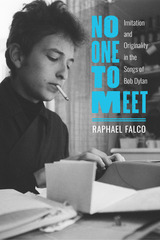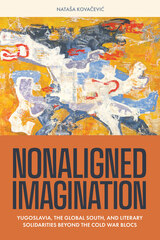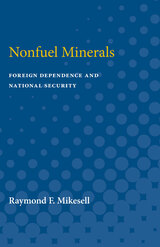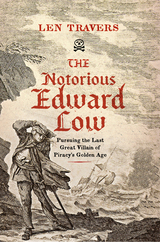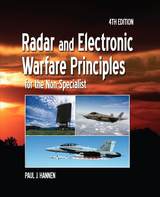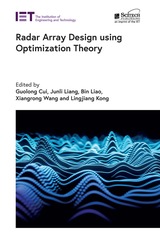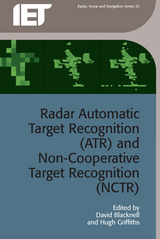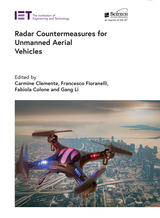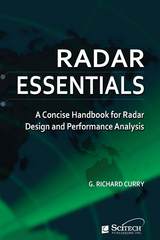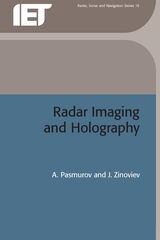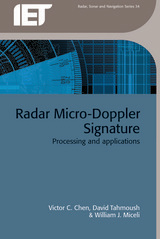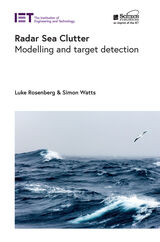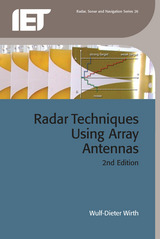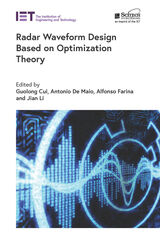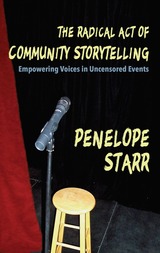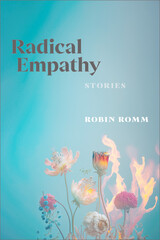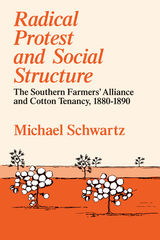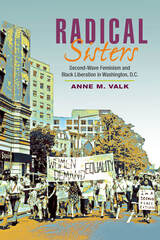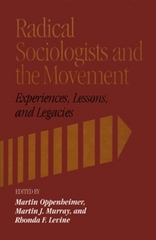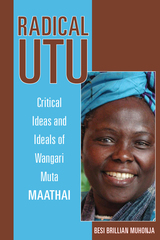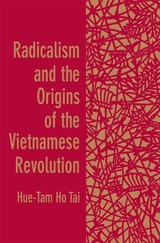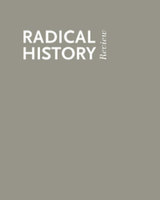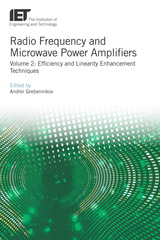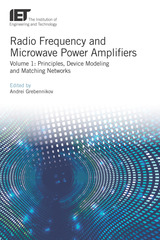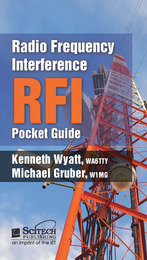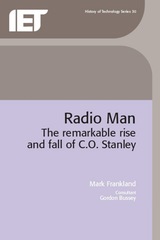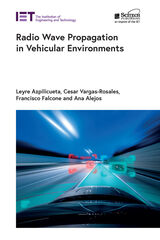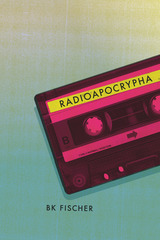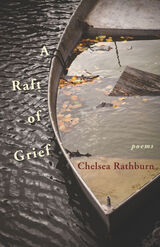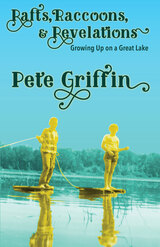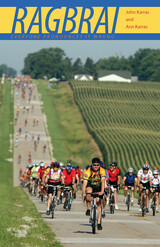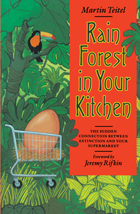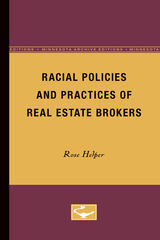 Racial Policies and Practices of Real Estate Brokers
Rose Helper
University of Minnesota Press, 1969
Racial Policies and Practices of Real Estate Brokers was first published in 1969.Dr. Helper, a sociologist, reports on a study which takes a close look at one of the basic problems underlying racial discrimination in housing -- the policies and practices of real estate brokers. She has attempted to find out how real estate men themselves regard their racial practices and to analyze the ideology on which their practices are based.The core of the study is a series of interviews conducted in 1955-1956 with 121 real estate brokers located in three different sections of Chicago and a less extensive follow-up survey made in 1964-1965. In addition to the interviews, she obtained information about the ideology and practices of the Chicago Real Estate Board, as well as the National Association of Real Estate Boards, and about other factors affecting the brokers’ practices, such as the characteristics of the community, the policies of lending agencies, and the sources of potential profit in certain kinds of real estate transactions. She also compared the Chicago data with information about brokers’ practices in other cities of the United States.The study will be of interest to the general public and useful in particular to social scientists, to government agencies concerned with housing or civil rights, and to those in the real estate business, on real estate boards, or in related business or financial enterprises, such as banks and insurance firms.Dr. Joseph D. Lohman, School of Criminology, University of California, Berkeley, says in the foreword: “This study is a significant contribution to the understanding of the increasing influence in our social life of the policies, stratagems, and tactics of deliberately organized interest groups.”
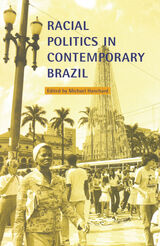 Racial Politics in Contemporary Brazil
Michael Hanchard, ed.
Duke University Press, 1999 Bringing together U.S. and Brazilian scholars, as well as Afro-Brazilian political activists, Racial Politics in Contemporary Brazil represents a significant advance in understanding the complexities of racial difference in contemporary Brazilian society. While previous scholarship on this subject has been largely confined to quantitative and statistical research, editor Michael Hanchard presents a qualitative perspective from a variety of disciplines, including history, sociology, political science, and cultural theory. The contributors to Racial Politics in Contemporary Brazil examine such topics as the legacy of slavery and its abolition, the historical impact of social movements, race-related violence, and the role of Afro-Brazilian activists in negotiating the cultural politics surrounding the issue of Brazilian national identity. These essays also provide comparisons of racial discrimination in the United States and Brazil, as well as an analysis of residential segregation in urban centers and its affect on the mobilization of blacks and browns. With a focus on racialized constructions of class and gender and sexuality, Racial Politics in Contemporary Brazil reorients the direction of Brazilian studies, providing new insights into Brazilian culture, politics, and race relations. This volume will be of importance to a wide cross section of scholars engaged with Brazil in particular, and Latin American studies in general. It will also appeal to those invested in the larger issues of political and social movements centered on the issue of race.
Contributors. Benedita da Silva, Nelson do Valle Silva, Ivanir dos Santos, Richard Graham, Michael Hanchard, Carlos Hasenbalg, Peggy A. Lovell, Michael Mitchell, Tereza Santos, Edward Telles, Howard Winant
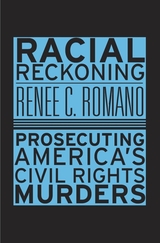 Racial Reckoning: Prosecuting America’s Civil Rights Murders
Renee C. Romano
Harvard University Press, 2014 Few whites who violently resisted the civil rights struggle were charged with crimes in the 1950s and 1960s. But the tide of a long-deferred justice began to change in 1994, when a Mississippi jury convicted Byron De La Beckwith for the 1963 murder of Medgar Evers. Since then, more than one hundred murder cases have been reopened, resulting in more than a dozen trials. But how much did these public trials contribute to a public reckoning with America’s racist past? Racial Reckoning investigates that question, along with the political pressures and cultural forces that compelled the legal system to revisit these decades-old crimes.
“[A] timely and significant work…Romano brilliantly demystifies the false binary of villainous white men like Beckwith or Edgar Ray Killen who represent vestiges of a violent racial past with a more enlightened color-blind society…Considering the current partisan and racial divide over the prosecution of police shootings of unarmed black men, this book is a must-read for historians, legal analysts, and journalists interested in understanding the larger meanings of civil rights or racially explosive trials in America.”
—Chanelle Rose, American Historical Review
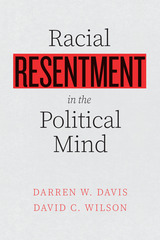 Racial Resentment in the Political Mind
Darren W. Davis and David C. Wilson
University of Chicago Press, 2022 A thought-provoking look at how racial resentment, rather than racial prejudice alone, motivate a growing resistance among whites to improve the circumstances faced by racial minorities.
In Racial Resentment in the Political Mind, Darren W. Davis and David C. Wilson challenge the commonly held notion that all racial negativity, disagreements, and objections to policies that seek to help racial minorities stem from racial prejudice. They argue that racial resentment arises from just-world beliefs and appraisals of deservingness that help explain the persistence of racial inequality in America in ways more consequential than racism or racial prejudice alone.
The culprits, as many White people see it, are undeserving people of color, who are perceived to benefit unfairly from, and take advantage of, resources that come at Whites’ expense—a worldview in which any attempt at modest change is seen as a challenge to the status quo and privilege. Yet, as Davis and Wilson reveal, many Whites have become racially resentful due to their perceptions that African Americans skirt the “rules of the game” and violate traditional values by taking advantage of unearned resources. Resulting attempts at racial progress lead Whites to respond in ways that retain their social advantage—opposing ameliorative policies, minority candidates, and other advancement on racial progress. Because racial resentment is rooted in beliefs about justice, fairness, and deservingness, ordinary citizens, who may not harbor racist motivations, may wind up in the same political position as racists, but for different reasons.
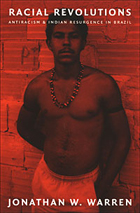 Racial Revolutions: Antiracism and Indian Resurgence in Brazil
Jonathan W. Warren
Duke University Press, 2001 Since the 1970s there has been a dramatic rise in the Indian population in Brazil as increasing numbers of pardos (individuals of mixed African, European, and indigenous descent) have chosen to identify themselves as Indians. In Racial Revolutions—the first book-length study of racial formation in Brazil that centers on Indianness—Jonathan W. Warren draws on extensive fieldwork and numerous interviews to illuminate the discursive and material forces responsible for this resurgence in the population. The growing number of pardos who claim Indian identity represents a radical shift in the direction of Brazilian racial formation. For centuries, the predominant trend had been for Indians to shed tribal identities in favor of non-Indian ones. Warren argues that many factors—including the reduction of state-sponsored anti-Indian violence, intervention from the Catholic church, and shifts in anthropological thinking about ethnicity—have prompted a reversal of racial aspirations and reimaginings of Indianness. Challenging the current emphasis on blackness in Brazilian antiracist scholarship and activism, Warren demonstrates that Indians in Brazil recognize and oppose racism far more than any other ethnic group. Racial Revolutions fills a number of voids in Latin American scholarship on the politics of race, cultural geography, ethnography, social movements, nation building, and state violence. Designated a John Hope Franklin Center book by the John Hope Franklin Seminar Group on Race, Religion, and Globalization.
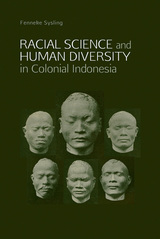 Racial Science and Human Diversity in Colonial Indonesia
Fenneke Sysling
National University of Singapore Press, 2016 Indonesia is home to diverse peoples who differ from one another in terms of physical appearance as well as social and cultural practices. The way such matters are understood is partly rooted in ideas developed by racial scientists working in the Netherlands Indies beginning in the late nineteenth century, who tried to develop systematic ways to define and identify distinctive races. Their work helped spread the idea that race had a scientific basis in anthropometry and craniology, and was central to people’s identity, but their encounters in the archipelago also challenged their ideas about race.
In this new monograph, Fenneke Sysling draws on published works and private papers to describe the way Dutch racial scientists tried to make sense of the human diversity in the Indonesian archipelago. The making of racial knowledge, it contends, cannot be explained solely in terms of internal European intellectual developments. It was ‘on the ground’ that ideas about race were made and unmade with a set of knowledge strategies that did not always combine well. Sysling describes how skulls were assembled through the colonial infrastructure, how measuring sessions were resisted, what role photography and plaster casting played in racial science and shows how these aspects of science in practice were entangled with the Dutch colonial Empire.
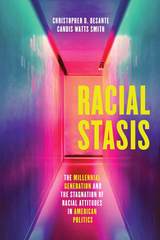 Racial Stasis: The Millennial Generation and the Stagnation of Racial Attitudes in American Politics
Christopher D. DeSante and Candis Watts Smith
University of Chicago Press, 2020 Racial progress in the United States has hit a wall, and the rise of white nationalism is but one manifestation of this. Most Americans continue to hope that the younger generation, which many believe manifests less racism and more acceptance of a multiracial society, will lead to more moderate racial politics—but this may not be happening. Overtly racist attitudes have declined, but anti-black stereotypes and racial resentment remain prevalent among white Americans. To add, the shape of racial attitudes has continued to evolve, but our existing measures have not evolved in step and cannot fully illuminate the challenge at hand.
With Racial Stasis, Christopher D. DeSante and Candis Watts Smith argue persuasively that this is because millennials, a generational cohort far removed from Jim Crow and the Civil Rights era, lack sufficient understanding of the structural nature of racial inequalities in the United States and therefore also the contextual and historical knowledge to be actively anti-racist. While these younger whites may be open to the idea of interracial marriage or living next to a family of a different race, they often do not understand why policies like affirmative action still need to exist and are weary about supporting these kinds of policies. In short, although millennials’ language and rationale around race, racism, and racial inequalities are different from previous generations’, the end result is the same.
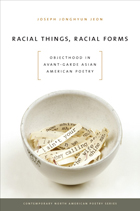 Racial Things, Racial Forms: Objecthood in Avant-Garde Asian American Poetry
Joseph Jonghyun Jeon
University of Iowa Press, 2012 In Racial Things, Racial Forms, Joseph Jonghyun Jeon focuses on a coterie of underexamined contemporary Asian American poets—Theresa Hak Kyung Cha, Myung Mi Kim, Mei-mei Berssenbrugge, and John Yau—who reject many of the characteristics of traditional minority writing, in particular the language of identity politics, which tends to challenge political marginalization without contesting more fundamental assumptions about the construction of racial form. In the poets’ various treatments of things (that is, objects of art), one witnesses a confluence of heretofore discrete factors: the avant-garde interest in objecthood and the racial question of objectification. By refashioning avant-garde investigations of things into questions about how American discourse visualizes race in and on the body, these poets implicitly critique dominant modes of racial visibility, seeking alternatives to the unreflective stances that identity politics often unwittingly reproduces. At the heart of Jeon’s project is the assumption thatracial form is continually recalibrated to elide ideological ambiguities and ambivalences in contemporary culture. Thus, rather than focusing exclusively on the subject—on interiority and individual experience—Racial Things, Racial Forms also uses the calculated strangeness of the avant-garde art object as an occasion to emphasize the physical and visual oddness of racial constructs, as a series of everchanging, contemporary phenomena that are in conversation with, but not entirely determined by, their historical legacy. In this critical study, Jeon argues that by invoking the foreignness of an avant-garde art object as a way to understand racial otherness, these writers model the possibility of a post-identity, racial politics that challenges how race is fundamentally visualized. In addition to appealing to those interested in Asian American studies and race in American literature, Racial Things, Racial Forms addresses readers interested in contemporary poetry, art, and visual culture, paying particular attention to the intersections between literary and visual art.
 Racial Thinking in the United States: Uncompleted Independence
Paul Spickard
University of Notre Dame Press, 2004 Racial Thinking in the United States is a comprehensive reassessment of the ideas that Americans have had about race. This useful book draws on the skills and perspectives of nine scholars from the fields of history, sociology, theology, American studies, and ethnic studies. In thirteen carefully crafted essays they tell the history of the American system of racial domination and of twentieth-century challenges to that racial hierarchy, from monoracial movements to the multiracial movement. The volume provides excellent summaries of historical events and cultural movements, as well as analysis and criticism. It will be a welcome text for undergraduate courses in ethnic studies and American history.
“This collection is stunning. The editors’ introduction offers a superb brief discussion of the meaning of the term “race,” and the essays are vigorous, sophisticated, earnest, interesting, and honest. It ought to be read widely.” —Winthrop D. Jordan, William F. Winter Professor of History and of Afro-American Studies, F.A.P. Barnard Distinguished Professor, University of Mississippi
“This is a splendid book. It should end up as required reading for courses in Ethnic Studies departments.” —Patrick Miller, Northeastern Illinois University
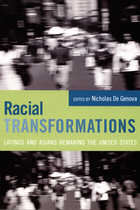 Racial Transformations: Latinos and Asians Remaking the United States
Nicholas De Genova, ed.
Duke University Press, 2006 Moving beyond the black-white binary that has long framed racial discourse in the United States, the contributors to this collection examine how the experiences of Latinos and Asians intersect in the formation of the U.S. nation-state. They analyze the political and social processes that have racialized Latinos and Asians while highlighting the productive ways that these communities challenge and transform the identities imposed on them. Each essay addresses the sociopolitical predicaments of both Latinos and Asians, bringing their experiences to light in relation to one another. Several contributors illuminate ways that Latinos and Asians were historically racialized: by U.S. occupiers of Puerto Rico and the Philippines at the end of the nineteenth century, by public health discourses and practices in early-twentieth-century Los Angeles, by anthropologists collecting physical data—height, weight, head measurements—from Chinese Americans to show how the American environment affected “foreign” body types in the 1930s, and by Los Angeles public officials seeking to explain the alleged criminal propensities of Mexican American youth during the 1940s. Other contributors focus on the coalitions and tensions between Latinos and Asians in the context of the fight to integrate public schools and debates over political redistricting. One addresses masculinity, race, and U.S. imperialism in the literary works of Junot Díaz and Chang-rae Lee. Another looks at the passions, identifications, and charges of betrayal aroused by the sensationalized cases of Elián González, the young Cuban boy rescued off the shore of Florida, and Wen Ho Lee, the Los Alamos physicist accused of spying on the United States. Throughout this volume contributors interrogate many of the assumptions that underlie American and ethnic studies even as they signal the need for a research agenda that expands the purview of both fields. Contributors. Nicholas De Genova, Victor Jew, Andrea Levine, Natalia Molina, Gary Y. Okihiro, Crystal Parikh, Greg Robinson, Toni Robinson, Leland T. Saito
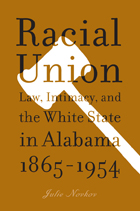 Racial Union: Law, Intimacy, and the White State in Alabama, 1865-1954
Julie Novkov
University of Michigan Press, 2008 In November 2001, the state of Alabama opened a referendum on its long-standing constitutional prohibition against interracial marriage. A bill on the state ballot offered the opportunity to relegate the state's antimiscegenation law to the dustbin of history. The measure passed, but the margin was alarmingly slim: more than half a million voters, 40 percent of those who went to the polls, voted to retain a racist and constitutionally untenable law. Julie Novkov's Racial Union explains how and why, nearly forty years after the height of the civil rights movement, Alabama struggled to repeal its prohibition against interracial marriage---the last state in the Union to do so. Novkov's compelling history of Alabama's battle over miscegenation shows how the fight shaped the meanings of race and state over ninety years. Novkov's work tells us much about the sometimes parallel, sometimes convergent evolution of our concepts of race and state in the nation as a whole. "A remarkably nuanced account of interlocked struggles over race, gender, class and state power. Novkov's site is Alabama, but her insights are for all America."
---Rogers M. Smith, Christopher H. Browne Distinguished Professor of Political Science, University of Pennsylvania "Hannah Arendt shocked Americans in the 1950s by suggesting that interracial intimacy was the true measure of a society's racial order. Julie Novkov's careful, illuminating, powerful book confirms Arendt's judgment. By ruling on who may be sexually linked with whom, Alabama's courts and legislators created a racial order and even a broad political order; Novkov shows us just how it worked in all of its painful, humiliating power."
---Jennifer L. Hochschild, Henry LaBarre Jayne Professor of Government, Professor of African and African American Studies, and Harvard College Professor
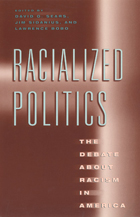 Racialized Politics: The Debate about Racism in America
Edited by David O. Sears, James Sidanius, and Lawrence Bobo
University of Chicago Press, 1999 Are Americans less prejudiced now than they were thirty years ago, or has racism simply gone "underground"? Is racism something we learn as children, or is it a result of certain social groups striving to maintain their privileged positions in society?
In Racialized Politics, political scientists, sociologists, and psychologists explore the current debate surrounding the sources of racism in America. Published here for the first time, the essays represent three major approaches to the topic. The social psychological approach maintains that prejudice socialized early in life feeds racial stereotypes, while the social structural viewpoint argues that behavior is shaped by whites' fear of losing their privileged status. The third perspective looks to non-racially inspired ideology, including attitudes about the size and role of government, as the reason for opposition to policies such as affirmative action. Timely and important, this collection provides a state-of-the-field assessment of the current issues and findings on the role of racism in mass politics and public opinion.
Contributors are Lawrence Bobo, Gretchen C. Crosby, Michael C. Dawson, Christopher Federico, P. J. Henry, John J. Hetts, Jennifer L. Hochschild, William G. Howell, Michael Hughes, Donald R. Kinder, Rick Kosterman, Tali Mendelberg, Thomas F. Pettigrew, Howard Schuman, David O. Sears, James Sidanius, Pam Singh, Paul M. Sniderman, Marylee C. Taylor, and Steven A. Tuch.
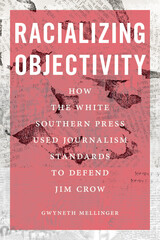 Racializing Objectivity: How the White Southern Press Used Journalism Standards to Defend Jim Crow
Gwyneth Mellinger
University of Massachusetts Press, 2024 Winner of the 2025 American Journalism Historians Association Book of the Year Award
Winner of the 2025 Association for Education in Journalism and Mass Communication (AEJMC)'s Tankard Book Award and the AEJMC's History Division Book Award
When the civil rights movement began to challenge Jim Crow laws, the white southern press reframed the coverage of racism and segregation as a debate over journalism standards. Many white southern editors, for instance, designated Black Americans as “Negro” in news stories, claiming it was necessary for accuracy and “objectivity,” even as white subjects went unlabeled. These news professionals disparaged media outlets that did not adhere to these norms, such as the Black press. In this way, the southern white press weaponized journalism standards—and particularly the idea of objectivity—to counter and discredit reporting that challenged white supremacy.
Through deep engagement with letters and other materials in numerous archives from editors, journalists, and leaders of newswire services, Racializing Objectivity interrogates and exposes how the white southern press used journalism standards as a professional rationalization for white supremacy and a political strategy to resist desegregation. Gwyneth Mellinger argues that white skin privilege gave these news professionals a stake in the racial status quo and was thus a conflict of interest as they defended Jim Crow. Her study includes an examination of the Southern Education Reporting Service, an objectivity project whose impartiality, she contends, instead affirmed systemic racism. In a pointed counternarrative, Mellinger highlights Black editors and academics who long criticized the supposed objectivity of the press and were consequently marginalized and often dismissed as illegitimate, fanciful, and even paranoid.
Elegant and incisive, Racializing Objectivity unequivocally demonstrates that a full telling of twentieth-century press history must reckon with the white southern press’s cooptation of objectivity and other professional standards to skew racial narratives about Black Americans, the freedom struggle, and democracy itself.
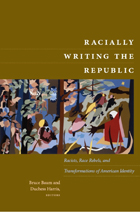 Racially Writing the Republic: Racists, Race Rebels, and Transformations of American Identity
Bruce Baum and Duchess Harris, eds.
Duke University Press, 2009 Racially Writing the Republic investigates the central role of race in the construction and transformation of American national identity from the Revolutionary War era to the height of the civil rights movement. Drawing on political theory, American studies, critical race theory, and gender studies, the contributors to this collection highlight the assumptions of white (and often male) supremacy underlying the thought and actions of major U.S. political and social leaders. At the same time, they examine how nonwhite writers and activists have struggled against racism and for the full realization of America’s political ideals. The essays are arranged chronologically by subject, and, with one exception, each essay is focused on a single figure, from George Washington to James Baldwin. The contributors analyze Thomas Jefferson’s legacy in light of his sexual relationship with his slave, Sally Hemings; the way that Samuel Gompers, the first president of the American Federation of Labor, rallied his organization against Chinese immigrant workers; and the eugenicist origins of the early-twentieth-century birth-control movement led by Margaret Sanger. They draw attention to the writing of Sarah Winnemucca, a Northern Piute and one of the first published Native American authors; the anti-lynching activist Ida B. Wells-Barnett; the Filipino American writer Carlos Bulosan; and the playwright Lorraine Hansberry, who linked civil rights struggles in the United States to anticolonial efforts abroad. Other figures considered include Alexis de Tocqueville and his traveling companion Gustave de Beaumont, Juan Nepomuceno Cortina (who fought against Anglo American expansion in what is now Texas), Abraham Lincoln, Theodore Roosevelt, and W. E. B. Du Bois. In the afterword, George Lipsitz reflects on U.S. racial politics since 1965. Contributors. Bruce Baum, Cari M. Carpenter, Gary Gerstle, Duchess Harris, Catherine A. Holland, Allan Punzalan Isaac, Laura Janara, Ben Keppel, George Lipsitz, Gwendolyn Mink, Joel Olson, Dorothy Roberts, Patricia A. Schechter, John Kuo Wei Tchen, Jerry Thompson
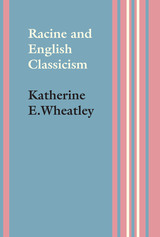 Racine and English Classicism
By Katherine E. Wheatley
University of Texas Press, 1956 Literary historians and critics who have written on the influence of Racine in England during the neoclassical period apparently have assumed that the English translators and adapters of Racine’s plays in general succeeded in presenting the real Racine to the English public. Katherine Wheatley here reveals the wide discrepancy between avowed intentions and actual results. Among the English plays she compares with their French originals are Otway’s Titus and Berenice, Congreve’s The Mourning Bride, and Philips’s The Distrest Mother. These comparisons, fully supported by quoted passages, reveal that those among the English public and contemporary critics who could not themselves read French had no chance whatever to know the real Racine: “The adapters and translators, so-called, had eliminated Racine from his tragedies before presenting them to the public.” Unacknowledged excisions and additions, shifts in plot, changes in dénouement, and frequent mistranslation turned Racine’s plays into “wretched travesties.” Two translations of Britannicus, intended for reading rather than for acting, are especially revealing in that they show which Racinian qualities eluded the British translators even when they were not trying to please an English theatergoing audience. Why it is, asks the author, that no English dramatist could or would present Racine as he is to the English public of the neoclassical period? To answer this question she traces the development of Aristotelian formalism in England, showing the relation of the English theory of tragedy to French classical doctrine and the relation of the English adaptations of Racine to the English neoclassical theory of tragedy. She concludes that “deliberate alterations made by the English, far from violating classical tenets, bring Racine’s tragedies closer to the English neoclassical ideal than they were to begin with, and this despite the fact that some tenets of English doctrine came from parallel tenets widely accepted in France.” She finds that “in the last analysis, French classical doctrine was itself a barrier to the understanding of Racinian tragedy in England and an incentive to the sort of change English translators and adapters made in Racine.” This paradox she explains by the fact that Racine himself had broken with the classical tradition as represented by Corneille.
 Racine: From Ancient Myth to Tragic Modernity
Mitchell Greenberg
University of Minnesota Press, 2009 A study of all of the major tragedies of Jean Racine, France's preeminent dramatist-and, according to many, its greatest and most representative author-Mitchell Greenberg's work offers an exploration of Racinian tragedy to explain the enigma of the plays' continued fascination. Greenberg shows how Racine uses myth, in particular the legend of Oedipus, to achieve his emotional power. In the seventeenth-century tragedies of Racine, almost all references to physical activity were banned from the stage. Yet contemporary accounts of the performances describe vivid emotional reactions of the audiences, who were often reduced to tears. Greenberg demonstrates how Racinian tragedy is ideologically linked to Absolutist France's attempt to impose the "order of the One" on its subjects. Racine's tragedies are spaces where the family and the state are one and the same, with the result that sexual desire becomes trapped in a closed, incestuous, and highly formalized universe. Greenberg ultimately suggests that the politics and sexuality associated with the legend of Oedipus account for our attraction to charismatic leaders and that this confusion of the state with desire explains our continued fascination with these timeless tragedies.
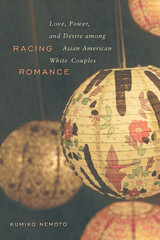 Racing Romance: Love, Power, and Desire among Asian American/White Couples
Nemoto, Kumiko
Rutgers University Press, 2009 Despite being far from the norm, interracial relationships are more popular than ever. Racing Romance sheds special light on the bonds between whites and Asian Americans, an important topic that has not garnered well-deserved attention until now. Incorporating life-history narratives and interviews with those currently or previously involved with an interracial partner, Kumiko Nemoto addresses the contradictions and tensionsùa result of race, class, and genderùthat Asian Americans and whites experience. Similar to black/white relationships, stereotypes have long played crucial roles in Asian American/white encounters. Partners grapple with media representations of Asian women as submissive or hypersexual and Asian men are often portrayed as weak laborers or powerful martial artists. Racing Romance reveals how allegedly progressive interracial relationships remain firmly shaped by the logic of patriarchy and gender inherent to the ideal of marriage, family, and nation in America, even as this ideal is juxtaposed with discourses of multiculturalism and color blindness.
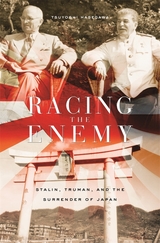 Racing the Enemy: Stalin, Truman, and the Surrender of Japan
Tsuyoshi Hasegawa
Harvard University Press, 2006 With startling revelations, Tsuyoshi Hasegawa rewrites the standard history of the end of World War II in the Pacific. By fully integrating the three key actors in the story—the United States, the Soviet Union, and Japan—Hasegawa for the first time puts the last months of the war into international perspective.
From April 1945, when Stalin broke the Soviet-Japanese Neutrality Pact and Harry Truman assumed the presidency, to the final Soviet military actions against Japan, Hasegawa brings to light the real reasons Japan surrendered. From Washington to Moscow to Tokyo and back again, he shows us a high-stakes diplomatic game as Truman and Stalin sought to outmaneuver each other in forcing Japan’s surrender; as Stalin dangled mediation offers to Japan while secretly preparing to fight in the Pacific; as Tokyo peace advocates desperately tried to stave off a war party determined to mount a last-ditch defense; and as the Americans struggled to balance their competing interests of ending the war with Japan and preventing the Soviets from expanding into the Pacific.
Authoritative and engrossing, Racing the Enemy puts the final days of World War II into a whole new light.
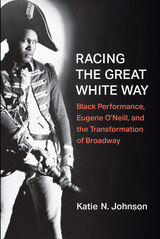 Racing the Great White Way: Black Performance, Eugene O’Neill, and the Transformation of Broadway
Katie N. Johnson
University of Michigan Press, 2023 The early drama of Eugene O’Neill, with its emphasis on racial themes and conflicts, opened up extraordinary opportunities for Black performers to challenge racist structures in modern theater and cinema. By adapting O’Neill’s dramatic writing—changing scripts to omit offensive epithets, inserting African American music and dance, or including citations of Black internationalism--theater artists of color have used O’Neill’s texts to raze barriers in American and transatlantic theater.
Challenging the widely accepted idea that Broadway was the white-hot creative engine of U.S. theater during the early 20th century, author Katie N. Johnson reveals a far more complex system of exchanges between the Broadway establishment and a vibrant Black theater scene in New York and beyond to chart a new history of American and transnational theater. In spite of their dichotomous (and at times problematic) representation of Blackness, O’Neill’s plays such as The Emperor Jones and All God’s Chillun Got Wings make ideal case studies because of the way these works stimulated traffic between Broadway and Harlem—and between white and Black America. These investigations of O’Neill and Broadway productions are enriched by the vibrant transnational exchange found in early to mid-20th century artistic production. Anchored in archival research, Racing the Great White Way recovers not only vital lost performance histories, but also the layered contexts for performing bodies across the Black Atlantic and the Circum-Atlantic.
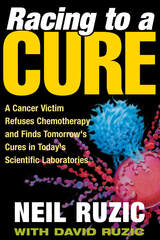 Racing to a Cure: A Cancer Victim Refuses Chemotherapy and Finds Tomorrow's Cures in Today's Scientific Laboratories
Neil Ruzic
University of Illinois Press, 2003 Racing to a Cure is not a cancer memoir. It is a cancer cure memoir. In 1998 Neil Ruzic was diagnosed with mantle-cell lymphoma, the deadliest cancer of the lymph system, whose spread is reaching epidemic levels in the U.S. and Europe. Instead of following recommended courses of chemotherapy and radiation, he took control of his treatment by investigating cures being developed in the nation's cancer-research laboratories. Although chemotherapy harms the immune system and is increasingly demonstrated to be an ineffective long-term cure for the vast majority of cancers, it remains the standard treatment for most cancer patients. Ruzic, a former scientific magazine publisher and originator of a science center, refused to accept this status quo, and instead plunged into the world of cutting-edge treatments, exploring the frontiers of cancer science with revolutionary results. Ruzic went on the offensive: visiting scores of laboratories, gathering information, talking to researchers, and effectively becoming his own patient-care advocate. This book presents his findings. A scathing critique of the chemotherapy culture as well as unscientific "alternative" therapies, the book endorses state-of-the-art molecularly based technologies, making it an illuminating and necessary read for anyone interested in cancer research, especially patients and their families and physicians. Neil Ruzic was expected to die within two years of his initial diagnosis. Five years later he has been declared cancer-free and considers himself cured.
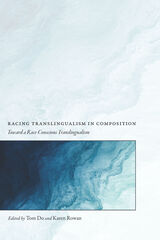 Racing Translingualism in Composition: Toward a Race-Conscious Translingualism
edited by Tom Do and Karen Rowan
Utah State University Press, 2022 Racing Translingualism provides both theoretical and pedagogical reconsiderations of the translingual approach to language diversity by addressing the intersections of race and translingualism. This collection extends the disciplinary conversations about translingualism by foregrounding the role race and racism play in the construction and maintenance of language differences. In doing so, the contributors examine the co-naturalization of race and language in order to theorize a race-conscious translingual praxis. The book begins by offering generative critiques of translingualism, centering on the ways in which the approach’s democratic orientation to language avoids issues of race, language, and power and appeals to colorblind racist tropes of equal opportunity. Following these critiques, contributors demonstrate the important intersections of race and translingualism by drawing upon voices typically marginalized by monolingual language ideologies and pedagogies. Finally, Racing Translingualism concludes by attending to the pedagogical implications of a race-conscious translingual praxis in writing and literacy education. Making the case for race-conscious, rather than colorblind, theories and pedagogies, Racing Translingualism offers a unique take on how translingualism is theorized and practiced and moves the field forward through its direct consideration of the links between language, race, and racism. Contributors: Lindsey Albracht, Steven Alvarez, Bethany Davila, Tom Do, Jaclyn Hilberg, Bruce Horner, Aja Martinez, Esther Milu, Stephanie Mosher, Yasmine Romero, Karen Rowan, Rachael Shapiro, Shawanda Stewart, Brian Stone, Victor Villanueva, Missy Watson
 Racing Uphill: Confronting a Life with Epilepsy
Stacia Kalinoski
University of Minnesota Press, 2025 The candid, inspiring story of a woman’s experience with a chronic, unpredictable neurological condition
When twenty-nine-year-old reporter Stacia Kalinoski regained consciousness on a couch at the TV station where she worked, she assumed that she’d had another seizure. But the electrical storm that had just torn through her brain was more destructive than she could have imagined, and the broadcast journalism career she loved swiftly came to an end. Forced to confront the reality of her medical condition, Kalinoski made the risky decision to undergo brain surgery, targeting the epilepsy that was ravaging her life. In Racing Uphill, Kalinoski describes the seizures that occurred while she was running, which led to her pursuit of an uncertain cure. Rallying the grit she developed as an athlete and engaging the research and reporting skills she acquired as a journalist, she gives us a rare inside look at the ways epilepsy can change a life. Moving beyond her own personal experience, Kalinoski interviews prominent epileptologists to understand how seizures can spread, steal memories, and create strange behaviors and mood disorders. She seamlessly joins what she learned from her research with her own story, offering valuable insight into the experience of grappling with a relentless neurological disease. The vivid auras that preceded seizures and the damage that followed; the toll of her epilepsy on her family and loved ones; the extraordinary determination her reckoning required—these are all part of Kalinoski’s story of adversity, denial, acceptance, and resilience. In sharing the remarkable opportunity that epilepsy presented for her courage and growth, Stacia Kalinoski speaks to anyone facing an uphill battle and offers inspiration for taking control of one’s own health.
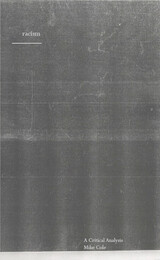 Racism: A Critical Analysis
Mike Cole
Pluto Press, 2015 The book traces the legacy of racism across three continents, from its origins to the present day. With a wide-ranging yet closely-argued style, it brings a sophisticated neo-Marxist analysis to bear on controversial political issues.
Mike Cole tackles three countries in-depth: the United Kingdom, the United States and Australia. In the United Kingdom, he focuses on the effects of colonialism as well as looking at non-colour-coded racism, such as anti-Gipsy, Roma, and Traveller racism and xeno-racism directed at Eastern Europeans. Turning to the United States, Cole charts the dual legacies of indigenous genocide and slavery, as well as exploring anti-Latina/o and anti-Asian racism. Finally, in Australia, he interrogates the idea of "Terra Nullius" and its ongoing impact on the indigenous peoples, as well as other forms of racism, such as that experienced by South Sea Islanders, anti-Asian racism, and that which targets migrants. The Pauline Hanson phenomenon is also addressed. Islamophobia, antisemitism and anti-Irish racism are also dealt with in the book, as is that aimed at asylum-seekers.
Cole demonstrates that racism is both endemic and multifaceted. This book will undoubtedly establish itself as required reading for students and other critical readers looking for a comprehensive, critical overview of the study of racism in Anglophone countries.
 Racism And Anti-Racism In Europe
Alana Lentin
Pluto Press, 2004 This is an in-depth sociological study of the phenomenon of anti-racism, as both political discourse and social movement practice in western Europe. Lentin develops a comparative study of anti-racism in Britain, France, Italy and Ireland. While ‘race’ and racism have been submitted to many profound analyses, anti-racism has often been dealt with as either the mere opposite of racism or as a theme for prescriptives or polemics by those concerned with the persistence of racist discrimination. By contrast, this book views anti-racism as a variety of discourses that are central to the understanding of the politics of modern states. Examining anti-racism gives us insights not only into current debates on citizenship, immigration and Europeanisation, but it also crucially assists us in understanding the nature of race, racism and racialisation themselves. At a time of mounting state racism against asylum seekers, migrants and refugees throughout Europe and beyond, this book provides a much-needed exploration of the discourse of anti-racism that shapes policy and public opinion today.
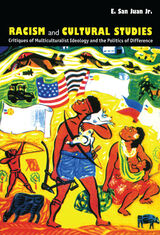 Racism and Cultural Studies: Critiques of Multiculturalist Ideology and the Politics of Difference
E. San Juan Jr.
Duke University Press, 2002 In Racism and Cultural Studies E. San Juan Jr. offers a historical-materialist critique of practices in multiculturalism and cultural studies. Rejecting contemporary theories of inclusion as affirmations of the capitalist status quo, San Juan envisions a future of politically equal and economically empowered citizens through the democratization of power and the socialization of property. Calling U.S. nationalism the new “opium of the masses,” he argues that U.S. nationalism is where racist ideas and practices are formed, refined, and reproduced as common sense and consensus.
Individual chapters engage the themes of ethnicity versus racism, gender inequality, sexuality, and the politics of identity configured with the discourse of postcoloniality and postmodernism. Questions of institutional racism, social justice, democratization, and international power relations between the center and the periphery are explored and analyzed. San Juan fashions a critique of dominant disciplinary approaches in the humanities and social sciences and contends that “the racism question” functions as a catalyst and point of departure for cultural critiques based on a radical democratic vision. He also asks urgent questions regarding globalization and the future of socialist transformation of “third world” peoples and others who face oppression.
As one of the most notable cultural theorists in the United States today, San Juan presents a provocative challenge to the academy and other disciplinary institutions. His intervention will surely compel the attention of all engaged in intellectual exchanges where race/ethnicity serves as an urgent focus of concern.
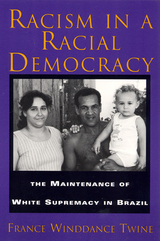 Racism in a Racial Democracy: The Maintenance of White Supremacy in Brazil
Twine, Francine Winddance
Rutgers University Press, 1997 In Racism in a Racial Democracy, France Winddance Twine asks why Brazilians, particularly Afro-Brazilians, continue to have faith in Brazil's "racial democracy" in the face of pervasive racism in all spheres of Brazilian life. Through a detailed ethnography, Twine provides a cultural analysis of the everyday discursive and material practices that sustain and naturalize white supremacy.
This is the first ethnographic study of racism in southeastern Brazil to place the practices of upwardly mobile Afro-Brazilians at the center of analysis. Based on extensive field research and more than fifty life histories with Afro- and Euro-Brazilians, this book analyzes how Brazilians conceptualize and respond to racial disparities. Twine illuminates the obstacles Brazilian activists face when attempting to generate grassroots support for an antiracist movement among the majority of working class Brazilians. Anyone interested in racism and antiracism in Latin America will find this book compelling. "This wonderfully engaging study explodes the myth of racial democracy in a pathbreaking analysis of Brazilian style." -- Karen Brodkin, author of How Jews Became White Folks
"Twine offers one of the most sophisticated analyses to date of the intransigence of Brazilian racism. Her nuanced account of the complex interplay of gender, race, and class is particularly exciting. This book will have a powerful impact not only on the field of Brazilian racial studies, but on the whole burgeoning literature on the African Diaspora." -- Howard Winant, author of Racial Conditions: Politics, Theory, Comparisons
"A revealing and sharply observed dissection of how racism works 'on the ground' in Brazil." -- George Reid Andrews, author of Blacks and Whites in Sao Paulo, Brazil, 1888-1988
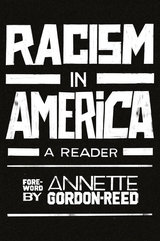 Racism in America: A Reader
Annette Gordon-Reed
Harvard University Press, 2020 Racism in America has been the subject of serious scholarship for decades. At Harvard University Press, we’ve had the honor of publishing some of the most influential books on the subject. The excerpts in this volume—culled from works of history, law, sociology, medicine, economics, critical theory, philosophy, art, and literature—are an invitation to understand anti-Black racism through the eyes of our most incisive commentators.
Readers will find such classic selections as Toni Morrison’s description of the Africanist presence in the White American literary imagination, Walter Johnson’s depiction of the nation’s largest slave market, and Stuart Hall’s theorization of the relationship between race and nationhood. More recent voices include Khalil Gibran Muhammad on the pernicious myth of Black criminality, Elizabeth Hinton on the link between mass incarceration and 1960s social welfare programs, Anthony Abraham Jack on how elite institutions continue to fail first-generation college students, Mehrsa Baradaran on the racial wealth gap, Nicole Fleetwood on carceral art, and Joshua Bennett on the anti-Black bias implicit in how we talk about animals and the environment.
Because the experiences of non-White people are integral to the history of racism and often bound up in the story of Black Americans, we have included writers who focus on the struggles of Native Americans, Latinos, and Asians as well. Racism in America is for all curious readers, teachers, and students who wish to discover for themselves the complex and rewarding intellectual work that has sustained our national conversation on race and will continue to guide us in future years.
 Racism in the Irish Experience
Steve Garner
Pluto Press, 2003 Ireland’s unique position as the only state in the European Union to have been colonised, coupled with the ambivalent experiences of Irish people within the British Empire, means that issues of ‘race’ in Ireland are overlaid by complex social and historical forces.
This book is a unique analysis of the racialisation of Irish identities. The author examines key phases in the historical development of an Irish 'racial' consciousness, including 16th century colonisation and 19th century immigration to America and Great Britain. He then examines the legacy of this relationship, both in terms of the new migration into Ireland and relations with indigenous minorities -- travellers and Irish Jews.
Garner explores the problematic links between nationalist ideologies and racism. He assesses the economic, social and political factors framing the experience of minorities in contemporary Ireland, and places these in a broader European context.
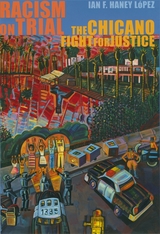 Racism on Trial: The Chicano Fight for Justice
Ian F. Haney López
Harvard University Press, 2004 In 1968, ten thousand students marched in protest over the terrible conditions prevalent in the high schools of East Los Angeles, the largest Mexican community in the United States. Chanting "Chicano Power," the young insurgents not only demanded change but heralded a new racial politics. Frustrated with the previous generation's efforts to win equal treatment by portraying themselves as racially white, the Chicano protesters demanded justice as proud members of a brown race. The legacy of this fundamental shift continues to this day.
Ian Haney López tells the compelling story of the Chicano movement in Los Angeles by following two criminal trials, including one arising from the student walkouts. He demonstrates how racial prejudice led to police brutality and judicial discrimination that in turn spurred Chicano militancy. He also shows that legal violence helped to convince Chicano activists that they were nonwhite, thereby encouraging their use of racial ideas to redefine their aspirations, culture, and selves. In a groundbreaking advance that further connects legal racism and racial politics, Haney López describes how race functions as "common sense," a set of ideas that we take for granted in our daily lives. This racial common sense, Haney López argues, largely explains why racism and racial affiliation persist today.
By tracing the fluid position of Mexican Americans on the divide between white and nonwhite, describing the role of legal violence in producing racial identities, and detailing the commonsense nature of race, Haney López offers a much needed, potentially liberating way to rethink race in the United States.
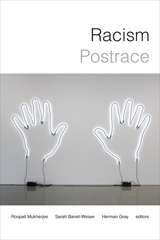 Racism Postrace
Roopali Mukherjee, Sarah Banet-Weiser, and Herman Gray, editors
Duke University Press, 2019 With the election of Barack Obama, the idea that American society had become postracial—that is, race was no longer a main factor in influencing and structuring people's lives—took hold in public consciousness, increasingly accepted by many. The contributors to Racism Postrace examine the concept of postrace and its powerful history and allure, showing how proclamations of a postracial society further normalize racism and obscure structural antiblackness. They trace expressions of postrace over and through a wide variety of cultural texts, events, and people, from sports (LeBron James's move to Miami), music (Pharrell Williams's “Happy”), and television (The Voice and HGTV) to public policy debates, academic disputes, and technology industries. Outlining how postrace ideologies confound struggles for racial justice and equality, the contributors open up new critical avenues for understanding the powerful cultural, discursive, and material conditions that render postrace the racial project of our time.
Contributors. Inna Arzumanova, Sarah Banet-Weiser, Aymer Jean Christian, Kevin Fellezs, Roderick A. Ferguson, Herman Gray, Eva C. Hageman, Daniel Martinez HoSang, Victoria E. Johnson, Joseph Lowndes, Roopali Mukherjee, Safiya Umoja Noble, Radhika Parameswaran, Sarah T. Roberts, Catherine R. Squires, Brandi Thompson Summers, Karen Tongson, Cynthia A. Young
 Racism, Xenophobia, and Distribution: Multi-Issue Politics in Advanced Democracies
John E. Roemer, Woojin Lee, and Karine Van der Straeten
Harvard University Press, 2007 From the Republican Party's "Southern Strategy" in the U.S. to the rise of Le Pen's National Front in France, conservative politicians in the last thirty years have capitalized on voters' resentment of ethnic minorities to win votes and undermine government aid to the poor. In this book, the authors construct a theoretical model to calculate the effect of voters' attitudes about race and immigration on political parties' stances on income distribution.
Drawing on empirical data from the U.S., Britain, Denmark, and France, they use their model to show how parties choose their platforms and compete for votes. They find that the Right is able to push fiscal policies that hurt working and middle class citizens by attracting voters who may be liberal on economic issues but who hold conservative views on race or immigration. The authors estimate that if all voters held non-racist views, liberal and conservative parties alike would have proposed levels of redistribution 10 to 20 percent higher than they did. Combining historical analysis and empirical rigor with major theoretical advances, the book yields fascinating insights into how politicians exploit social issues to advance their economic agenda.
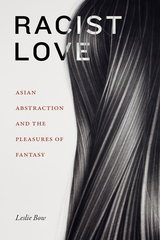 Racist Love: Asian Abstraction and the Pleasures of Fantasy
Leslie Bow
Duke University Press, 2022 In Racist Love Leslie Bow traces the ways in which Asian Americans become objects of anxiety and desire. Conceptualizing these feelings as “racist love,” she explores how race is abstracted and then projected onto Asianized objects. Bow shows how anthropomorphic objects and images such as cartoon animals in children’s books, home décor and cute tchotchkes, contemporary visual art, and artificially intelligent robots function as repositories of seemingly positive feelings and attachment to Asianness. At the same time, Bow demonstrates that these Asianized proxies reveal how fetishistic attraction and pleasure serve as a source of anti-Asian bias and violence. By outlining how attraction to popular representations of Asianness cloaks racial resentment and fears of globalization, Bow provides a new means of understanding the ambivalence surrounding Asians in the United States while offering a theory of the psychological, affective, and symbolic dynamics of racist love in contemporary America.
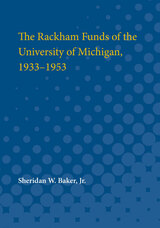 Rackham Funds of the University of Michigan, 1933-1953
Sheridan W. Baker, Jr.
University of Michigan Press, 1955 Two decades have now passed since the Horace H. Rackham funds were so generously given to the University of Michigan. In keeping with the vision and the wishes of the donors, the funds have been dedicated to significant cultural and humanitarian interests; to the aid of productive scholars and of selected students of high capacity; and to the research programs of the University centering in the Horace H. Rackham School of Graduate Studies.This book was specially prepared to tell the story of the Rackham funds, to set forth the specific accomplishments and results of the beneficence, and, as it were, to account for twenty years of responsible stewardship in discharging this trust.The University of Michigan is a stronger institution because of this support, and with these additional resources has been able to make a far richer contribution in the service of mankind than it could otherwise have done.—Harlan Hatcher, 1955
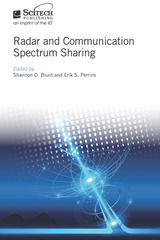 Radar and Communication Spectrum Sharing
Shannon D. Blunt
The Institution of Engineering and Technology, 2019 Radar and Communication Spectrum Sharing addresses the growing conflict over use of the radio-frequency spectrum by different systems, such as civil and security applications of radar and consumer use for wireless communications. The increasing demand for this finite resource is driving innovation into new ways in which these diverse systems can cohabit the spectrum. The book provides a broad survey of recent and ongoing work on the topic of spectrum sharing, with an emphasis on identifying the technology gaps for practical realization and the regulatory and measurement compliance aspects of this problem space. The introductory section sets the scene, making the case for spectrum access and reviewing spectrum use, congestion, lessons learned, ways forward and research areas. The book then covers system engineering perspectives, the issues involved with addressing interference, and radar/communication co-design strategies. With contributions from an international panel of experts, this book is essential reading for researchers, engineers and advanced students in radar, communications, navigation, and electronic warfare whose work is impacted by spectrum engineering requirements.
Radar Array Design using Optimization Theory
Guolong Cui
The Institution of Engineering and Technology, 2024 Radar array design aims at shaping a specific transmit/receive beampattern through optimizing array geometry, transmit waveform, and transmit/receive weight vectors. It is a hot topic among the scientific and industrial communities due to the advent of modern digital arrays with multiple digital transmit and receive channels, arbitrary digital waveform generators, and solid-state transmitters. The radar array beampattern is a critical performance metric, and there has been a proliferation of techniques for radar array design exploiting the mathematical results drawn from optimisation theory.
Radar Automatic Target Recognition (ATR) and Non-Cooperative Target Recognition (NCTR)
David Blacknell
The Institution of Engineering and Technology, 2013 The ability to detect and locate targets by day or night, over wide areas, regardless of weather conditions has long made radar a key sensor in many military and civil applications. However, the ability to automatically and reliably distinguish different targets represents a difficult challenge. Radar Automatic Target Recognition (ATR) and Non-Cooperative Target Recognition (NCTR) captures material presented in the NATO SET-172 lecture series to provide an overview of the state-of-the-art and continuing challenges of radar target recognition.
Radar Countermeasures for Unmanned Aerial Vehicles
Carmine Clemente
The Institution of Engineering and Technology, 2021 Over the last ten years, the numbers of unmanned air vehicles (UAVs) or “drones” have changed from being just a few specialist systems, used for scientific data gathering and military purposes, to them proliferating in huge numbers. They are used across a broad range of different leisure, commercial and military activities. UAVs can be used for: movement of items in factories for manufacturing, passenger and freight transportation, can take various roles in the agriculture and forestry industries (dispensing seeds, watering and monitoring crops), remote sensing for the oil and gas industries, traffic flow monitoring, support of emergency services, hobbies, security, military and many other applications.
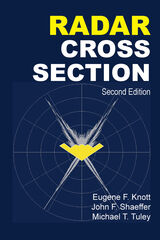 Radar Cross Section
Eugene F. Knott
The Institution of Engineering and Technology, 2004 Radar cross section (RCS) is a comparison of two radar signal strengths. One is the strength of the radar beam sweeping over a target, the other is the strength of the reflected echo sensed by the receiver. This book shows how the RCS gauge can be predicted for theoretical objects and how it can be measured for real targets. Predicting RCS is not easy, even for simple objects like spheres or cylinders, but this book explains the two exact forms of theory so well that even a novice will understand enough to make close predictions. Weapons systems developers are keenly interested in reducing the RCS of their platforms. The two most practical ways to reduce RCS are shaping and absorption. This book explains both in great detail, especially in the design, evaluation, and selection of radar absorbers. There is also great detail on the design and employment of indoor and outdoor test ranges for scale models or for full-scale targets (such as aircraft). In essence, this book covers everything you need to know about RCS, from what it is, how to predict and measure, and how to test targets (indoors and out), and how to beat it.
 Radar Detection
Julius V. DiFranco
The Institution of Engineering and Technology, 2004 This book presents a comprehensive tutorial exposition of radar detection using the methods and techniques of mathematical statistics. The material presented is as current and useful to today's engineers as when the book was first published by Prentice-Hall in 1968 and then republished by Artech House in 1980. The book is divided into six parts. Part I is introductory and describes the nature of the radar detection problem. Part II reviews the mathematical tools necessary for a study of detection theory. Part III contains tutorial expositions in a radar context of the classical signal-to-noise and a posteriori theories, both of which have played important roles in the evolution of modern radar. The unifying theme of the book is provided by statistical decision theory, introduced in the last chapter of Part III, which provides the framework for the chapters that follow. The first three chapters of Part IV contain a unified tutorial exposition of single and multiple hit detection theory. The last two chapters are respectively devoted to the use of the radar equation and a discussion of cumulative detection probability. The latter includes a procedure for minimizing the power-aperture product of a search radar. The performance of near-optimum multiple hit detection strategies are considered in Part V. These include binary and pulse train detection strategies. The first chapter in Part VI applies sequential detection theory to the radar detection problem. It includes the Marcus and Swerling test strategy and a two-step approximation to sequential detection. The second chapter contains the development of Bayes decision rules and Bayes receivers for optimizing the detection of multiple targets with unknown parameters, such as range, velocity, angle, etc.
Radar Essentials: A concise handbook for radar design and performance analysis
G. Richard Curry
The Institution of Engineering and Technology, 2012 When you need vital data fast, turn to Radar Essentials. This compact yet comprehensive reference has compiled the most used principles, data, tables, and equations that are used by radar and aerospace system designers on a daily basis. Experts and non-experts alike will find this to be their go-to source for recalling and understanding the fundamentals and employing them in design and performance analysis.
Radar Essentials: A concise handbook for radar design and performance analysis
G. Richard Curry
The Institution of Engineering and Technology, 2025 To meet the need for a compendium of radar information essential for design and performance analysis, a book should combine elements of both a radar text and a handbook. Radar Essentials, 2nd Edition: A concise handbook for radar design and performance analysis delivers on this requirement: it contains the radar principles, data, and equations most useful for practicing radar engineers and also material to help those who are not radar experts understand and use the information. The book is comprehensive, and serves as a complete radar reference, yet compact enough to fit on an engineer's desk or travel with them.
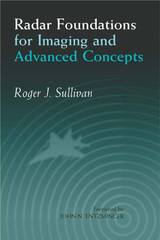 Radar Foundations for Imaging and Advanced Concepts
Roger J. Sullivan
The Institution of Engineering and Technology, 2004 Through courses taught internally at the Institute for Defense Analysis, Dr. Roger Sullivan has devised a book that brings readers fully up to speed on the most essential quantitative aspects of general radar in order to introduce study of the most exciting and relevant applications to radar imaging and advanced concepts: Synthetic Aperture Radar (4 chapters), Space-time Adaptive Processing, moving target indication (MTI), bistatic radar, low probability of intercept (LPI) radar, weather radar, and ground-penetrating radar. Whether you are a radar novice or experienced professional, this is an essential reference that features the theory and practical application of formulas you use in radar design every day. With this book, you are taken step-by-step through the development of modern airborne microwave radar, up to the cutting edge of emergent technologies including new results on theoretical 2D and 3D SAR point-spread functions (PSF) and current discussions concerning dechirp/deskew processing, layover in SAR images, vibrating targets, foliage penetration, image quality parameters, and more. Plus, for students of electrical engineering, physics, and radar, this book provides the best source of basic airborne radar understanding, as well as a broad introduction to the field of radar imaging.
Radar Imaging and Holography
A. Pasmurov
The Institution of Engineering and Technology, 2005 Increasing information content is an important scientific problem in modern observation systems development. Radar, or microwave, imaging, a technique which combines radar techniques with digital or optical information processing, can be used for this purpose. Drawing on their own research, the authors provide an overview of the field and explain why a unified approach based on wave field processing techniques, including holographic and tomographic approaches, is necessary in high resolution radar design. Such techniques use the complex field incident on an observation surface to produce a hologram, which can be used to reconstruct an image of the object or to restore some of its physical parameters. This makes it possible to extract the size, coordinates and radar cross-section of individual scattering centres.
Radar Micro-Doppler Signatures: Processing and applications
Victor C. Chen
The Institution of Engineering and Technology, 2014 The micro-Doppler effect appears as Doppler frequency modulations in coherent laser or microwave radar systems induced by mechanical vibrations or rotations of a target or any part on the target. These Doppler modulations become a distinctive signature of a target that incorporates vibrating or rotating structures, and provides evidence of the identity of the target with movement.
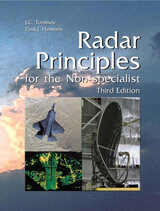 Radar Principles for the Non-Specialist
J.C. Toomay
The Institution of Engineering and Technology, 2004 Radar Principles for the Non-specialist, 3rd Edition continues its popular tradition: to distil the very complex technology of radar into its fundamentals, tying them to the laws of nature on one end and to the most modern and complex systems on the other. It starts with electromagnetic propagation, describes a radar of the utmost simplicity, and derives the radar range equation from that simple radar. Once the radar range equation is available, the book attacks the meaning of each term in it, moving through antennas, detection and tracking, radar cross-sections, waveforms and signal processing, and systems applications. At the finish, the reader should be able to do an acceptable, first order radar design and to critique the design of others. Students, engineers, scientists and managers will benefit from this book. The more noticeable enhancements to the third edition are the additions of equation numbers, more numerical examples, tables and figures showing many of the concepts numerically, and exercises for almost all of the concepts. These enhancements make the book easier to learn from and easier to teach out of.
Radar Sea Clutter: Modelling and target detection
Luke Rosenberg
The Institution of Engineering and Technology, 2022 The first maritime surveillance radars in World War II quickly discovered that returns from the sea, soon to be known as sea clutter, were often the limiting factor when attempting to detect small targets while controlling false alarms. This remains true for modern radars, where the detection of small, slow moving targets on a rough sea surface remains one of the main drivers for maritime radar design, particularly in the development of detection processing.
 Radar Techniques Using Array Antennas
Wulf-Dieter Wirth
The Institution of Engineering and Technology, 2001 This book presents a unique and comprehensive introduction to modern radar techniques using array antennas. The author focuses upon the principles, system concepts and techniques using electronic steerable and active array antennas for future high standard multifunction radar systems in both military and civil applications. Signal processing and array antennas are discussed from an engineering perspective, as a basis for system design. The key areas covered include array signal processing, adaptive digital beamforming, adaptive monopulse, superresolution, sequential detection, SAR with an active array for moving target detection, target imaging, adaptive clutter suppression, pulse compression with low range sidelobes and high range resolution, target detection with long pulse series, energy management and system parameter relations. Several new and effective radar techniques using array antennas are also discussed based on the pioneering work conducted by the authors team at FGAN, complete with experimental simulation results. The book will prove useful for engineers and scientists who work on research, development and systems design in the radar field as well as those who are responsible for radar decision making and planning within the government or industry.
Radar Techniques Using Array Antennas
Wulf-Dieter Wirth
The Institution of Engineering and Technology, 2013 Radar Techniques Using Array Antennas is a thorough introduction to the possibilities of radar technology based on electronic steerable and active array antennas.
Radar Waveform Design based on Optimization Theory
Guolong Cui
The Institution of Engineering and Technology, 2020 This book provides an overview of radar waveform synthesis obtained as the result of computational optimization processes and covers the most challenging application fields. The book balances a practical point of view with a rigorous mathematical approach corroborated with a wealth of numerical study cases and some real experiments. Additionally, the book has a cross-disciplinary approach because it exploits cross-fertilization with the recent research and discoveries in optimization theory. The material of the book is organized into ten chapters, each one completed with a comprehensive list of references.
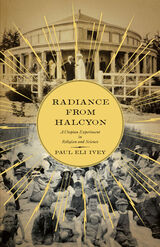 Radiance from Halcyon: A Utopian Experiment in Religion and Science
Paul Eli Ivey
University of Minnesota Press, 2013
In May 1904, the residents of Halcyon—a small utopian community on California’s central coast—invited their neighbors to attend the grand opening of the Halcyon Hotel and Sanatorium. As part of the entertainment, guests were encouraged to have their hands X-rayed. For the founders and members of Halcyon, the X-ray was a demonstration of mysterious spiritual forces made practical to human beings.
Radiance from Halcyon is the story not only of the community but also of its uniquely inventive members’ contributions to religion and science. The new synthesis of religion and science attempted by Theosophy laid the foundation for advances produced by the children of the founding members, including microwave technology and atomic spectral analysis. Paul Eli Ivey’s narrative starts in the 1890s in Syracuse, New York, with the rising of the Temple of the People, a splinter group of the theosophical movement. After developing its ideals for an agricultural and artisanal community, the Temple purchased land in California and in 1903 began to live its dream there. In addition to an intriguing account of how a little-known utopian religious community profoundly influenced modern science, Ivey offers a wide-ranging cultural history, encompassing Theosophy, novel healing modalities, esoteric architecture, Native American concepts of community, socialist utopias, and innovative modern music.
The Radiant
Lise Goett
Tupelo Press, 2024 Poems about celestial and mortal bodies.
The Radiant explores the psychological, physical, and spiritual challenges of living in a body and the changes and distortions that arise from the experience of the body’s limitations and inevitable death. The collection takes its title from the term for the point from which all meteors appear to emanate during a shower, luminous bodies in decay that when traced to their origin seem to converge at a single point. “Perhaps you can remember the time called before, the all-you-can-do-is-see-yourself-in-a-split-second where you recognize that everything you’ve ever known is going to be different after,” writes Goett in the collection’s final poem, “The Bookman,” recounting radiant points of no return and transformation that, in spite of their challenge, remain luminous.
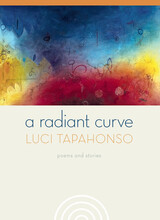 A Radiant Curve: Poems and Stories
Luci Tapahonso
University of Arizona Press, 2008 In this sixth collection of stories and verse, award-winning writer Luci Tapahonso finds sacredness in everyday life. Viewing a sunset in a desert sky, listening to her granddaughter recount how she spent her day, or visiting her mother after her father's passing, she finds traces of her own memories, along with echoes of the voices of her Navajo ancestors. The collection also includes an audio CD of the author reading aloud and her voice is warm and inviting, like the “simmering soup and blue corn meal” of her childhood.
These engaging words draw us into a workaday world that, magically but never surprisingly, has room for the Diyin Dine’é (the Holy People), Old Salt Woman, and Dawn Boy. When she describes her grandson’s First Laugh Ceremony—explaining that it was originally performed for White Shell Girl, who grew up to be Changing Woman—her account enriches us and we long to hear more. Tapahonso weaves the Navajo language into her work like she weaves “the first four rows of black yarn” into a rug she is making “for my little grandson, who inherited my father’s name: Hastiin Tsétah Naaki Bísóí.”
As readers, we find that we too are surrounded by silent comfort, held lovingly in the confident hands of an accomplished writer who has a great deal to tell us about life.
 Radiant Daughter: A Novel
Patricia Grossman
Northwestern University Press, 2010 In Radiant Daughter, award-winning novelist Patricia Grossman follows a Czech-American family for twenty-seven years, beginning in suburban Chicago in 1969 and ending in Brooklyn, in seaside “Little Odessa,” in 1996. Though the novel begins as a traditional assimilation story— immigrant parents, “native” children, and the conflicts one might expect— it evolves into a highly particular and harrowing tale surrounding the descent of Elise Blazek, the family’s brightest star. Radiant Daughter is also a story of translation—between generations, from the Czech of Irena and Stepan, to the “American” of the children, and finally to the Russian that is Elise’s academic specialty. Radiant Daughter explores all that is human, from the most self- destructive behavior to the highest forms of commitment and self- sacrifice. Even at her lowest moments, Irena never loses her fierce love for the daughter who has traveled so utterly beyond her reach. For Elise, the future will always be complicated: a precarious balance between periods of insight, bursts of accomplishment, and the abyss of her illness. Reminiscent, on the one hand, of the meticulously constructed mother-daughter dynamic in Carol Shields’s Unless and, on the other, of the anarchic real-life experience of Big and Little Edie Beale in Grey Gardens, Grossman’s moving narrative breaks new ground in exploring a dangerous turn in the complex bond between a mother and her adult child.
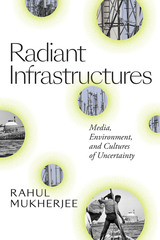 Radiant Infrastructures: Media, Environment, and Cultures of Uncertainty
Rahul Mukherjee
Duke University Press, 2020 In Radiant Infrastructures Rahul Mukherjee explores how the media coverage of nuclear power plants and cellular phone antennas in India—what he calls radiant infrastructures—creates environmental publics: groups of activists, scientists, and policy makers who use media to influence public opinion. In documentaries, lifestyle television shows, newspapers, and Bollywood films, and through other forms of media (including radiation-sensing technologies), these publics articulate contesting views about the relationships between modernity, wireless signals, and nuclear power. From testimonies of cancer patients who live close to cell towers to power plant operators working to contain information about radiation leaks and health risks, discussions in the media show how radiant infrastructures are at once harbingers of optimism about India's development and emitters of potentially carcinogenic radiation. In tracing these dynamics, Mukherjee expands understandings of the relationship between media and infrastructure and how people make sense of their everyday encounters with technology and the environment.
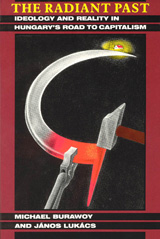 The Radiant Past: Ideology and Reality in Hungary's Road to Capitalism
Michael Burawoy and János Lukács
University of Chicago Press, 1992 Communism, once heralded as the "radiant future" of all humanity, has now become part of Eastern Europe's past. What does the record say about the legacy of communism as an organizational system?
Michael Burawoy and Janos Lukacs consider this question from the standpoint of the Hungarian working class. Between 1983 and 1990 the authors carried out intensive studies in two core Hungarian industries, machine building and steel production, to produce the first extended participant-observation study of work and politics in state socialism.
"A fascinating and engagingly written eyewitness report on proletarian life in the waning years of goulash communism. . . . A richly rewarding book, one that should interest political scientists in a variety of subfields, from area specialists and comparativists to political economists, as well as those interested in Marxist and post-Marxist theory."—Elizabeth Kiss, American Political Science Review
"A very rich book. . . . It does not merely offer another theory of transition, but also presents a clear interpretive scheme, combined with sociological theory and vivid ethnographic description."—Ireneusz Bialecki, Contemporary Sociology
"Its informed skepticism of post-Communist liberal euphoria, its concern for workers, and its fine ethnographic details make this work valuable."—"àkos Róna-Tas, American Journal of Sociology
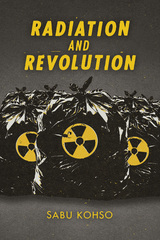 Radiation and Revolution
Sabu Kohso
Duke University Press, 2020 In Radiation and Revolution political theorist and anticapitalist activist Sabu Kohso uses the 2011 Fukushima nuclear disaster to illuminate the relationship between nuclear power, capitalism, and the nation-state. Combining an activist's commitment to changing the world with a theorist's determination to grasp the world in its complexity, Kohso outlines how the disaster is not just a pivotal event in postwar Japan; it represents the epitome of the capitalist-state mode of development that continues to devastate the planet's environment. Throughout, he captures the lived experiences of the disaster's victims, shows how the Japanese government's insistence on nuclear power embodies the constitution of its regime under the influence of US global strategy, and considers the future of a radioactive planet driven by nuclearized capitalism. As Kohso demonstrates, nuclear power is not a mere source of energy—it has become the organizing principle of the global order and the most effective way to simultaneously accumulate profit and govern the populace. For those who aspire to a world free from domination by capitalist nation-states, Kohso argues, the abolition of nuclear energy and weaponry is imperative.
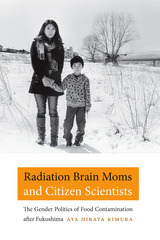 Radiation Brain Moms and Citizen Scientists: The Gender Politics of Food Contamination after Fukushima
Aya Hirata Kimura
Duke University Press, 2016 Following the Fukushima Daiichi Nuclear Power Plant disaster in 2011 many concerned citizens—particularly mothers—were unconvinced by the Japanese government’s assurances that the country’s food supply was safe. They took matters into their own hands, collecting their own scientific data that revealed radiation-contaminated food. In Radiation Brain Moms and Citizen Scientists Aya Hirata Kimura shows how, instead of being praised for their concern about their communities’ health and safety, they faced stiff social sanctions, which dismissed their results by attributing them to the work of irrational and rumor-spreading women who lacked scientific knowledge. These citizen scientists were unsuccessful at gaining political traction, as they were constrained by neoliberal and traditional gender ideologies that dictated how private citizens—especially women—should act. By highlighting the challenges these citizen scientists faced, Kimura provides insights into the complicated relationship between science, foodways, gender, and politics in post-Fukushima Japan and beyond.
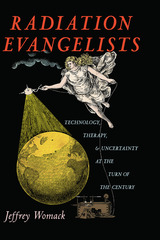 Radiation Evangelists: Technology, Therapy, and Uncertainty at the Turn of the Century
Jeffrey Womack
University of Pittsburgh Press, 2020 Radiation Evangelists explores X-ray and radium therapy in the United States and Great Britain during a crucial period of its development, from 1896 to 1925. It focuses on the pioneering work of early advocates in the field, the “radiation evangelists” who, motivated by their faith in a new technology, trust in new energy sources, and hope for future breakthroughs, turned a blind eye to the dangers of radiation exposure. Although ionizing radiation effectively treated diseases like skin infections and cancers, radiation therapists—who did not need a medical education to develop or administer procedures or sell tonics containing radium—operated in a space of uncertainty about exactly how radiation worked or would affect human bodies. And yet radium, once a specialized medical treatment, would eventually become a consumer health product associated with the antibacterial properties of sunlight.
This book raises important questions about medical experimentation and the so-called Golden Rule of medical ethics, issues of safety and professional identity, and the temptation of a powerful therapeutic tool that also posed significant risks in its formative years. In this cautionary tale of technological medical progress, Jeffrey Womack reveals how practitioners and their patients accepted uncertainty as a condition of their therapy in an attempt to alleviate human suffering.
 Radiation Protection: A Guide for Scientists, Regulators, and Physicians, Fourth Edition
Jacob Shapiro
Harvard University Press, 2002 This highly successful manual has served for nearly three decades as the definitive guide to the safe use of radioactive materials. Completely revised and updated, the fourth edition presents a new dimension by adding coverage of nonionizing radiation, and is thus concerned with the entire field of radiation protection.
The author takes the novel approach of introducing the whole range of energies possessed by particles and electromagnetic waves at the beginning of the text, thus integrating coverage of ionizing and nonionizing radiation rather than considering them as two separate disciplines. He goes on to cover the entire spectrum of radiation sources, including radionuclides, x-ray machines, accelerators, nuclear reactors, power lines, microwave towers, and cellular phones.
With its expanded coverage, including a broader focus on public health issues, this new volume will serve as an important training and reference resource, not only for research scientists, physicians, and engineers, but for regulatory officials, attorneys, engineers, and environmental health and safety professionals. The breadth of citations alone makes this resource invaluable.
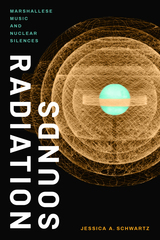 Radiation Sounds: Marshallese Music and Nuclear Silences
Jessica A. Schwartz
Duke University Press, 2021 On March 1, 1954, the US military detonated “Castle Bravo,” its most powerful nuclear bomb, at Bikini Atoll in the Marshall Islands. Two days later, the US military evacuated the Marshallese to a nearby atoll where they became part of a classified study, without their consent, on the effects of radiation on humans. In Radiation Sounds Jessica A. Schwartz examines the seventy-five years of Marshallese music developed in response to US nuclear militarism on their homeland. Schwartz shows how Marshallese singing draws on religious, cultural, and political practices to make heard the deleterious effects of US nuclear violence. Schwartz also points to the literal silencing of Marshallese voices and throats compromised by radiation as well as the United States’ silencing of information about the human radiation study. By foregrounding the centrality of the aural and sensorial in understanding nuclear testing’s long-term effects, Schwartz offers new modes of understanding the relationships between the voice, sound, militarism, indigeneity, and geopolitics.
The Radical Act of Community Storytelling: Empowering Voices in Uncensored Events
Penelope Starr
Parkhurst Brothers, Inc., 2017 The Radical Act of Community Storytelling is everything it claims in the title. It is the story of a radical step of faith taken by Penelope Starr to open her life by bringing community storytelling to her community. It is the story of voices that often go unheard having the opportunity to speak and be heard. And it is about community building from start to finish ... including everything any radical would need to start a community storytelling organization in any community.
—Adam Hostetter, Adult literacy educator, writer, and community storytelling producer
Radical Advocate: Ida B. Wells and the Road to Race and Gender Justice
Mary E. Triece
University of Alabama Press, 2025 Radical Advocate offers a compelling rhetorical analysis of Ida B. Wells’s groundbreaking activism, revealing how her journalism and speeches challenged the systemic racism, gender oppression, and economic control of the Jim Crow era. Mary E. Triece introduces the concept of “radical embodied advocacy” to show how Wells’s lived experiences as a Black woman shaped her powerful critiques of white violence and injustice. Through intersectional journalism and fearless public engagement, Wells emerges as a prophetic figure whose strategies remain urgently relevant in today’s fight for equity.
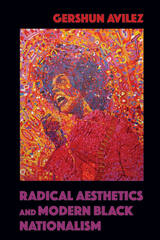 Radical Aesthetics and Modern Black Nationalism
GerShun Avilez
University of Illinois Press, 2016 Radical Aesthetics and Modern Black Nationalism explores the long-overlooked links between black nationalist activism and the renaissance of artistic experimentation emerging from recent African American literature, visual art, and film. GerShun Avilez charts a new genealogy of contemporary African American artistic production that illuminates how questions of gender and sexuality guided artistic experimentation in the Black Arts Movement from the mid-1960s to the mid-1970s. As Avilez shows, the artistic production of the Black Arts era provides a set of critical methodologies and paradigms rooted in the disidentification with black nationalist discourses. Avilez's close readings study how this emerging subjectivity, termed aesthetic radicalism, critiqued nationalist rhetoric in the past. It also continues to offer novel means for expressing black intimacy and embodiment via experimental works of art and innovative artistic methods. A bold addition to an advancing field, Radical Aesthetics and Modern Black Nationalism rewrites recent black cultural production even as it uncovers unexpected ways of locating black radicalism.
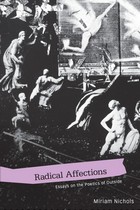 Radical Affections: Essays on the Poetics of Outside
Miriam Nichols
University of Alabama Press, 2011 A study of six poets central to the New American poetry—Charles Olson, Robert Creeley, Robert Duncan, Jack Spicer, Robin Blaser, and Susan Howe—with an eye both toward challenging the theoretical lenses through which they have been viewed and to opening up this counter tradition to contemporary practice
In 1950 the poet Charles Olson published his influential essay “Projective Verse” in which he proposed a poetry of “open field” composition—to replace traditional closed poetic forms with improvised forms that would reflect exactly the content of the poem. The poets and poetry that have followed in the wake of the “projectivist” movement—the Black Mountain group, the New York School, the San Francisco Renaissance, and the Language poets—have since been studied at length. But more often than not they have been studied through the lens of continental theory with the effect that these highly propositional, pragmatic, and adaptable forms of verse were interpreted in very cramped, polemical ways. Miriam Nichols highlights many of the impulses original to the thinking and methods of each poet: appeals to perceptual experience, spontaneity, renewed relationships with nature, engaging the felt world—what Nichols terms a “poetics of outside”—focusing squarely on experiences beyond the self-regarding self. As Nichols states, these poets may well “represent the last moment in recent cultural history when a serious poet could write from perception or pursue a visionary poetics without irony or quotation marks and expect serious intellectual attention.”
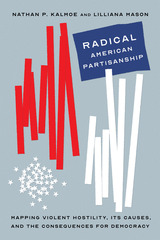 Radical American Partisanship: Mapping Violent Hostility, Its Causes, and the Consequences for Democracy
Nathan P. Kalmoe and Lilliana Mason
University of Chicago Press, 2022 Radical partisanship among ordinary Americans is rising, and it poses grave risks for the prospects of American democracy.
Political violence is rising in the United States, with Republicans and Democrats divided along racial and ethnic lines that spurred massive bloodshed and democratic collapse earlier in the nation’s history. The January 6, 2021 insurrection and the partisan responses that ensued are a vivid illustration of how deep these currents run. How did American politics become so divided that we cannot agree on how to categorize an attack on our own Capitol?
For over four years, through a series of surveys and experiments, Nathan P. Kalmoe and Lilliana Mason have been studying radicalism among ordinary American partisans. In this groundbreaking book, they draw on new evidence—as well as insights from history, psychology, and political science—to put our present partisan fractiousness in context and to explain broad patterns of political and social change. Early chapters reveal the scope of the problem, who radical partisans are, and trends over time, while later chapters identify the conditions that partisans say justify violence and test how elections, political violence, and messages from leaders enflame or pacify radical views. Kalmoe and Mason find that ordinary partisanship is far more dangerous than pundits and scholars have recognized. However, these findings are not a forecast of inevitable doom; the current climate also brings opportunities to confront democratic threats head-on and to create a more inclusive politics. Timely and thought-provoking, Radical American Partisanship is vital reading for understanding our current political landscape.
 Radical Arab Nationalism and Political Islam
Lahouari Addi. Anthony Roberts, Translator
Georgetown University Press, 2017 In Radical Arab Nationalism and Political Islam, Lahouari Addi attempts to assess the history and political legacy of radical Arab nationalism to show that it contained the seeds of its own destruction. While the revolutionary regimes promised economic and social development and sought the unity of Arab nations, they did not account for social transformations, such as freedom of speech, that would eventually lead to their decline. But while radical Arab nationalism fell apart, authoritarian populism did not disappear. Today it is expressed by political Islam that aims to achieve the kind of social justice radical Arab nationalism once promised. Addi creatively links the past and present while also raising questions about the future of Arab countries. Is political Islam the heir of radical Arab nationalism? If political Islam succeeds, will it face the same challenges faced by radical Arab nationalism? Will it be able to implement modernity? The future of Arab countries, Addi writes, depends on this crucial issue. Published in collaboration with Center for Contemporary Arab Studies, Georgetown University.
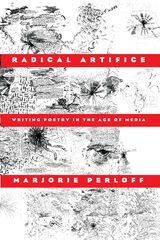 Radical Artifice: Writing Poetry in the Age of Media
Marjorie Perloff
University of Chicago Press, 1992 How the negotiation between poetic and media discourses takes place is the subject of Marjorie Perloff's groundbreaking study. Radical Artifice considers what happens when the "natural speech" model inherited from the great Modernist poets comes up against the "natural speech" of the Donahue "talk show," or again, how visual poetics and verse forms are responding to the languages of billboards and sound bytes. Among the many poets whose works are discussed are John Ashbery, George Oppen, Susan Howe, Clark Coolidge, Lyn Hejinian, Leslie Scalapino, Charles Bernstein, Johanna Drucker, and Steve McCaffery. But the strongest presence in Perloff's book is John Cage, a "poet" better known as a composer, a philosopher, a printmaker, and one who understood, almost half a century ago, that from now on no word, musical note, painted surface, or theoretical statement could ever again escape "contamination" from the media landscape in which we live. It is under his sign that Radical Artifice was composed.
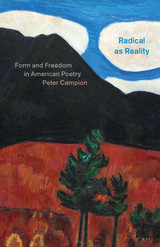 Radical as Reality: Form and Freedom in American Poetry
Peter Campion
University of Chicago Press, 2019 What do American poets mean when they talk about freedom? How can form help us understand questions about what shapes we want to give our poetic lives, and how much power we have to choose those shapes? For that matter, what do we even mean by we? In this collection of essays, Peter Campion gathers his thoughts on these questions and more to form an evolutionary history of the past century of American poetry.
Through close readings of the great modernists, midcentury objectivists, late twentieth-century poets, his contemporaries, and more, Campion unearths an American poetic landscape that is subtler and more varied than most critics have allowed. He discovers commonalities among poets considered opposites, dramatizes how form and history are mutually entailing, and explores how the conventions of poetry, its inheritance, and its inventions sprang from the tensions of ordinary life. At its core, this is a book about poetic making, one that reveals how the best poets not only receive but understand and adapt what comes before them, reinterpreting the history of their art to create work that is, indeed, radical as reality.
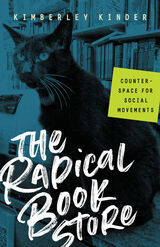 The Radical Bookstore: Counterspace for Social Movements
Kimberley Kinder
University of Minnesota Press, 2021 Examines how radical bookstores and similar spaces serve as launching pads for social movements
How does social change happen? It requires an identified problem, an impassioned and committed group, a catalyst, and a plan. In this deeply researched consideration of seventy-seven stores and establishments, Kimberley Kinder argues that activists also need autonomous space for organizing, and that these spaces are made, not found. She explores the remarkably enduring presence of radical bookstores in America and how they provide infrastructure for organizing—gathering places, retail offerings that draw new people into what she calls “counterspaces.” Kinder focuses on brick-and-mortar venues where owners approach their businesses primarily as social movement tools. These may be bookstores, infoshops, libraries, knowledge cafes, community centers, publishing collectives, thrift stores, or art installations. They are run by activist-entrepreneurs who create centers for organizing and selling books to pay the rent. These spaces allow radical and contentious ideas to be explored and percolate through to actual social movements, and serve as crucibles for activists to challenge capitalism, imperialism, white privilege, patriarchy, and homophobia. They also exist within a central paradox: participating in the marketplace creates tensions, contradictions, and shortfalls. Activist retail does not end capitalism; collective ownership does not enable a retreat from civic requirements like zoning; and donations, no matter how generous, do not offset the enormous power of corporations and governments. In this timely and relevant book, Kinder presents a necessary, novel, and apt analysis of the role these retail spaces play in radical organizing, one that demonstrates how such durable hubs manage to persist, often for decades, between the spikes of public protest.
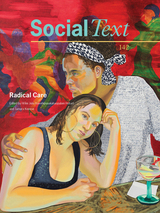 Radical Care
Hi'iliei Hobart and Tamara Kneese, special issue editors
Duke University Press Care has re-entered the zeitgeist. In the aftermath of the 2016 U.S. presidential election, #selfcare exploded across media platforms. Beyond this popular focus on self-care rituals, care has also emerged as a driving force within new collective movements. Situating discussions of care within a historical trajectory of feminist, queer, and Black activism, contributors to this special issue consider how individuals and communities receive and provide care in order to survive in environments that challenge their very existence. They explore how trans activists find resilience and vitality through coalitional labor; argue that social movements should expand mutual aid strategies, focusing on solidarity over charity; discuss a neoliberal university wellness culture that seeks to patch up structural care deficits with quick fixes like meditation apps and yoga classes; and more. As the traditionally undervalued labor of caring becomes recognized as a key element of survival, contributors show how radical care provides a roadmap for not only enduring precarious worlds but also envisioning new futures. In the face of state-sanctioned violence, economic crisis, and impending ecological collapse, collective care offers a way forward.
Contributors. Nicole Charles, Elijah Adiv Edelman, Hi‘ilei Hobart, Tamara Kneese, Micki McGee, Leyla Savloff, Cotten Seiler, Dean Spade
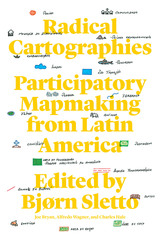 Radical Cartographies: Participatory Mapmaking from Latin America
Edited by Bjørn Sletto, Joe Bryan, Alfredo Wagner, and Charles Hale
University of Texas Press, 2020 Cartography has a troubled history as a technology of power. The production and distribution of maps, often understood to be ideological representations that support the interests of their developers, have served as tools of colonization, imperialism, and global development, advancing Western notions of space and place at the expense of Indigenous peoples and other marginalized communities. But over the past two decades, these marginalized populations have increasingly turned to participatory mapping practices to develop new, innovative maps that reassert local concepts of place and space, thus harnessing the power of cartography in their struggles for justice. In twelve essays written by community leaders, activists, and scholars, Radical Cartographies critically explores the ways in which participatory mapping is being used by Indigenous, Afro-descendant, and other traditional groups in Latin America to preserve their territories and cultural identities. Through this pioneering volume, the authors fundamentally rethink the role of maps, with significant lessons for marginalized communities across the globe, and launch a unique dialogue about the radical edge of a new social cartography.
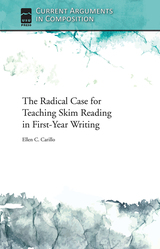 The Radical Case for Teaching Skim Reading in First-Year Writing
Ellen C. Carillo
Utah State University Press, 2025 The Radical Case for Teaching Skim Reading in First-Year Writing encourages faculty, particularly in writing studies, to check internal biases toward deep reading and teach skim reading in first-year writing courses. Written by Ellen C. Carillo, who has previously published on the importance of teaching deep reading, this small book is a controversial prompt for further discussion and exploration.
Data from studies of the lived experiences of undergraduates indicate that students do not need deep reading practices in the majority of their classes across the disciplines and, moreover, that students succeed in their classes by skim reading. Rather than imagining an idealized set of circumstances that allow for sustained deep reading, as does a great deal of the scholarship on reading in writing studies, The Radical Case for Teaching Skim Reading in First-Year Writing argues for teaching students reading practices that will support their success in their college writing assignments rather than those strategies the field believes should support their success.
In our information landscape and our fragile democracy, encouraging skimming as opposed to deep reading may seem like a gamble—this very tendency toward the quick rather than the critical has undoubtedly contributed to the current crisis of mass misinformation. However, teaching students to use skim reading as a strategic tool for purposeful engagement and efficient yet thoughtful information filtering better equips them to navigate the rapidly changing information landscape and manage the fast-paced flow of content from diverse media sources.
 The Radical Center: Middle Americans and the Politics of Alienation
Donald Warren
University of Notre Dame Press, 1976 There is now compelling evidence that a new phenomenon, the Radical Center, has emerged as a unique political and social reality in America. The truckers’ strike, the Boston anti-bussing protest, and the West Virginia textbook controversy provide vivid confirmation that a growing number of Middle Americans are no longer willing to suffer political frustration and social alienation in silence.
Under particular sets of conditions, the Radical Center is an explosive political force which can erupt in different geographical settings and over seemingly unrelated issues. Unlike others in the ‘silent majority’ who are relatively secure, silent, and politically independent in their paradoxical blending of left and right attitudes. Their ideology has deep roots in society and thus they appear to be reactionary. However, they see themselves as being in the tradition of defending individual rights against oppressive and arbitrary policies.
Drawing in extensive research and national survey data, sociologist Donald I. Warren here presents an in-depth analysis of the Middle American Radicals, who they are, what they believe, the major targets of their grievances, and the likelihood of their political mobilization. The evidence indicates that as many as one in five Americans shares the Radical Center perspective, including people who outwardly seem to have very little in common by way of economic, occupational, or education status. Of particular significance are the findings concerning potential support for the various presidential candidates and for a third national political party.
Avoiding the pitfalls of viewing Middle American radicalism as either an intransigently conservative, proto-fascist danger, or as well-spring of democratic populism, Warren discusses reforms and new approaches with which governmental agencies, labor unions, churches, and other organizations can reduce Middle American alienation. He suggests the possibility of new and powerful alliances between the poor, the Radical Center, and the well-educated which could bring about major social reforms. Whatever the political future of the Radical Center, it is a force which can no longer be ignored.
This book is a mine of social research and an indispensable tool for anyone wishing to take the pulse of contemporary America.
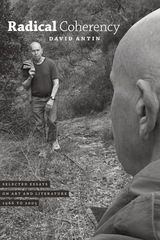 Radical Coherency: Selected Essays on Art and Literature, 1966 to 2005
David Antin
University of Chicago Press, 2011 “We got to talking”—so David Antin begins the introduction to Radical Coherency, embarking on the pursuit that has marked much of his breathless, brilliantly conversational work. For the past forty years, whether spoken under the guise of performance artist or poet, cultural explorer or literary critic, Antin’s innovative observations have helped us to better understand everything from Pop to Postmodernism.
Intimately wedded to the worlds of conceptual art and poetics, Radical Coherency collects Antin’s influential critical essays and spontaneous, performed lectures (or “talk pieces”) for the very first time, capturing one of the most distinctive perspectives in contemporary literature. The essays presented here range from the first serious assessment of Andy Warhol published in a major art journal, as well as Antin’s provocative take on Clement Greenberg’s theory of Modernism, to frontline interventions in present debates on poetics and fugitive pieces from the ’60s and ’70s that still sparkle today—and represent a gold mine for art historians of the period. From John Cage to Allan Kaprow, Mark Rothko to Ludwig Wittgenstein, Antin takes the reader on an idiosyncratic, personal journey through twentieth-century culture with his trademark antiformalist panache—one thatwill be welcomed by any fan of this consummate trailblazer.
 Radical Collections: Re-examining the roots of collections, practices and information professions
Edited by Jordan Landes
University of London Press, 2018 Available as free PDF download at http://humanities-digital-library.org/index.php/hdl/catalog/book/radical_collections Do archivists ‘curate’ history? And to what extent are our librarians the gatekeepers of knowledge? Libraries and archives have a long and rich history of compiling ‘radical collections’- from Klanwatch Project in the States to the R. D. Laing Archive in Glasgow- but a re-examination of the information professions and all aspects of managing those collections is long overdue. This book is the result of a critical conference held at Senate House Library in 2017. The conference provided a space to debate the issues and ethics of collection development, management and promotion. This book brings together some key papers from those proceedings. It shines a light on pressing topical issues within library and information services (LIS)- to encompass selection, appraisal and accession, through to organisation and classification, and including promotion and use. Will libraries survive as victims of neoliberal marketization? Do we have a responsibility to collect and document ‘white hate’ in the era of Trump? And how can a predominantly white (96.7%) LIS workforce effectively collect and tell POC histories?
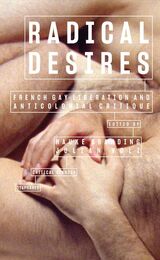 Radical Desires: French Gay Liberation and Anticolonial Critique
Edited by Hauke Branding and Julian Volz
Diaphanes, 2025 An intersectional approach to the radicality of desire.
Despite a historically rich tradition of thinking about the relation between sexuality, desire, and revolution, there is little engagement with desire’s radicality today. This volume attends to the radicality of desire as a starting point for overcoming heteropatriarchal capitalism by turning to the specific radical homosexual critique as it was first formulated in France in the 1970s in the writings of the Mouvement de Libération des Femmes and the Front Homosexuel d’Action Révolutionnaire, as well as in the conceptions of their most important protagonists, Monique Wittig and Guy Hocquenghem.
Radical Desires seeks to emphasize the anti-identitarian character of the French gay liberation movement, as well as its implicit and explicit critique of gender and sexual binaries. At the same time, the volume is also interested in intersectionally expanding this critique by confronting it with anticolonial and queer of color perspectives. As French gay liberation activists’ relations to North African men were often problematic, several contributions engage with the latent orientalist and racist tropes that appear in the movement’s writings. By aiming to go beyond a mere historicization of these ambivalences and exploring which contemporary problems appear in a different light as a result, Radical Desires highlights the (dis-)continuous relationship between current debates and those in 1970s France.
To explore the multiplicity of forms with or in which these critiques were expressed, this volume places theoretical perspectives in conversation with artistic perspectives on queer liberation in a transnational context. Contributors include Friederike Beier, Antoine Idier, Émilie Notéris, Lukas Betzler, Mohammad Shawky Hassan, Sido Lansari, Todd Shepard, and Julian Volz.
Radical Empathy
Robin Romm
Four Way Books, 2024 In this new collection of short stories that Ben Fountain declares “all marvels,” Robin Romm (author of The Mercy Papers) revels in the mess behind the slick veneer of modern life. A financially-strapped college student sells her sought after “Ivy League eggs” to a movie star, then wrestles with her feelings as the child grows up in the public eye. A long-married wife in the midst of a bungled kitchen remodel imagines the excitement of her neighbor’s unstable erotic life. Isolated by quarantine, a young widow contends with a talking daffodil that panders to her in therapy-speak. Disquieting, original and strangely reassuring, these ten new stories make quick work of the easy truths and thoughtless salvos that keep us from seeing the wildness of our irreducible lives.
 Radical Endurance: Growing Old in an Age of Longevity
gil
University of Minnesota Press, 2024 A personal guide to the transformations, hard truths, profound pleasures, and infinite possibilities of aging
One May morning shortly before her seventy-fifth birthday, Andrea Gilats awoke to a startling, sudden spike in consciousness that she was about to leap from older to old. Radical Endurance is the story of the reckoning that followed, a candid, clear-eyed journey of discovery through the pitfalls and possibilities of aging. Facing the realities of her age, Gilats explores her fears of failing health and loss of independence while navigating the terrain of an ageist culture. But among such troubling uncertainties, she also encounters the singular pleasures of “growing up again,” of finding fresh and unexpected ways of understanding herself and making meaning during this new era of her life. Reflecting on moments in midlife, from the painful adjustments of widowhood to life-altering medical diagnoses, Gilats arrives at a valuable insight: the journey toward old age begins sooner and lasts longer than we might imagine. Yet from any moment in this process, old age is the future, brimming with potential. In her account, Gilats combines personal and professional experience, offering firsthand knowledge of a stage of life that we each meet in our own time, in our own way. She also contributes the learning and wisdom of her heroes and mentors, including feminist author Barbara Ehrenreich, poet May Sarton, singer and activist Joan Baez, psychiatrist Gene Cohen, archaeologist Arthur C. Parker, physician Jane Hodgson, and Nobel literature laureate Isaac Bashevis Singer. Enlightening and deeply moving, alive to the sadness and joy of time passing, Radical Endurance is a guide and a companion through the experience of growing old as well as an unconventional coming-of-age story, celebrating a new stage of life when we need it most. Retail e-book files for this title are screen-reader friendly.
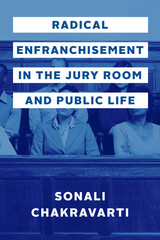 Radical Enfranchisement in the Jury Room and Public Life
Sonali Chakravarti
University of Chicago Press, 2020 Juries have been at the center of some of the most emotionally charged moments of political life. At the same time, their capacity for legitimate decision making has been under scrutiny, because of events like the acquittal of George Zimmerman by a Florida jury for the shooting of Trayvon Martin and the decisions of several grand juries not to indict police officers for the killing of unarmed black men. Meanwhile, the overall use of juries has also declined in recent years, with most cases settled or resolved by plea bargain.
With Radical Enfranchisement in the Jury Room and Public Life, Sonali Chakravarti offers a full-throated defense of juries as a democratic institution. She argues that juries provide an important site for democratic action by citizens and that their use should be revived. The jury, Chakravarti argues, could be a forward-looking institution that nurtures the best democratic instincts of citizens, but this requires a change in civic education regarding the skills that should be cultivated in jurors before and through the process of a trial. Being a juror, perhaps counterintuitively, can guide citizens in how to be thoughtful rule-breakers by changing their relationship to their own perceptions and biases and by making options for collective action salient, but they must be better prepared and instructed along the way.
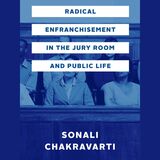 Radical Enfranchisement in the Jury Room and Public Life
Sonali Chakravarti
University of Chicago Press, 2020 This is an auto-narrated audiobook edition of this book. Juries have been at the center of some of the most emotionally charged moments of political life. At the same time, their capacity for legitimate decision making has been under scrutiny, because of events like the acquittal of George Zimmerman by a Florida jury for the shooting of Trayvon Martin and the decisions of several grand juries not to indict police officers for the killing of unarmed black men. Meanwhile, the overall use of juries has also declined in recent years, with most cases settled or resolved by plea bargain.
With Radical Enfranchisement in the Jury Room and Public Life, Sonali Chakravarti offers a full-throated defense of juries as a democratic institution. She argues that juries provide an important site for democratic action by citizens and that their use should be revived. The jury, Chakravarti argues, could be a forward-looking institution that nurtures the best democratic instincts of citizens, but this requires a change in civic education regarding the skills that should be cultivated in jurors before and through the process of a trial. Being a juror, perhaps counterintuitively, can guide citizens in how to be thoughtful rule-breakers by changing their relationship to their own perceptions and biases and by making options for collective action salient, but they must be better prepared and instructed along the way.
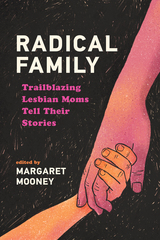 Radical Family: Trailblazing Lesbian Moms Tell Their Stories
Edited by Margaret Mooney
Wisconsin Historical Society Press, 2025 A powerful collection of personal essays from lesbian moms who fought for the right to raise children
For generations, lesbians across the United States were systematically denied opportunities to raise children and build families, opportunities that were readily available to straight people. Radical Family honors the history-making struggles and triumphs of lesbian families in Madison, Wisconsin, who raised children in the 1980s, ’90s, and early 2000s—a time when lesbian motherhood was widely considered extreme and unnatural. In a collection of nine profoundly personal essays, the contributors recount their diverse paths to parenthood, as well as the hopes and challenges each family experienced. While the stories in Radical Family are unique, they all share a common thread: the mothers’ resilience and the risks they took, both small and sweeping, to defend their family’s right to exist. For lesbians, the desire to raise children has historically been met with vilification and legal and social prejudice. Adoption agencies consistently rejected applications from out lesbians. Doctors and clinics refused to provide fertility treatments and other medical options to help them get pregnant. Lesbians who were able to raise children commonly lost custody to estranged spouses or grandparents. Trailblazing lesbian mothers—and their children—fought to defy and, ultimately, shift this paradigm. Lesbian parents, like those in Radical Family, created informal networks in their local communities, where they could share survival strategies and find acceptance among other families that looked like theirs. With no rule book to guide them, and few laws to protect them, lesbian mothers created a new—some might even say radical—standard for what it means to be a family. Over and over, the stories in Radical Family show how families fought back against hatred and homophobia with love, resilience, commitment, and creativity. Their stories deepen our understanding of what it means to be a mother—while showing how safety, belonging, and acceptance are universal human needs.
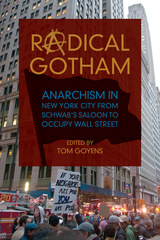 Radical Gotham: Anarchism in New York City from Schwab's Saloon to Occupy Wall Street
Edited by Tom Goyens
University of Illinois Press, 2017 New York City's identity as a cultural and artistic center, as a point of arrival for millions of immigrants sympathetic to anarchist ideas, and as a hub of capitalism made the city a unique and dynamic terrain for anarchist activity. For 150 years, Gotham's cosmopolitan setting created a unique interplay between anarchism's human actors and an urban space that invites constant reinvention. Tom Goyens gathers essays that demonstrate anarchism's endurance as a political and cultural ideology and movement in New York from the 1870s to 2011. The authors cover the gamut of anarchy's emergence in and connection to the city. Some offer important new insights on German, Yiddish, Italian, and Spanish-speaking anarchists. Others explore anarchism's influence on religion, politics, and the visual and performing arts. A concluding essay looks at Occupy Wall Street's roots in New York City's anarchist tradition. Contributors: Allan Antliff, Marcella Bencivenni, Caitlin Casey, Christopher J. Castañeda, Andrew Cornell, Heather Gautney, Tom Goyens, Anne Klejment, Alan W. Moore, Erin Wallace, and Kenyon Zimmer.
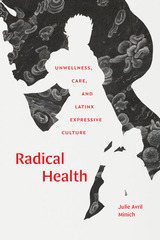 Radical Health: Unwellness, Care, and Latinx Expressive Culture
Julie Avril Minich
Duke University Press, 2023 In Radical Health Julie Avril Minich examines the potential of Latinx expressive culture to intervene in contemporary health politics, elaborating how Latinx artists have critiqued ideologies of health that frame wellbeing in terms of personal behavior. Within this framework, poor health—obesity, asthma, diabetes, STIs, addiction, and high-risk pregnancies—is attributed to irresponsible lifestyle choices among the racialized poor. Countering this, Latinx writers and visual artists envision health not as individual duty but as communal responsibility. Bringing a disability justice approach to questions of health access and equity, Minich locates a concept of radical health within the work of Latinx artists, including the poetry of Rafael Campo, the music of Hurray for the Riff Raff, the fiction of Angie Cruz, and the performance art of Virginia Grise. Radical health operates as a modality that both challenges the stigma of unhealth and protests the social conditions that give rise to racial health disparities. Elaborating on this modality, Minich claims a critical role for Latinx artists in addressing the structural racism in public health.
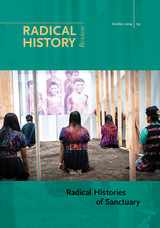 Radical Histories of Sanctuary
A. Naomi Paik, Jason Ruiz, and Rebecca Schreiber, special issue editors
Duke University Press, 2019 In “Radical Histories of Sanctuary,” contributors explore both contemporary and historical invocations of “sanctuary,” paying particular attention to its genealogies in social movements against state violence. Expanding the scope of sanctuary, they address not only immigrant activism but also topics such as indigenous strategies of survival in the Americas, gay liberation in rural spaces, and urban housing for refugees. The essays contest liberal conventions of sanctuary that shore up the very forms of power and subjugation they seek to dismantle: from immigrant movements affirming the distinction between “good” and “bad” immigrants to gay liberation movements for police reform that fail to address the fundamental violence of policing. Examining both the liberatory potential of sanctuary and its limits, the contributors argue for intersectional strategies of resistance that connect the struggles of disparate groups against repressive and violent power.
Contributors. Rachel Ida Buff, Caleb Duarte, Treva Ellison, Jason Ezell, Carla Hung, Kyle B. T. Lambelet, Sunaina Maira, Rachel McIntire, A. Naomi Paik, Jason Ruiz, Rebecca M. Schreiber, Aimee Villarreal, Elliot Young
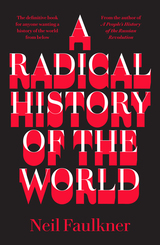 A Radical History of the World
Neil Faulkner
Pluto Press, 2018
“Staggeringly ambitious.”―New Internationalist
“One of the finest historians on the left.”—John Newsinger, author, The Blood Never Dried
Rejecting the top-down approach of conventional history, Neil Faulkner contends that it is the mass action of ordinary people that drives the transformative events of our many histories. This is a history of power, abuse, and greed, but also one of liberation, progress, and solidarity.
From the hunter-gatherers two million years ago to the ancient empires of Persia and China, and from the Russian Revolution to modern imperialism, humans have always struggled to create a better society than what came before. All over the world at numerous points in the past, a different way of life has become an absolute necessity, over and over again. This is a history of the humans in these struggles—the hominid and the hunter, the emperor and the slave, the dictator and the revolutionary.
Reading against the grain of mainstream histories, Neil Faulkner reveals that what happened in the past has never been predetermined. From antiquity to feudalism, and from fascism to our precarious political present, choices have always been numerous and complex, and the possible outcomes have ranged broadly between liberation and barbarism. His chapters include:
*Hunters and Farmers
*The First Class Societies
*Ancient Empires
*The Medieval World
*European Feudalism
*The First Wave of Bourgeois Revolutions
*Absolutist Europe and Capitalist Globalization
*The Rise of Industrial Capitalism
*The Revolutionary Wave
*The Great Depression and the Rise of Fascism
*World War and Cold War
*The New World Disorder
*Capitalism’s Greatest Crisis? The Early Twenty-First Century
In our fraught political present—as we face the loss of civil liberties and environmental protections, the rise of ethnonationalism, and the looming threat of nuclear war—we need the perspective of these histories now more than ever. The lesson of A Radical History of the World is that, if we created our past, we can also create a better future.
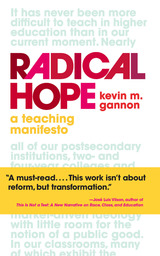 Radical Hope: A Teaching Manifesto
Kevin M. Gannon
West Virginia University Press, 2020 Higher education has seen better days. Harsh budget cuts, the precarious nature of employment in college teaching, and political hostility to the entire enterprise of education have made for an increasingly fraught landscape. Radical Hope is an ambitious response to this state of affairs, at once political and practical—the work of an activist, teacher, and public intellectual grappling with some of the most pressing topics at the intersection of higher education and social justice. Kevin Gannon asks that the contemporary university’s manifold problems be approached as opportunities for critical engagement, arguing that, when done effectively, teaching is by definition emancipatory and hopeful. Considering individual pedagogical practice, the students who are the primary audience and beneficiaries of teaching, and the institutions and systems within which teaching occurs, Radical Hope surveys the field, tackling everything from impostor syndrome to cell phones in class to allegations of a campus “free speech crisis.” Throughout, Gannon translates ideals into tangible strategies and practices (including key takeaways at the conclusion of each chapter), with the goal of reclaiming teachers’ essential role in the discourse of higher education.
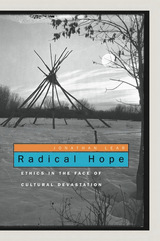 Radical Hope: Ethics in the Face of Cultural Devastation
Jonathan Lear
Harvard University Press, 2006 Shortly before he died, Plenty Coups, the last great Chief of the Crow Nation, told his story—up to a certain point. “When the buffalo went away the hearts of my people fell to the ground,” he said, “and they could not lift them up again. After this nothing happened.” It is precisely this point—that of a people faced with the end of their way of life—that prompts the philosophical and ethical inquiry pursued in Radical Hope. In Jonathan Lear’s view, Plenty Coups’s story raises a profound ethical question that transcends his time and challenges us all: how should one face the possibility that one’s culture might collapse?
This is a vulnerability that affects us all—insofar as we are all inhabitants of a civilization, and civilizations are themselves vulnerable to historical forces. How should we live with this vulnerability? Can we make any sense of facing up to such a challenge courageously? Using the available anthropology and history of the Indian tribes during their confinement to reservations, and drawing on philosophy and psychoanalytic theory, Lear explores the story of the Crow Nation at an impasse as it bears upon these questions—and these questions as they bear upon our own place in the world. His book is a deeply revealing, and deeply moving, philosophical inquiry into a peculiar vulnerability that goes to the heart of the human condition.
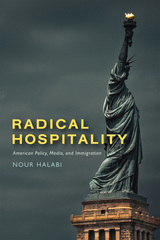 Radical Hospitality: American Policy, Media, and Immigration
Nour Halabi
Rutgers University Press, 2022 Radical Hospitality: American Policy, Media, and Immigration re-imagines the ethical relationship of host societies towards newcomers by applying the concept of hospitality to two specific realms that impact the lives of immigrants in the United States: policy and media. The book calls attention to the moral responsibility of the host in welcoming a stranger. It sets the stage for the analysis with a historical background of the first host-guest diads of American hospitality, arguing that the early history of American hospitality was marked by the degeneration of the host-guest relationship into one of host-hostage, normalizing a racial discrimination that continues to plague immigration hospitality to this day. Author Nour Halabi presents a historical policy and media discourse analysis of immigration regulation and media coverage during three periods of US history: the 1880s and the Chinese Exclusion Act, the 1920s and the National Origins Act and the 2000s and the Muslim travel ban. In so doing, it demonstrates how U.S. immigration hospitality, from its peaks in the post-Independence period to its nadir in the Muslim travel ban, has fallen short of true hospitality in spite of the nation’s oft-touted identity as a “nation of immigrants.” At the same time, the book calls attention to how a discourse of hospitality, although fraught, may allow a radical reimagining of belonging and authority that unsettles settler-colonial assumptions of belonging and welcome a restorative outlook to immigration policy and its media coverage in society.
 Radical Indecision: Barthes, Blanchot, Derrida, and the Future of Criticism
Leslie Hill
University of Notre Dame Press, 2010
In his newest book, Radical Indecision, esteemed scholar Leslie Hill poses the following question: If the task of a literary critic is to make decisions about the value of a literary work or the values embodied in it, decisions in turn based on some inherited or established values, what happens when that piece of literature fails to subscribe to the established values? Put another way, how should literary criticism respond to the paradox that in order to make critical judgments of literary works, it is first necessary to suspend judgment and to consider the impossibility of making a final decision? Hill pursues these ideas in the works of leading French critics Roland Barthes, Maurice Blanchot, and Jacques Derrida, discussing writers such as Sade, Mallarme, Proust, Artaud, Genet, Celan, and Duras.
Hill concludes that, despite their differences, Barthes, Blanchot, and Derrida share a conviction that criticism cannot take place without exposure to that resistance to decision that is inseparable from reading and that they address diversely as the "neuter" or the "undecidable." Radical Indecisionoffers the first sustained exploration of the "undecidable." This comprehensive book breathes new life into the discipline of literary theory and will be essential reading for students and scholars alike.
"Radical Indecisionoffers vivid and compelling original readings of Barthes, Blanchot, and Derrida. Leslie Hill provides much more than another guide to three major theoreticians. He makes concrete sense of Derrida's concept of the undecidable and of a 'justice to come' in the field of literary studies. This outstanding book is the work of a seasoned commentator who has gained international visibility through his canonical books on Beckett and Blanchot, who is a major player in the fields of deconstruction and literary phenomenology." --Jean-Michel Rabate, University of Pennsylvania
"Leslie Hill confronts us once again here with the event of literature, so abrupt and unmistakable that it leaves us completely at a loss as to what it is we have yet to encounter. Only a scholar as learned and exacting as Hill could remind us so well of this devastating experience of indecision, and of its baffling demand." --Ann Smock, University of California, Berkeley
"Leslie Hill argues for a response to writing that does justice to its singularity and otherness, and his superb readings of Barthes, Blanchot, and Derrida exemplify just such a response. The understanding of literature that emerges from his meticulous accounts of these writers in their intellectual contexts is one that grants it importance precisely because it cannot be evaluated according to existing norms. The literary work both invokes the laws according to which it must be read and suspends those laws in an opening toward the future; Hill's 'indecisive' readings trace both the operation and the suspension of the laws of literature and literary criticism in wonderfully detailed engagements with his three subjects." --Derek Attridge, University of York
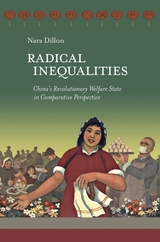 Radical Inequalities: China's Revolutionary Welfare State in Comparative Perspective
Nara Dillon
Harvard University Press, 2015 The Chinese Communist welfare state was established with the goal of eradicating income inequality. But paradoxically, it actually widened the income gap, undermining one of the most important objectives of Mao Zedong’s revolution. Nara Dillon traces the origins of the Chinese welfare state from the 1940s through the 1960s, when such inequalities emerged and were institutionalized, to uncover the reasons why the state failed to achieve this goal.
Using newly available archival sources, Dillon focuses on the contradictory role played by labor in the development of the Chinese welfare state. At first, the mobilization of labor helped found a welfare state, but soon labor’s privileges turned into obstacles to the expansion of welfare to cover more of the poor. Under the tight economic constraints of the time, small, temporary differences evolved into large, entrenched inequalities. Placing these developments in the context of the globalization of the welfare state, Dillon focuses on the mismatch between welfare policies originally designed for European economies and the very different conditions found in revolutionary China. Because most developing countries faced similar constraints, the Chinese case provides insight into the development of narrow, unequal welfare states across much of the developing world in the postwar period.
 Radical Initiatives in Interventionist & Community Drama
Edited by Peter Billingham
Intellect Books, 1995 This new series of cutting edge critical essays and articles in issues concerning Drama and Performance opens with Volume I, which will focus on issues of Interventionist Drama and related examples of Drama as Community.
The list of contributors is impressive and quite consciously eclectic, ranging from established scholars such as Dr. Lionel Pilkington (University of Galway) through to the latest talent emerging in the field of theatre research such as Bill McDonnell (University of Sheffield) and Maureen Barry (Bretton Hall College, University of Leeds.) There is also a significant international dimension to Volume I with contributions from Carole Christensen (Copenhagen) and - (South Africa), with Velda Harris (Central School of Speech and Drama) offering a critical evaluation of her work with nomadic tribes people in Azerbaijan.
As with the series as a whole, the focus for this first collection is a fusion of high-quality scholarly research with dynamic and perceptive accounts from practitioners in their field of work. Similarly this collection represents an eclectic mix of material that is absolutely contemporary and previously unpublished, offering a unique insight into some of the ideological, methodological and aesthetic issues surrounding the generic area of Interventionist and Community Theatre.
 Radical Jewish Politics: A Global Perspective
Nathaniel Deutsch
Rutgers University Press, 2026 For the first time, this volume centers the rich but little known history of radical Jewish politics in the Middle East and North Africa and puts it into conversation with developments in the Americas, South Africa, Soviet Asia, and Europe. Jews were attracted to radical politics in the nineteenth and twentieth centuries to transform the societies they lived in but also out of a deep desire to belong. Somewhat paradoxically, then, radical politics held out the enticing possibility of normalization for Jews, even as it frequently resulted in their further alienation or persecution. In some cases, Jewish radicals sought recognition and autonomy as Jews; in others, Jews labored to be accepted as full-fledged citizens of their home countries; in still others, they tried to escape Jewishness altogether. Jewish experiences of modernity, colonialism, race, nationalism, emancipation, war, and migration, serve as the connective tissue that binds together radical Jewish politics from Baghdad to Buenos Aires.
The Radical Lord Radnor: The Public Life of Viscount Folkestone, Third Earl of Radnor (1779-1869)
Ronald K. Huch
University of Minnesota Press, 1977
The Radical Lord Radnor was first published in 1977. Minnesota Archive Editions uses digital technology to make long-unavailable books once again accessible, and are published unaltered from the original University of Minnesota Press editions.
The third Earl of Radnor, born William Pleydell-Bouverie, served in the British House of Commons for twenty-seven years (1801–1828) as Viscount Folkestone and in the House of Lords for twenty years (1828–1848). Although he was a great hereditary landowner, Lord Radnor was the most radical nobleman to serve in Parliament in the first half of the nineteenth century. In this political biography, Professor Huch traces Lord Radnor's entire parliamentary career.
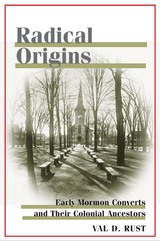 Radical Origins: Early Mormon Converts and Their Colonial Ancestors
Val D. Rust
University of Illinois Press, 2004 Val D. Rust's Radical Origins investigates whether the unconventional religious beliefs of their colonial ancestors predisposed early Mormon converts to embrace the (radical( message of Joseph Smith Jr. and his new church.
Utilizing a unique set of meticulously compiled genealogical data, Rust uncovers the ancestors of early church members throughout what we understand as the radical segment of the Protestant Reformation. Coming from backgrounds in the Antinomians, Seekers, Anabaptists, Quakers, and the Family of Love, many colonial ancestors of the church(s early members had been ostracized from their communities. Expelled from the Massachusetts Bay Colony, some were whipped, mutilated, or even hanged for their beliefs.
Rust shows how family traditions can be passed down through the generations, and can ultimately shape the outlook of future generations. This, he argues, extends the historical role of Mormons by giving their early story significant implications for understanding the larger context of American colonial history. Featuring a provocative thesis and stunning original research, Radical Origins is a remarkable contribution to our understanding of religion in the development of American culture and the field of Mormon history.
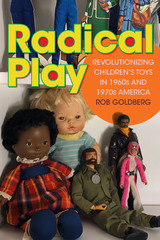 Radical Play: Revolutionizing Children’s Toys in 1960s and 1970s America
Rob Goldberg
Duke University Press, 2023 In Radical Play Rob Goldberg recovers a little-known history of American children’s culture in the 1960s and 1970s by showing how dolls, guns, action figures, and other toys galvanized and symbolized new visions of social, racial, and gender justice. From a nationwide movement to oppose the sale of war toys during the Vietnam War to the founding of the company Shindana Toys by Black Power movement activists and the efforts of feminist groups to promote and produce nonsexist and racially diverse toys, Goldberg returns readers to a defining moment in the history of childhood when politics, parenting, and purchasing converged. Goldberg traces not only how movement activists brought their progressive politics to the playroom by enlisting toys in the era’s culture wars but also how the children’s culture industry navigated the explosive politics and turmoil of the time in creative and socially conscious ways. Outlining how toys shaped and were shaped by radical visions, Goldberg locates the moment Americans first came to understand the world of toys—from Barbie to G.I. Joe—as much more than child’s play.
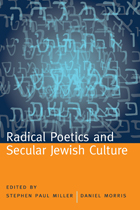 Radical Poetics and Secular Jewish Culture
Edited by Stephen Paul Miller and Daniel Morris
University of Alabama Press, 2009 "What have I in common with Jews? I hardly have anything in common with myself!"
--Franz Kafka
Kafka's quip--paradoxical, self-questioning, ironic--highlights vividly some of the key issues of identity and self-representation for Jewish writers in the 20th century. No group of writers better represents the problems of Jewish identity than Jewish poets writing in the American modernist tradition--specifically secular Jews: those disdainful or suspicious of organized religion, yet forever shaped by those traditions.
This collection of essays is the first to address this often obscured dimension of modern and contemporary poetry: the secular Jewish dimension. Editors Daniel Morris and Stephen Paul Miller asked their contributors to address what constitutes radical poetry written by Jews defined as "secular," and whether or not there is a Jewish component or dimension to radical and modernist poetic practice in general. These poets and critics address these questions by exploring the legacy of those poets who preceded and influenced them--Stein, Zukofsky, Reznikoff, Oppen, and Ginsberg, among others.
While there is no easy answer for these writers about what it means to be a Jew, in their responses there is a rich sense of how being Jewish reflects on their aesthetics and practices as poets, and how the tradition of the avant-garde informs their identities as Jews. Fragmented identities, irony, skepticism, a sense of self as "other" or "outsider," distrust of the literal, and belief in a tradition that questions rather than answers--these are some of the qualities these poets see as common to themselves, the poetry they make, and the tradition they work within.
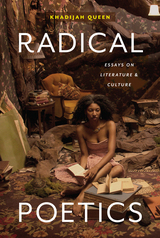 Radical Poetics: Essays on Literature & Culture
Khadijah Queen
University of Michigan Press, 2025 Literature has the power to help build a shelter in language for a way of being that holds integrity and love as its root. In the tradition of Audre Lorde, Angela Davis, and many other Black writers and theorists, poet and professor Khadijah Queen observes questions of life and literature, human feeling and behavior, and explores language-based solutions to common cultural conflicts that are often rooted in harmful assumptions.
Instead of operating from a base of unquestioned thought and systemic tradition, Radical Poetics presents more inclusive and accurate ways of contemplating literary work. Building on ideas and theoretical practices from Édouard Glissant, Toni Morrison, bell hooks, Saidiya Hartman, and Kimberlé Crenshaw, Queen reads for where love is present as well as for where it is absent—tracing systems of thought and aesthetic choices to track how characters are portrayed in terms of race, gender, class, and disability. She analyzes short stories, novels, nonfiction narratives, poetry, and a play from authors such as Herman Melville, Kate Chopin, Dionne Brand, Frances Ellen Watkins Harper, Ma-ka-tai-me-she-kia-kiak, Sor Juana Inés de la Cruz, Natasha Trethewey, and Muriel Rukeyser. Queen’s essays offer shifts in thinking about language—beyond calling out the ways language punishes vulnerability, entrenches harm, and suppresses true intercultural communication. Her intuitive approach aims to correct inaccuracies that have served as a foundation for the discriminatory thinking that undergirds American institutions and culture, particularly the continued glorification of violence. Radical Poetics makes a case for the imperative and practical value of understanding poetics beyond artistic and academic spaces and into everyday life.
Radical Protest and Social Structure: The Southern Farmers' Alliance and Cotton Tenancy, 1880-1890
Michael Schwartz
University of Chicago Press, 1988 "Michael Schwartz's book is really three books in one—an analysis of the structural changes that produced one of the most oppressive social systems the world has known (the one-crop cotton tenancy economy and the system of institutionalized racism and authoritarian one-party politics that was required to preserve the fragile economic arrangement); a theoretical analysis of the origins, mobilization, and outcome of insurgent challenges; and a meticulous application of that theory to the rise and collapse of the Populist movement."—Craig Jenkins, Theory and Society
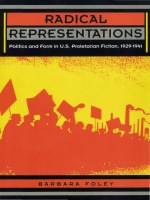 Radical Representations: Politics and Form in U.S. Proletarian Fiction, 1929–1941
Barbara Foley
Duke University Press, 1994 In this revisionary study, Barbara Foley challenges prevalent myths about left-wing culture in the Depression-era U.S. Focusing on a broad range of proletarian novels and little-known archival material, the author recaptures an important literature and rewrites a segment of American cultural history long obscured and distorted by the anti-Communist bias of contemporaries and critics.
Josephine Herbst, William Attaway, Jack Conroy, Thomas Bell and Tillie Olsen, are among the radical writers whose work Foley reexamines. Her fresh approach to the U.S. radicals' debates over experimentalism, the relation of art to propaganda, and the nature of proletarian literature recasts the relation of writers to the organized left. Her grasp of the left's positions on the "Negro question" and the "woman question" enables a nuanced analysis of the relation of class to race and gender in the proletarian novel. Moreover, examining the articulation of political doctrine in different novelistic modes, Foley develops a model for discussing the interplay between politics and literary conventions and genres.
Radical Representations recovers a literature of theoretical and artistic value meriting renewed attention form those interested in American literature, American studies, the U. S. left, and cultural studies generally.
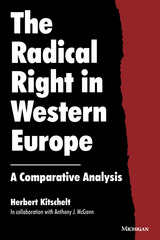 The Radical Right in Western Europe: A Comparative Analysis
Herbert Kitschelt
University of Michigan Press, 1997 Winner of the American Political Science Association's 1996 Woodrow Wilson Foundation Award.
The rise of new political competitors on the radical right is a central feature of many contemporary European party systems. The first study of its kind based on a wide array of comparative survey data, The Radical Right in Western Europe: A Comparative Analysis provides a unifying framework to explain why rightist parties are electorally powerful in some countries but not in others. The book argues that changes in social structure and the economy do not by themselves adequately explain the success of extremist parties. Instead we must look to the competitive struggles among parties, their internal organizational patterns, and their long-term ideological traditions to understand the principles governing their success.
Radical right authoritarian parties tend to emerge when moderate parties converge toward the median voter. But the success of these parties depends on the strategy employed by the right-wing political actors. Herbert Kitschelt's in-depth analysis, based on the experiences of rightist parties in Austria, Denmark, France, Germany, Italy, Norway, and Britain, reveals that the broadest appeal is enjoyed by parties that couple a fierce commitment to free markets with authoritarian, ethnocentric--or even racist--messages. The author also shows how a country's particular political constituency or its intellectual and organizational legacies may allow right-wing parties to diverge from these norms and still find electoral success. The book concludes by exploring the interaction between the development of the welfare state, cultural pluralization through immigrants, and the growth of the extreme right.
Herbert Kitschelt is Professor of Political Science at both Duke University and Humboldt University, Berlin. Anthony McGann is a Ph.D. candidate in political science at Duke University.
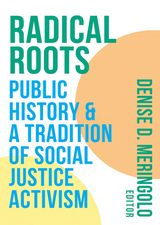 Radical Roots: Public History and a Tradition of Social Justice Activism
Denise D. Meringolo
Amherst College Press, 2021 While all history has the potential to be political, public history is uniquely so: public historians engage in historical inquiry outside the bubble of scholarly discourse, relying on social networks, political goals, practices, and habits of mind that differ from traditional historians. Radical Roots: Public History and a Tradition of Social Justice Activism theorizes and defines public history as future-focused, committed to the advancement of social justice, and engaged in creating a more inclusive public record. Edited by Denise D. Meringolo and with contributions from the field’s leading figures, this groundbreaking collection addresses major topics such as museum practices, oral history, grassroots preservation, and community-based learning. It demonstrates the core practices that have shaped radical public history, how they have been mobilized to promote social justice, and how public historians can facilitate civic discourse in order to promote equality.
"This is a much-needed recalibration, as professional organizations and practitioners across genres of public history struggle to diversify their own ranks and to bring contemporary activists into the fold." — Catherine Gudis, University of California, Riverside.
"Taken all together, the articles in this volume highlight the persistent threads of justice work that has characterized the multifaceted history of public history as well as the challenges faced in doing that work."—Patricia Mooney-Melvin, The Public Historian
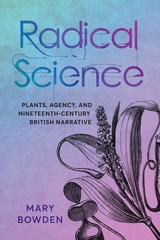 Radical Science: Plants, Agency, and Nineteenth-Century British Narrative
Mary Bowden
Ohio State University Press, 2026 Can plants move? Can they think? Can they act? In Radical Science, Mary Bowden shows that debates about plants’ capabilities are not new but can be traced to the nineteenth century, where they moved from scientific inquiries to popular articles and literary fiction. Examining the work of nineteenth-century physiological botanists, Bowden expands beyond Charles Darwin’s work in the field to uncover the full story of these debates and the impacts they had on literature, culture, and people. While many have interpreted the frequent comparisons between plants and people in nineteenth-century literature to be exemplative of aesthetic values or sexual symbolism, Bowden maintains that comparisons between plants and women, members of the working class, and people of color reiterate botanical debates about how to recognize agency in beings that are assumed to be passive. Studying the scientific texts of Darwin and Maria Elizabetha Jacson alongside social problem novels by Elizabeth Gaskell and Charles Kingsley and early science fiction by H. G. Wells, Radical Science foregrounds the connection between science and literature and ultimately suggests that we look to the propositions of nineteenth-century physiological botany to find more sustaining models of social and environmental relationship.
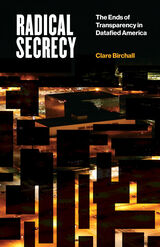 Radical Secrecy: The Ends of Transparency in Datafied America
Clare Birchall
University of Minnesota Press, 2021 Reimagining transparency and secrecy in the era of digital data
When total data surveillance delimits agency and revelations of political wrongdoing fail to have consequences, is transparency the social panacea liberal democracies purport it to be? This book sets forth the provocative argument that progressive social goals would be better served by a radical form of secrecy, at least while state and corporate forces hold an asymmetrical advantage over the less powerful in data control. Clare Birchall asks: How might transparency actually serve agendas that are far from transparent? Can we imagine a secrecy that could act in the service of, rather than against, a progressive politics? To move beyond atomizing calls for privacy and to interrupt the perennial tension between state security and the public’s right to know, Birchall adapts Édouard Glissant’s thinking to propose a digital “right to opacity.” As a crucial element of radical secrecy, she argues, this would eventually give rise to a “postsecret” society, offering an understanding and experience of the political that is free from the false choice between secrecy and transparency. She grounds her arresting story in case studies including the varied presidential styles of George W. Bush, Barack Obama, and Donald Trump; the Snowden revelations; conspiracy theories espoused or endorsed by Trump; WikiLeaks and guerrilla transparency; and the opening of the state through data portals. Postsecrecy is the necessary condition for imagining, finally, an alternative vision of “the good,” of equality, as neither shaped by neoliberal incarnations of transparency nor undermined by secret state surveillance. Not least, postsecrecy reimagines collective resistance in the era of digital data.
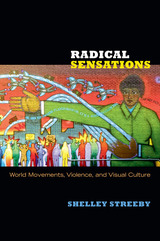 Radical Sensations: World Movements, Violence, and Visual Culture
Shelley Streeby
Duke University Press, 2013 The significant anarchist, black, and socialist world-movements that emerged in the late nineteenth century and early twentieth adapted discourses of sentiment and sensation and used the era's new forms of visual culture to move people to participate in projects of social, political, and economic transformation. Drawing attention to the vast archive of images and texts created by radicals prior to the 1930s, Shelley Streeby analyzes representations of violence and of abuses of state power in response to the Haymarket police riot, of the trial and execution of the Chicago anarchists, and of the mistreatment and imprisonment of Ricardo and Enrique Flores Magón and other members of the Partido Liberal Mexicano. She considers radicals' reactions to and depictions of U.S. imperialism, state violence against the Yaqui Indians in the U.S.-Mexico borderlands, the failure of the United States to enact laws against lynching, and the harsh repression of radicals that accelerated after the United States entered the First World War. By focusing on the adaptation and critique of sentiment, sensation, and visual culture by radical world-movements in the period between the Haymarket riots of 1886 and the deportation of Marcus Garvey in 1927, Streeby sheds new light on the ways that these movements reached across national boundaries, criticized state power, and envisioned alternative worlds.
Radical Sisters: Second-Wave Feminism and Black Liberation in Washington, D.C.
Anne M. Valk
University of Illinois Press, 2010 Radical Sisters offers a fresh exploration of the ways that 1960s political movements shaped local, grassroots feminism in Washington, D.C. Rejecting notions of a universal sisterhood, Anne M. Valk argues that activists periodically worked to bridge differences for the sake of alleviating women's plight, even while maintaining distinct political bases. While most historiography on the subject tends to portray the feminist movement as deeply divided over issues of race, Valk presents a more nuanced account, showing feminists of various backgrounds both coming together to promote a notion of "sisterhood" and being deeply divided along the lines of class, race, and sexuality.
 The Radical Spanish Empire: How Paperwork Politics Remade the New World
Jorge Cañizares-Esguerra and Adrian Masters
Harvard University Press, 2026 A groundbreaking history of political struggle in the Spanish New World, where commoners and elites alike challenged the social order through the remarkable power of paperwork.
As Spanish conquistadors swept through the New World, the Crown envisioned that a rigidly hierarchical aristocratic order would flourish in their wake. At first, this vision seemed to be within reach: the great conquistadors ruled as noblemen over millions. Yet contrary to all expectations, the Spanish empire in the New World quickly became a hotbed of radical efforts to overturn the emerging order. With the conquistadors in retreat, new enclaves controlled by powerful friars and native lords arose. But they too collapsed, again to the surprise of many.
As Jorge Cañizares-Esguerra and Adrian Masters show, these social orders broke down thanks to the challenges mounted by countless individuals across the Spanish Americas—including non-elite Spanish and Indigenous people, women, and the enslaved. To achieve their goals, they turned not only to outright violence but also to massive amounts of paperwork: petitions, complaints, lawsuits, and secret testimonies. Through this grassroots “lawfare,” vassals undercut the emerging seigneurial dynasties of the conquistadors, stripped the friars of theocratic authority, and curtailed the might of native lords. Collectively, they spearheaded movements against tyranny and slavery, proposed and challenged laws, produced new types of knowledge, created archives and historical accounts, and questioned the nature of truth itself. In the process, however, these actors also gradually co-created a lasting new society of orders—one that would solidify in the 1570s with viceroys, bishops, and inquisitors at its apex.
Dramatically recasting a pivotal era in colonial history, The Radical Spanish Empire illuminates how the power of paperwork forever transformed the New World.
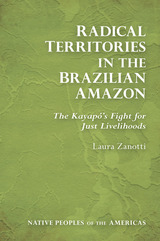 Radical Territories in the Brazilian Amazon: The Kayapó’s Fight for Just Livelihoods
Laura Zanotti
University of Arizona Press, 2016 Indigenous groups are facing unprecedented global challenges in this time of unparalleled environmental and geopolitical change, a time that has intensified human-rights concerns and called for political and economic restructuring. Within this landscape of struggle, the Kayapó, an indigenous nation in the central Brazilian Amazon, emerge as leaders in the fight.
Radical Territories in the Brazilian Amazon sheds light on the creative and groundbreaking efforts Kayapó peoples deploy to protect their lands and livelihoods. Now at the front lines of cultivating diversified strategies for resistance, the Kayapó are creating a powerful activist base, experimenting with nontimber forest projects, and forging strong community conservation partnerships. Tracing the complex politics of the Kayapó’s homeland, Laura Zanotti advances approaches to understanding how indigenous peoples cultivate self-determination strategies in conflict-ridden landscapes.
Kayapó peoples are providing a countervision of what Amazonia can look like in the twenty-first century, dominated neither by agro-industrial interests nor by uninhabited protected landscapes. Instead, Kayapó peoples see their homeland as a living landscape where indigenous vision engages with broader claims for conservation and development in the region.
Weaving together anthropological and ethnographic research with personal interactions with the Kayapó, Zanotti tells the story of activism and justice in the Brazilian Amazon, and how Kayapó communities are using diverse pathways to make a sustainable future for their peoples and lands. The author interweaves Kayapó perspectives with a political ecology framework to show how working with indigenous peoples is vital to addressing national and global challenges in the present time, when many environmentally significant conditions and processes are profoundly altered by human activities.
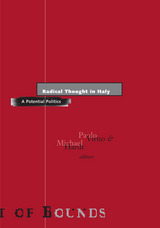 Radical Thought in Italy: A Potential Politics
Paolo Virno
University of Minnesota Press, 2006 Over the past several decades, Italian revolutionary politics has offered a model for new forms of political thinking. Radical Thought in Italy continues that tradition by providing an original view of the potential for a radical democratic politics today that speaks not only to the Italian situation but also to a broadly international context. First, the essays settle accounts with the culture of cynicism, opportunism, and fear that has come to permeate the Left. They then proceed to analyze the new difficulties and possibilities opened by current economic conditions and the crisis of the welfare state. Finally, the authors propose a series of new concepts that are helpful in rethinking revolution for our times. Contributors: Giorgio Agamben, U of Verona and Collège Internationale de Philosophie, Paris; Massimo De Carolis, U of Salerno; Alisa Del Re, U of Padua; Augusto Illuminati, U of Urbino; Maurizio Lazzarato; Antonio Negri, U of Paris VIII; Franco Piperno, U of Calabria; Marco Revelli, U of Turin; Rossana Rossanda; Carlo Vercellone; Adelino Zanini. Paolo Virno is the author of several books, including the recently translated A Grammar of the Multitude. Michael Hardt is professor of literature and romance studies at Duke University.
Radical Tragedy: Religion, Ideology and Power in the Drama of Shakespeare and His Contemporaries
Jonathan Dollimore
Duke University Press, 2004 When it was first published, Radical Tragedy was hailed as a groundbreaking reassessment of the drama of Shakespeare and his contemporaries. An engaged reading of the past with compelling contemporary significance, Radical Tragedy remains a landmark study of Renaissance drama. The third edition of this critically acclaimed work includes a new foreword by Terry Eagleton and an extensive new introduction by the author.
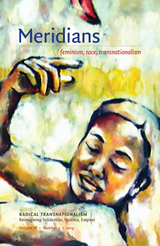 Radical Transnationalism: Reimagining Solidarities, Violence, Empires
Laura Briggs, Ginetta E. B. Candelario, and Robyn C. Spencer, special issue editors
Duke University Press This issue of Meridians looks at the expansive domains of transnational feminism, considering its relationship to different regions, historical periods, fields, and methodologies. Through scholarship and creative writing, contributors showcase populations often overlooked in transnational feminist scholarship, including Africa and its diaspora and indigenous people in the Americas and the Pacific. Understanding that transnational feminism emerges from multiple locales across the Global South and North, this group of contributors, working in exceptionally diverse locations, investigates settler colonialism, racialization, globalization, militarization, decoloniality, and anti-authoritarian movements as gendered political and economic projects.Working with manifestos, archives, oral histories, poetry, visual media, and ethnographies from across four continents, the contributors offer a radically expanded vision for transnational feminism.
Contributors. Elisabeth Armstrong, Maile Arvin, Maylei Blackwell, Laura Briggs, Ginetta E. B. Candelario, Ching-In Chen, Tara Daly, Nathan H. Dize, Deema Kaedbey, Nancy Kang, Rosamond S. King, Karen J. Leong, Brooke Lober, Neda Maghbouleh, Melissa A. Milkie, Nadine Naber, Laila Omar, Ito Peng, Robyn C. Spencer, Stanlie James, Evelyne Trouillot, Denisse D. Velázquez, Mandira Venkat, Judy Tzu-Chun Wu
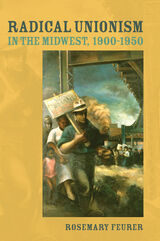 Radical Unionism in the Midwest, 1900-1950
Rosemary Feurer
University of Illinois Press, 2006 District 8 of the United Electrical, Radio, and Machine Workers (UE) developed a style of unionism designed to confront corporate power but also act as a force for social transformation in their community and nation. Rosemary Feurer examines the fierce battles between these Midwestern electrical workers and the bitterly anti-union electrical and metal industry, Exploring the role of radicals in local movement formation, Feurer reveals a "civic" unionism that could connect community and union concerns to build solidarity and contest the political economy. District 8's spirited unionism included plant occupations in St. Louis and Iowa; campaigns to democratize economic planning; and strategies for national bargaining that elected officials inevitably branded as part of a communist conspiracy. Though destroyed by reactionaries and an anticommunist backlash, District 8 molded a story that tells another side of the labor movement's formation in the 1930s and 1940s, and can inform current struggles against corporate power in the modern global economy.
Radical Utu: Critical Ideas and Ideals of Wangari Muta Maathai
Besi Brillian Muhonja
Ohio University Press, 2020 Wangari Muta Maathai was a scholar-activist known for founding the Green Belt Movement, an environmental campaign that earned her the Nobel Peace Prize. While many studies of Maathai highlight her activism, few examine Maathai as a scholar whose contributions to various disciplines and causes spanned more than three decades. In Radical Utu: Critical Ideas and Ideals of Wangari Muta Maathai, Besi Brillian Muhonja presents the words and works of Maathai as theoretical concepts attesting to her contributions to gender equality, democratic spaces, economic equity and global governance, and indigenous African languages and knowledges. Muhonja’s well-rounded portrait of Maathai’s ideas offers a corrective to the one-dimensional characterization of Maathai typical of other works.
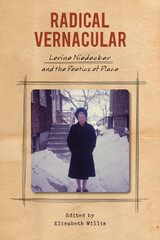 Radical Vernacular: Lorine Niedecker and the Poetics of Place
Elizabeth Willis
University of Iowa Press, 2008 When Lorine Niedecker died in 1970, the British poet and critic Basil Bunting eulogized her warmly. “In England,” he wrote, “she was, in the estimation of many, the most interesting woman poet America has yet produced.”
Aesthetically linked with the New York Objectivist poets, Niedecker remained committed to her community in rural Wisconsin despite the grinding poverty that dogged her throughout her life. Largely self-taught, Niedecker formed attachments through her voracious reading and correspondence, but she also delighted in the disruptive richness of vernacular usage and in the homegrown, improvisational aesthetics that thrived within her immediate world. Niedecker wrote from a highly attenuated concern with biological, cultural, and political sustainability and, in her stridently modernist poems, anticipated many of the most urgent concerns in twenty-first-century poetics. In Radical Vernacular, Elizabeth Willis collects essays by leading poets and scholars that make a major contribution to the study of an important but long overlooked American poet.
This pathbreaking volume contains essays by seventeen leading scholars: Rae Armantrout, Glenna Breslin, Michael Davidson, Rachel Blau DuPlessis, Ruth Jennison, Peter Middleton, Jenny Penberthy, Mary Pinard, Patrick Pritchett, Peter Quartermain, Lisa Robertson, Elizabeth Robinson, Eleni Sikelianos, Jonathan Skinner, Anne Waldman, Eliot Weinberger, and Elizabeth Willis.
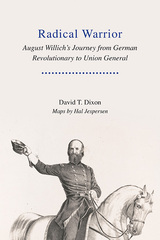 Radical Warrior: August Willich's Journey from German Revolutionary to Union General
David Dixon
University of Tennessee Press, 2020 An estimated 200,000 men of German birth enlisted in the Union Army during the Civil War, far more than any other contemporary foreign-born population. One of these, Prussian Army officer Johann August Ernst von Willich, led a remarkable life of integrity, commitment to a cause, and interaction with leading lights of the nineteenth century. After resigning from the Prussian Army due to his republican beliefs, Willich led armed insurrections during the revolutions of 1848–49, with Friedrich Engels as his aide-de-camp. Ever committed to the goal of universal human rights, he once dueled a disciple of Karl Marx—whom he thought too conservative. Willich emigrated to the United States in 1853, eventually making his way to Cincinnati, where he served as editor of the daily labor newspaper the Cincinnati Republican. With exhaustive research in both English and German language sources, author David T. Dixon chronicles the life of this ingenious military leader—a man who could also be stubborn, impulsive, and even foolhardy—risking his life unnecessarily in the face of overwhelming odds.
As soon as shots were fired at Fort Sumter, fifty-year-old Willich helped raise a regiment to fight for the Union. Though he had been a lieutenant in Europe, he enlisted as a private. He later commanded an all-German regiment, rose to the rank of brigadier general, and was later brevetted major general. Dixon’s vivid narrative places the Civil War in a global context. For Willich and other so-called “Forty-Eighters” who emigrated after the European revolutions, the nature and implications of the conflict turned not on Lincoln’s conservative goal of maintaining the national Union, but on issues of social justice, including slavery, free labor, and popular self-government. It was a war not simply to heal sectional divides, but to restore the soul of the nation and, in Willich’s own words, “defend the rights of man.”
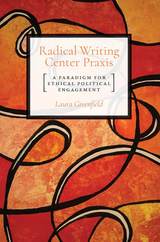 Radical Writing Center Praxis: A Paradigm for Ethical Political Engagement
Laura Greenfield
Utah State University Press, 2019 In Radical Writing Center Praxis Laura Greenfield calls for a paradigm change in writing centers, imagining a field whose very reason for being is to facilitate justice and peace. The book calls on readers to more critically examine power and agency in writing centers and to imagine new possibilities for the field’s theories and practices.
Large, intersecting systems of oppression manifest in the everyday practices of institutions, classrooms, and writing centers. Local practices in turn influence the surrounding world. Radical Writing Center Praxis therefore challenges the writing center field to resist assumptions of political neutrality and instead to redefine itself in terms of more explicit ethical commitments. In this paradigm it is clear that to engage in anti-oppression work is not merely a special interest but rather a vital interest to all.
Introducing the concepts and vocabulary of radical politics, Radical Writing Center Praxis examines the tensions between the field’s professed beliefs and everyday practices and offers a process by which the writing center discipline as a whole might rebuild itself anew. It will be invaluable to writing center directors, tutors, scholars, and students as well as to administrators and compositionists.
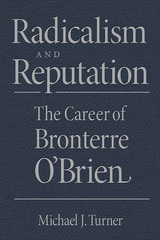 Radicalism and Reputation: The Career of Bronterre O'Brien
Michael J. Turner
Michigan State University Press, 2017 A thematic analysis of the career of Bronterre O’Brien, one of the most influential leaders of Chartism, this book relates his activities—and the Chartist movement—to broader themes in the history of Britain, Europe, and America during the nineteenth century. O’Brien (1804–64) came to be known as the “schoolmaster” of Chartism because of his efforts to describe and explain its intellectual foundations. The campaign for the People’s Charter (with its promise of political democratization) was a highpoint in O’Brien’s career as writer and orator, but he was already well known before the campaign began, and during the 1840s he distanced himself from other Chartist leaders and from several important Chartist initiatives. This book examines the personal, tactical, and ideological reasons for O’Brien’s departure, as well as his development of a social and economic agenda to accompany “constitutional” Chartism, in line with the evolution of radical thought after the Great Reform Act of 1832. It also evaluates O’Brien’s reputation, among his contemporaries and among modern historians, in order better to understand his contribution to radicalism in Britain and beyond.
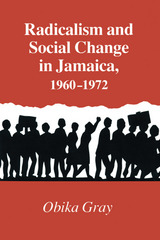 Radicalism and Social Change in Jamaica: 1960-1972
Obika Gray
University of Tennessee Press, 2007 In August 1962, the island nation of Jamaica achieved independence from Great Britain. In this provocative social and political history of the first decade of independence, Obika Gray explores the impact of radical social movements on political change in Jamaica during a turbulent formative era.
Led by a minority elite and a middle class of mixed racial origins, two parties, each with its associated workers’ union, emerged to dominate the postcolonial political scene. Gray argues that party leaders, representing the dominant social class, felt vulnerable to attack and resorted to dictatorial measures to consolidate their power. These measures, domestic social crises, and the worldwide rise of Black Power and other Third World ideologies provoked persistent challenges to the established parties’ political and moral authority. With students, radical intellectuals, and the militant urban poor in the vanguard, the protest movement took many forms. Rastafarian religious symbolism, rebel youth’s cultural innovations, efforts to organize independent labor unions, and the intelligentsia’s varied attempts to use mass media to reach broader audiences—all influenced the course of political events in this period. Grounding his tale in relevant theory, Gray persuasively contends that, despite its narrow social and geographical base of support, this urban protest movement succeeded in moving the major parties toward broader
and more progressive agendas.
Radicalism and the Origins of the Vietnamese Revolution
Hue-Tam Ho Tai
Harvard University Press, 1992 In the early years of the Vietnamese Revolution—the 1920s and 1930s—radicalism was the dominant force in anticolonial politics. The subsequent displacement of radicalism by communism, however, has obscured radicalism’s role as a nonideological reaction to both colonial rule and native accommodation to that rule. Hue-Tam Ho Tai seeks to redress the influence of radicalism on this crucial point in Vietnamese history. She reveals a vibrant and explosive era of student strikes, debates on women’s emancipation, revolt against the patriarchal family, and intellectual explorations of French and Chinese politics and thought.
Making instructive use of literacy sources, archival materials, and the unpublished memoirs of her father, himself a participant in these events, Tai persuasively sets right the personalities and spirit of the Revolution—and the culture from which it emerged.
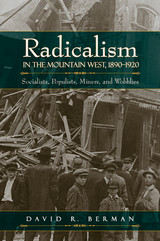 Radicalism in the Mountain West, 1890-1920: Socialists, Populists, Miners, and Wobblies
David R. Berman
University Press of Colorado, 2013 Radicalism in the Mountain West, 1890-1920 traces the history of radicalism in the Populist Party, Socialist Party, Western Federation of Miners, and Industrial Workers of the World in Arizona, Utah, Nevada, Idaho, Montana, Wyoming, Colorado, and New Mexico. Focusing on the populist and socialist movements, David R. Berman sheds light on American radicalism with this study of a region that epitomized its rise and fall. As the frontier industrialized, self-reliant pioneers and prospectors transformed into wage- laborers for major corporations with government, military, and church ties. Economically and politically stymied, westerners rallied around homegrown radicals such as William "Big Bill" Haywood and Vincent "the Saint" St. John and touring agitators such as Eugene Debs and Mary "Mother" Jones. Radicalism in the Mountain West tells how volleys of strikes, property damage, executions, and deportations ensued in the absence of negotiation. Drawing on years of archival research and diverse materials such as radical newspapers, reports filed by labor spies and government agents, and records of votes, subscriptions, and memberships, Berman offers Western historians and political scientists an unprecedented view into the region's radical past.
 Radicalism in the States: The Minnesota Farmer-Labor Party and the American Political Economy
Richard M. Valelly
University of Chicago Press, 1989 Concentrated in states outside the Northeast and the South, state-level third-party radical politics has been more widespread than many realize. In the 1920s and 1930s, American political organizations strong enough to mount state-wide campaigns, and often capable of electing governors and members of Congress, emerged not only in Minnesota but in Wisconsin and Washington, in Oklahoma and Idaho, and in several other states.
Richard M. Valelly treats in detail the political economy of the Minnesota Farmer-Labor Party (1918-1944), the most successful radical, state-level party in American history. With the aid of numerous interviews of surviving organizers and participants in the party's existence, Valelly recreates the party's rise to power and subsequent decline, seeking answers to some broad, developmental questions. Why did this type of politics arise, and why did it collapse when it did? What does the party's history tell us about national political change? The answers lie, Valelly argues, in America's transition from the political economy of the 1920s to the New Deal. Combining case study and comparative state politics, he reexamines America's political economy prior to the New Deal and the scope and ironies of the New Deal's reorganization of American politics. The results compellingly support his argument that the federal government's increasing intervention in the economy profoundly transformed state politics. The interplay between national economy policy-making and federalism eventually reshaped the dynamics of interest-group politics and closed off the future of "state-level radicalism." The strength of this argument is highlighted by Valelly's cross-national comparison with Canadian politics. In vivid contrast to the fate of American movements, "province level radicalism" thrived in the Canadian political environment.
In the course of analyzing one of the "supressed alternatives" of American politics, Valelly illuminates the influence of the national political economy on American political development. Radicalism in the States will interest students of economic protest, of national policy-making, of interest-group politics and party politics.
Radicalisms in Transition, Volume 2002
Mansour Bonakdarian and Yvonne Lassalle, eds.
Duke University Press The radicalisms are broadly defined by a resistance to oppression and economic exploitation, as well as by a commitment to social justice and human rights. The transition refers to the various sociohistorical processes that have influenced the practice of politics during the last twenty-five years or so: changes in political structures, in geopolitical alignments, in the organization of the economy, in ideological commitments, and, more generally, in the culture of politics.
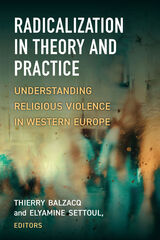 Radicalization in Theory and Practice: Understanding Religious Violence in Western Europe
Thierry Balzacq and Elyamine Settoul, Editors
University of Michigan Press, 2022 Radicalization is a major challenge of contemporary global security. It conjures up images of violent ideologies, “homegrown” terrorists and jihad in both the academic sphere and among security and defense experts. While the first instances of religious radicalization were initially limited to second-generation Muslim immigrants, significant changes are currently impacting this phenomenon. Technology is said to amplify the dissemination of radicalism, though there remains uncertainty as to the exact weight of technology on radical behaviors. Moreover, far from being restricted to young men of Muslim heritage suffering from a feeling of social relegation, radicalism concerns a significant number of converted Muslims, women and more heterogeneous profiles (social, academic and geographic), as well as individuals that give the appearance of being fully integrated in the host society. These new and striking dynamics require innovative conceptual lenses. Radicalization in Theory and Practice identifies the mechanisms that explicitly link radical religious beliefs and radical actions. It describes its nature, singles out the mechanisms that enable radicalism to produce its effects, and develops a conceptual architecture to help scholars and policy-makers to address and evaluate radicalism—or what often passes as such. A variety of empirical chapters fed by first-hand data probe the relevance of theoretical perspectives that shape radicalization studies. By giving a prominent role to first-hand empirical investigations, the authors create a new framework of analysis from the ground up. This book enhances the quality of theorizing in this area, consolidates the quality of methodological enquiries, and articulates security studies insights with broader theoretical debates in different fields including sociology, social psychology, economics, and religious studies.
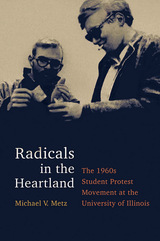 Radicals in the Heartland: The 1960s Student Protest Movement at the University of Illinois
Michael V. Metz
University of Illinois Press, 2019 In 1969, the campus tumult that defined the Sixties reached a flash point at the University of Illinois. Out-of-town radicals preached armed revolution. Students took to the streets and fought police and National Guardsmen. Firebombs were planted in lecture halls while explosions rocked a federal building on one side of town and a recruiting office on the other. Across the state, the powers-that-be expressed shock that such events could take place at Illinois's esteemed, conservative, flagship university—how could it happen here, of all places? Positioning the events in the context of their time, Michael V. Metz delves into the lives and actions of activists at the center of the drama. A participant himself, Metz draws on interviews, archives, and newspaper records to show a movement born in demands for free speech, inspired by a movement for civil rights, and driven to the edge by a seemingly never-ending war. If the sudden burst of irrational violence baffled parents, administrators, and legislators, it seemed inevitable to students after years of official intransigence and disregard. Metz portrays campus protesters not as angry, militant extremists but as youthful citizens deeply engaged with grave moral issues, embodying the idealism, naiveté, and courage of a minority of a generation.
Radicals of the Worst Sort: Laboring Women in Lawrence, Massachusetts, 1860-1912
Ardis Cameron
University of Illinois Press, 1993 Ardis Cameron focuses on the textile workers' strikes of 1882 and 1912 in this examination of class and gender formation as drawn from the experience and language of the working-class neighborhoods of Lawrence, Massachusetts. Using the neighborhood perspective to explore the role of women in worker militancy, Cameron reveals the importance of female networks and organizational life in working-class culture and politics. Unionized women were labeled "radicals of the worst sort" because, in fighting for equality, they also rebelled against traditional economic and sexual hierarchies. Oral histories and detailed maps illuminate the setting and the dramatic story behind the famous Bread and Roses strike of 1912.
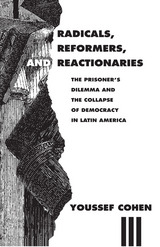 Radicals, Reformers, and Reactionaries: The Prisoner's Dilemma and the Collapse of Democracy in Latin America
Youssef Cohen
University of Chicago Press, 1994 Latin American democracies of the sixties and seventies, most theories hold, collapsed because they had become incompatible with the structural requirements of capitalist development. In this groundbreaking application of game theory to political phenomena, Youssef Cohen argues that structural conditions in Latin American countries did not necessarily preclude the implementation of social and economic reforms within a democratic framework.
Focusing on the experiences of Chile and Brazil, Cohen argues that what thwarted democratic reforms in Latin America was a classic case of prisoner's dilemma. Moderates on the left and the right knew the benefits of coming to a mutual agreement on socio-economic reforms. Yet each feared that, if it cooperated, the other side could gain by colluding with the radicals. Unwilling to take this risk, moderate groups in both countries splintered and joined the extremists. The resulting disorder opened the way for military control.
Cohen further argues that, in general, structural explanations of political phenomena are inherently flawed; they incorrectly assume that beliefs, preferences, and actions are caused by social, political, and economic structures. One cannot explain political outcomes, Cohen argues, without treating beliefs and preferences as partly independent from structures, and as having a causal force in their own right.
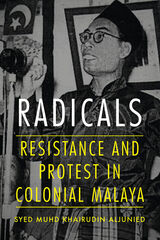 Radicals: Resistance and Protest in Colonial Malaya
Syed Muhd Khairudin Aljunied
Northern Illinois University Press, 2015 Radicals tells the story of a group of radical Malay men and women from ordinary social backgrounds who chose to oppose foreign rule of their homeland, knowing full well that by embarking on this path of resistance, they would risk imprisonment or death. Their ranks included teachers, journalists, intellectuals, housewives, peasants, preachers, and youths. They formed, led, and contributed to the founding of political parties, grassroots organizations, unions, newspapers, periodicals, and schools that spread their ideas across the country in the aftermath of the Great Depression, when colonialism was at its height and evident in all areas of life in their country. But when their efforts to uproot foreign dominance faltered in the face of the sanctions the state imposed upon them, some of these radicals chose to take up arms, while others engaged in aggressive protests and acts of civil disobedience to uphold their rights. While some died fighting and hundreds were incarcerated, many lived to resist colonialism until their country attained its independence in August 1957, all of these Malay radicals were devoted to becoming free men and women and to claiming their right to be treated as equals in a world riddled with prejudice and contradictions.
Syed Muhd Khairudin Aljunied’s innovative study brings to light the less charted and unanalyzed terrain of the radical experience—becoming and being radical. He argues that the experiences and histories of radicals in colonial Malaya can be elucidated in a more nuanced way by interrogating them alongside evolving local and global circumstances and by analyzing them through the lenses of a set of overarching and interconnected mobilizing concepts—a set of ideas, visions, and notions that the radicals used to reason and justify their advent—that were internalized, lived, and utilized in the course of their activism. These mobilizing concepts were their weapons and armor, employed to organize, strategize, protect, and consolidate themselves when menaced by the tentacles of the colonial state as they embarked upon the agonizing path towards independence. Those interested in Malaysian history, colonial history, radical movements, and resistance groups will enjoy this fascinating study.
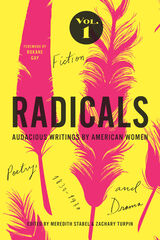 Radicals, Volume 1: Fiction, Poetry, and Drama: Audacious Writings by American Women, 1830-1930
Meredith Stabel and Zachary Turpin
University of Iowa Press, 2021 Kate Chopin on pot smoking. Pauline Hopkins on alchemy and the undead. Sui Sin Far on cross-dressing. Emma Lazarus and Angelina Weld Grimké on lesbian longing. Julia Ward Howe on intersexuality. Perhaps the first of its kind, Radicals is a two-volume collection of writings by American women of the nineteenth and early twentieth centuries, with special attention paid to the voices of Black, Indigenous, and Asian American women.
In Volume 1: Fiction, Poetry, and Drama, selections span from early works like Sarah Louise Forten’s anti-slavery poem “The Grave of the Slave” (1831) and Fanny Fern’s Ruth Hall (1855), a novel about her struggle to break into the male-dominated field of journalism, to Charlotte Perkins Gilman’s revenge fantasy, “When I Was a Witch” (1910) and Georgia Douglas Johnson’s poem on the fraught nature of African American motherhood, “Maternity” (1922). In between, readers will discover many vibrant and challenging lesser-known texts that are rarely collected today. Some, indeed, have been out of print for more than a century.
Unique among anthologies of American literature, Radicals undoes such silences by collecting the underrepresented, the uncategorizable, the unbowed—powerful writings by American women of genius and audacity who looked toward, and wrote toward, what Charlotte Perkins Gilman called “a lifted world.”
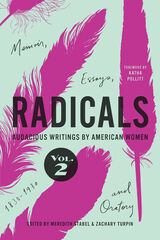 Radicals, Volume 2: Memoir, Essays, and Oratory: Audacious Writings by American Women, 1830-1930
Merdith Stabel and Katha Pollitt
University of Iowa Press, 2021 Emily Dickinson on sex, desire, and “the chapter . . . in the night.” Emma Goldman against the tyranny of marriage. Ida B. Wells against lynching. Anna Julia Cooper on Black American womanhood. Frances Willard on riding a bicycle. Perhaps the first of its kind, Radicals is a two-volume collection of writings by American women of the nineteenth and early twentieth centuries, with special attention paid to the voices of Black, Indigenous, and Asian American women.
In Volume 2: Memoir, Essays, and Oratory, selections span from early works like Sarah Mapps Douglass’s anti-slavery appeal “A Mother’s Love” (1832) and Maria W. Stewart’s “Address Delivered at the African Masonic Hall” (1833), to Zitkala-Sa’s memories in “The Land of Red Apples” (1921) and Charlotte Perkins Gilman’s moving final essay “The Right to Die” (1935). In between, readers will discover a whole host of vibrant and challenging lesser-known texts that are rarely collected today. Some, indeed, have been out of print for more than a century.
Unique among anthologies of American literature, Radicals undoes such silences by collecting the underrepresented, the uncategorizable, the unbowed—powerful writings by American women of genius and audacity who looked toward, and wrote toward, what Charlotte Perkins Gilman called “a lifted world.”
 Radio and Television Broadcasting on the European Continent
Burton Paulu
University of Minnesota Press, 1967
Radio and Television Broadcasting on the European Continent was first published in
1967. Minnesota Archive Editions uses digital technology to make long-unavailable books once again accessible, and are published unaltered from the original University of Minnesota Press editions.
In this book Dr. Paulu provides a comprehensive survey based on firsthand study of the development and current status of radio and television broadcasting in continental Europe. He discusses the technical, organizational, financial, and programming aspects of European broadcasting in both Communist and Western countries. The material is organized, not on a country-by-country basis, but as it relates to broad basic issues, and it is presented in a framework of such interrelated factors as geography, history politics, international relations, religious traditions, language, national economic standards, and cultural and social life. The broadcasting systems studied include those of the Soviet Union and other Communist countries, France, West Germany, Belgium, the Netherlands, Italy, Sweden, and Switzerland.
The account is particularly timely in view of the concern and discussion about the future course of broadcasting in the United States. It has relevance not only for communications specialists but for political scientists and other scholars in the social sciences as well as for the growing public which is interested in the improvement of American broadcasting.
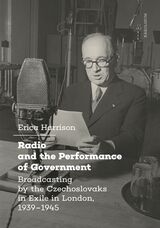 Radio and the Performance of Government: Broadcasting by the Czechoslovaks in Exile in London, 1939–1945
Erica Harrison
Karolinum Press, 2023 An original study of radio propaganda in Czechoslovakia.
Between 1939 and 1945, Czechoslovakia disappeared from the maps, existing only as an imagined ‘free republic’ on the radio waves. Following the German invasion and annexation of Bohemia and Moravia and the declaration of independence by Slovakia on 15 March 1939, the Czechoslovak Republic was gone. From their position in exile in wartime London, former Czechoslovak President Edvard Beneš and the government that formed around him depended on radio to communicate with the public they strove to represent. The broadcasts made by government figures in London enabled a performance of authority to impress their hosts, allies, occupying enemies, and claimed constituents.
This book examines this government program for the first time, making use of previously unstudied archival sources to examine how the exiles understood their mission and how their propaganda work was shaped by both British and Soviet influences. This study assesses the strengths, weaknesses, and limitations of the government’s radio propaganda as they navigated the complexities of exile, with chapters examining how they used the radio to establish their authority, how they understood the past and future of the Czechoslovak nation, and how they struggled to include Slovakia and Subcarpathian Ruthenia within it.
Radio Content in the Digital Age: The Evolution of a Sound Medium
Edited by Angeliki Gazi, Guy Starkey, and Stanislaw Jedrzejewski
Intellect Books, 2011 The traditional radio medium has seen significant changes in recent years as part of the current global shift toward multimedia content, with both digital and FM making significant use of new technologies, including mobile communications and the Internet. This book focuses on the important role these new technologies play—and will play as radio continues to evolve. This series of essays by top academics in the field examines new options for radio technology as well as a summary of the opportunities and challenges that characterize academic and professional debates around radio today.
 Radio Corpse: Imagism and the Cryptaesthetic of Ezra Pound
Daniel Tiffany
Harvard University Press, 1995 About the origins of Anglo-American poetic modernism, one thing is certain: it started with a notion of the image, described variously by Ezra Pound as an ideogram and a vortex. We have reason to be less confident, however, about the relation between these puzzling conceptions of the image and the doctrine of literary positivism that is generally held to be the most important legacy of Imagism. No satisfactory account exists, moreover, of what bearing these foundational principles may have on Pound's later engagement with fascism. Nor is it clear how figures such as the vortex and the ideogram might contribute generally to our understanding of modern visual culture and its compulsive appeal.
Radio Corpse addresses these issues and offers a fundamental revision of one of the most powerful and persistent aesthetic ideologies of modernism. Focusing on the necrophilic dimension of Pound's earliest poetry and on the inflections of materiality authorized by the modernist image, Daniel Tiffany establishes a continuum between Decadent practice and the incipient avant-garde, between the prehistory of the image and its political afterlife, between what Pound calls the "corpse language" of late Victorian poetry and a conception of the image that borrows certain "radioactive" qualities from the historical discovery of radium and the development of radiography. Emphasizing the phantasmic effects of translation (and exchange) in Pound's poetry, Tiffany argues that the cadaverous--and radiological--properties of the image culminate, formally and ideologically, in Pound's fascist radio broadcasts during World War II. Ultimately, the invisibility of these "radiant" images places in question basic assumptions regarding the optical character of images--assumptions currently being challenged by imageric technologies such as magnetic resonance imaging and positron emission tomography.
Radio Direction Finding and Superresolution
P.J.D. Gething
The Institution of Engineering and Technology, 1991 This is an enlarged and revised second edition of a book first published in 1978 and reprinted twice since then. The new edition includes updates to all the original chapters, plus two new chapters on developments in superresolution techniques and their application to direction-finding arrays.
 Radio Free Boston: The Rise and Fall of WBCN
Carter Alan
University Press of New England, 2013 Blaring the Cream anthem “I Feel Free,” WBCN went on the air in March 1968 as an experiment in free-form rock on the fledgling FM radio band. It broadcast its final song, Pink Floyd’s “Shine On You Crazy Diamond,” in August 2009. In between, WBCN became the musical, cultural, and political voice of the young people of Boston and New England, sustaining a vibrant local music scene that launched such artists as the J. Geils Band, Aerosmith, James Taylor, Boston, the Cars, and the Dropkick Murphys, as well as paving the way for Bruce Springsteen, Tom Petty, U2, and many others. Along the way, WBCN both pioneered and defined progressive rock radio, the dominant format for a generation of listeners. Brilliantly told by Carter Alan—and featuring the voices of station insiders and the artists they loved—Radio Free Boston is the story of a city; of artistic freedom, of music and politics and identity; and of the cultural, technological, and financial forces that killed rock radio.
 Radio Free Europe
Robert T. Holt
University of Minnesota Press, 1958 Radio Free Europe was first published in 1958. Minnesota Archive Editions uses digital technology to make long-unavailable books once again accessible, and are published unaltered from the original University of Minnesota Press editions. What is radio Free Europe? Where does it broadcast? Who runs it? What are its purposes? Although thousands of Americans are familiar with Radio Free Europe (many have contributed to its support through the Crusade for Freedom campaigns), few know enough about its background to answer these and similar questions. In this book a political scientist with first-hand knowledge gives a detailed account of the organization and development of this unique propaganda enterprise. Radio Free Europe was established as a private broadcasting project in 1949 by the Free Europe Committee, headed by Joseph C. Grew, as part of the Committee's program of broad, long-range assistance to democratic exiles from totalitarian countries. The operational headquarters are located at Munich, and the broadcasts are directed to the people of five satellite countries: Czechoslovakia, Hungary, Rumania, Bulgaria, and Poland. Professor Holt tells how Radio Free Europe was established, outlines its basic policies and objectives, describes its organization, personnel, programming, and services, discusses transmission problems, and examines the effectiveness of the propaganda. He describes in detail the role of RFE in connection with the uprisings in Poland and Hungary and analyzes the charges that RFE stimulated the Hungarian revolt.
Radio Free Stein: Gertrude Stein's Parlor Plays
Adam J. Frank
Northwestern University Press, 2025 Returns us to Gertrude Stein’s theater by way of the modernist medium of radio What happens when we listen to Gertrude Stein’s plays as radio and music theater? This book explores the sound of Stein’s theater and proposes that radio, when approached both historically and phenomenologically, offers technical solutions to her texts’ unique challenges. Adam J. Frank documents the collaborative project of staging Stein’s early plays and offers new critical interpretations of these lesser-known works. Radio Free Stein grapples with her innovative theater poetics from a variety of disciplinary perspectives: sound and media studies, affect and object relations theory, linguistic performativity, theater scholarship, and music composition.
Radio Frequency and Microwave Power Amplifiers: Efficiency and Linearity Enhancement Techniques, Volume 2
Andrei Grebennikov
The Institution of Engineering and Technology, 2019 Radio Frequency and Microwave Power Amplifiers are finding an increasingly broad range of applications, particularly in communications and broadcasting, but also in the industrial, medical, automotive, aviation, military, and sensing fields. Each application has its own design specifications, for example, high linearity in modern communication systems or high efficiency in broadcasting, and, depending on process technology, capability to operate efficiently at very high frequencies, such as 77 GHz and higher for automotive radars. Advances in design methodologies have practical applications in improving gain, power output, bandwidth, power efficiency, linearity, input and output impedance matching, and heat dissipation.
Radio Frequency and Microwave Power Amplifiers: Principles, Device Modeling and Matching Networks, Volume 1
Andrei Grebennikov
The Institution of Engineering and Technology, 2019 Radio Frequency and Microwave Power Amplifiers are finding an increasingly broad range of applications, particularly in communications and broadcasting, but also in the industrial, medical, automotive, aviation, military, and sensing fields. Each application has its own design specifications, for example, high linearity in modern communication systems or high efficiency in broadcasting, and, depending on process technology, capability to operate efficiently at very high frequencies, such as 77 GHz and higher for automotive radars. Advances in design methodologies have practical applications in improving gain, power output, bandwidth, power efficiency, linearity, input and output impedance matching, and heat dissipation.
Radio Frequency and Microwave Power Amplifiers: Theory, design and applications
Andrei Grebennikov
The Institution of Engineering and Technology, 2019 Radio Frequency and Microwave Power Amplifiers are finding an increasingly broad range of applications, particularly in communications and broadcasting, but also in the industrial, medical, automotive, aviation, military, and sensing fields. Each application has its own design specifications, for example, high linearity in modern communication systems or high efficiency in broadcasting, and, depending on process technology, capability to operate efficiently at very high frequencies, such as 77 GHz and higher for automotive radars. Advances in design methodologies have practical applications in improving gain, power output, bandwidth, power efficiency, linearity, input and output impedance matching, and heat dissipation.
Radio Frequency and Microwave Power Measurement
Alan E. Fantom
The Institution of Engineering and Technology, 1990 The need to measure electrical power is common to many branches of science and engineering. This book presents a wide-ranging survey of the many types of radio-frequency and microwave power meter and the techniques which are used for calibrating and intercomparing them. The frequency range is 1 MHz to 200 GHz.
Radio Frequency Interference (RFI) Pocket Guide
Kenneth Wyatt
The Institution of Engineering and Technology, 2015 This handy pocket guide to essential radio frequency interference (RFI) is a valuable, pocket-sized reference for radio amateurs and others in the radio communication fields.
Radio Man: The remarkable rise and fall of C.O. Stanley
Mark Frankland
The Institution of Engineering and Technology, 2002 Radio Man tells the story of C.O. Stanley, the unconventional Irishman who acquired Pye Radio at the beginning of the broadcasting age. Although he started with little experience and even less money, he was to make Pye a major player in the British electronics industry - only to crash it spectacularly forty years later. From the romance of early radio to the birth of the mobile, Stanley and Pye were players in some of the key moments of twentieth century Britain. His obsession with the infant medium of television allowed Pye to provide the equipment that put radar into planes in time for the Battle of Britain. His energy also drove Pye's pioneering work on the proximity fuse - work that would revolutionise antiaircraft warfare - and the company's manufacture of the war's most successful army radios.
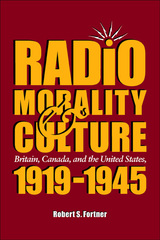 Radio, Morality, & Culture: Britain, Canada, and the United States, 1919 - 1945
Robert S. Fortner
Southern Illinois University Press, 2005 Radio, Morality, and Culture: Britain, Canada, and the United States, 1919–1945 examines the moral controversies surrounding radio’s development during its formative years. In comparing the fledgling medium in Great Britain, Canada, and the United States, Robert S. Fortner documents how the church failed to participate in radio’s moral development and instead engaged in internecine warfare over issues of legitimacy and orthodoxy. The church was arguing about theological turf and dealing with internal disputes while radio policy was being developed and communications history was being written. Fortner reveals how the church, doomed to play little more than a bit part in the future of radio, eventually lost its voice altogether in the continuing development of electronic media. Fortner effectively synthesizes cultural history and theory, communication studies, and the role religious organizations played in shaping the content and character of early radio. Geared to scholars of history, communications, and theology, Radio, Morality, and Culture provides a useful resource for research, scholarship, and public policy.
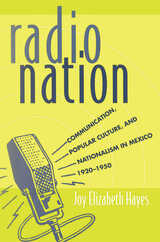 Radio Nation: Communication, Popular Culture, and Nationalism in Mexico, 1920-1950
Joy Elizabeth Hayes
University of Arizona Press, 2000 The role of mass communication in nation building has often been underestimated, particularly in the case of Mexico. Following the Revolution, the Mexican government used the new medium of radio to promote national identity and build support for the new regime. Joy Hayes now tells how an emerging country became a radio nation. This groundbreaking book investigates the intersection of radio broadcasting and nation building. Hayes tells how both government-controlled and private radio stations produced programs of distinctly Mexican folk and popular music as a means of drawing the country's regions together and countering the influence of U.S. broadcasts. Hayes describes how, both during and after the period of cultural revolution, Mexican radio broadcasting was shaped by the clash and collaboration of different social forces--including U.S. interests, Mexican media entrepreneurs, state institutions, and radio audiences. She traces the evolution of Mexican radio in case studies that focus on such subjects as early government broadcasting activities, the role of Mexico City media elites, the "paternal voice" of presidential addresses, and U.S. propaganda during World War II. More than narrative history, Hayes's study provides an analytical framework for understanding the role of radio in building Mexican nationalism at a critical time in that nation's history. Radio Nation expands our appreciation of an overlooked medium that changed the course of an entire country.
 The Radio Noise Spectrum
Donald H. Menzel
Harvard University Press This modern era has had many names: the golden age, the machine age, the atomic age, the electronic age, and so on. One further title, hitherto unpublicized, it eminently deserves: the age of noise. Man has compounded the natural noise that preceded his existence on the earth until no point on this globe is free from it. Even in the desert's hush, radio waves pervade the air and provide a source of potential noise. The shorter waves escape from the earth and fill interplanetary space with the mingled clamor of FM, TV, radar, and other insistent voices.
This book deals with the important problem of radio noise, its sources, whether manmade or natural, over the known range of frequencies. Certain of these contributions will interest the communicator, enabling him to estimate the potential interference from various types of sources. Other contributions deal mainly with scientific problems, such as the origins and significance of certain characteristic noise radiations.
The contributors to this book are experts on the various phases of radio noise. The individual chapters derive from papers presented at a Conference on Radio Noise, held at Harvard College Observatory, April 22, 1958.
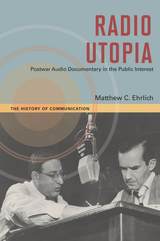 Radio Utopia: Postwar Audio Documentary in the Public Interest
Matthew Ehrlich
University of Illinois Press, 2017 As World War II drew to a close and radio news was popularized through overseas broadcasting, journalists and dramatists began to build upon the unprecedented success of war reporting on the radio by creating audio documentaries. Focusing particularly on the work of radio luminaries such as Edward R. Murrow, Fred Friendly, Norman Corwin, and Erik Barnouw, Radio Utopia: Postwar Audio Documentary in the Public Interest traces this crucial phase in American radio history, significant not only for its timing immediately before television, but also because it bridges the gap between the end of the World Wars and the beginning of the Cold War. Matthew C. Ehrlich closely examines the production of audio documentaries disseminated by major American commercial broadcast networks CBS, NBC, and ABC from 1945 to 1951. Audio documentary programs educated Americans about juvenile delinquency, slums, race relations, venereal disease, atomic energy, arms control, and other issues of public interest, but they typically stopped short of calling for radical change. Drawing on rare recordings and scripts, Ehrlich traces a crucial phase in the evolution of news documentary, as docudramas featuring actors were supplanted by reality-based programs that took advantage of new recording technology. Paralleling that shift from drama to realism was a shift in liberal thought from dreams of world peace to uneasy adjustments to a cold war mentality. Influenced by corporate competition and government regulations, radio programming reflected shifts in a range of political thought that included pacifism, liberalism, and McCarthyism. In showing how programming highlighted contradictions within journalism and documentary, Radio Utopia reveals radio's response to the political, economic, and cultural upheaval of the post-war era.
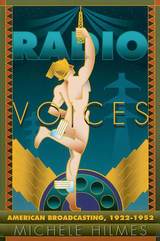 Radio Voices: American Broadcasting, 1922-1952
Michele Hilmes
University of Minnesota Press, 1997 The Shadow. Fibber McGee and Molly. Amos 'n' Andy. When we think back on the golden age of radio, we think of the shows. In Radio Voices, Michele Hilmes looks at the way radio programming influenced and was influenced by the United States of the 1920s, 1930s, and 1940s, tracing the history of the medium from its earliest years through the advent of television.
Hilmes places the development of radio within the context of the turmoils of the 1920s: immigration and urbanization, the rise of mass consumer culture, and the changing boundaries of the public and private spheres. Early practices and structures--the role of the announcer, the emergence of program forms from vaudeville, minstrel shows, and the concert stage--are examined.
Central to Radio Voices is a discussion of programs and their relations to popular understandings of race, ethnicity, and gender in the United States of this era. Hilmes explores Amos 'n' Andy and its negotiations of racial tensions and The Rise of the Goldbergs and its concern with ethnic assimilation. She reflects upon the daytime serials--the first soap operas--arguing that these much-disparaged programs provided a space in which women could discuss conflicted issues of gender. Hilmes also explores industry practices, considering the role of advertising agencies and their areas of conflict and cooperation with the emerging networks as well as the impact of World War II on the "mission" of radio.
Radio Voices places the first truly national medium of the United States in its social context, providing an entertaining account of the interplay between programming and popular culture.
"Radio Voices is the most-cited publication in a recent spate of cultural studies of radio. Hilmes analyzes the early practices and programs of radio-such as the daytime serial drama that would evolve into the soap opera-in relation to the emergence, after World War I, of mass consumerism. She argues that, as the United States rose to world power during the Age of Radio, the medium was crucial in helping to form an American national identity and to blur the boundaries between the public and private spheres." Chronicle of Higher Education
"Hilmes offers a fresh, exciting, path-breaking and insightful history of radio broadcasting. Radio Voices provides an innovative and accessible history of U.S. broadcasting that promises to inspire a new wave of critical cultural analysis of the radio era. Radio Voices may prove to be the most important for the research it promises to inspire by rethinking and enlivening the field of radio history." Journal of Communication
"The title, Radio Voices, is well chosen: the voices of the radio pioneers, which one might too easily assume to be irrecoverable, emerge through the book's frequent extracts from correspondence and scripts. Radio Voices will remind scholars of popular culture of the pleasures and rewards of archival study." Journal of American History
"The author's extensive research has turned up many delicious tales not recounted elsewhere." Historical Journal of Film, Radio, and Television
Radio Wave Propagation in Vehicular Environments
Leyre Azpilicueta
The Institution of Engineering and Technology, 2021 Providing a unified treatment of radio wave propagation in vehicular environments, this book offers a thorough discussion of their theoretical background and fundamental limits, and paves the way to a better understanding of more advanced topics. Further, the book introduces the newest challenges and problems posed by the ever growing need to communicate in mobile networks whilst in a vehicle.
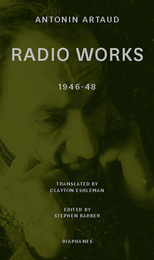 Radio Works: 1946-48
Antonin Artaud
Diaphanes, 2020 Following his release from the Rodez asylum, Antonin Artaud decided he wanted his new work to connect with a vast public audience, and he chose to record radio broadcasts in order to carry through that aim. That determination led him to his most experimental and incendiary project, To Have Done with the Judgement of God, 1947-48, in which he attempted to create a new language of texts, screams, and cacophonies: a language designed to be heard by millions, aimed, as Artaud said, for “road-menders.” In the broadcast, he interrogated corporeality and introduced the idea of the “body without organs,” crucial to the later work of Deleuze and Guattari. The broadcast, commissioned by the French national radio station, was banned shortly before its planned transmission, much to Artaud’s fury. This volume collects all of the texts for To Have Done with the Judgement of God, together with several of the letters Artaud wrote to friends and enemies in the short period between his work’s censorship and his death. Also included is the text of an earlier broadcast from 1946, Madness and Black Magic, written as a manifesto prefiguring his subsequent broadcast. Clayton Eshleman’s extraordinary translations of the broadcasts activate these works in their extreme provocation.
Radioactive Documentary: Filming the Nuclear Environment after the Cold War
Helen Hughes
Intellect Books, 2021 Helen Hughes explores ten different documentary films made in Europe and North America since 1989 that explore the atomic age: Volker Koepp’s Die Wismut, Suzan Baraza’s Uranium Drive-In, Toshi Fujiwara’s Mujin Chitai, Nikolaus Geyrhalter’s Pripyat, Michael Madsen’s Into Eternity, Peter Galison and Rob Moss’s Containment, Volker Sattel’s Unter Kontrolle, Ivy Meerapol’s Indian Point, Rob Stone’s Pandora’s Promise, Mika Taanila and Jussi Eerola’s Atomin Paluu, and Mark Cousin’s Atomic: Living in Dread and Promise.
In her coherent, accessible analysis of the representation of radioactive spaces in documentary and experimental art films, Hughes shows us how the documentary form itself can help reimagine the relationships between people and their environments.
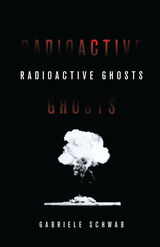 Radioactive Ghosts
Gabriele Schwab
University of Minnesota Press, 2020 A pioneering examination of nuclear trauma, the continuing and new nuclear peril, and the subjectivities they generate
Amid resurgent calls for widespread nuclear energy and “limited nuclear war,” the populations that must live with the consequences of these decisions are increasingly insecure. The nuclear peril combined with the looming threat of climate change means that we are seeing the formation of a new kind of subjectivity: humans who are in a position of perpetual ontological insecurity. In Radioactive Ghosts, Gabriele Schwab articulates a vision of these “nuclear subjectivities” that we all live with.
Focusing on the legacies of the Manhattan Project, Hiroshima, and nuclear energy politics, Radioactive Ghosts takes us on a tour of the little-seen sides of our nuclear world. Examining devastating uranium mining on Native lands, nuclear sacrifice zones, the catastrophic accidents at Chernobyl and Fukushima, and the formation of a new transspecies ethics, Schwab shows how individuals threatened with extinction are creating new adaptations, defenses, and communal spaces. Ranging from personal accounts of experiences with radiation to in-depth readings of literature, film, art, and scholarly works, Schwab gives us a complex, idiosyncratic, and personal analysis of one of the most overlooked issues of our time.
Radioapocrypha
BK Fischer
Ohio State University Press, 2018 A novella in verse, Radioapocrypha envisions what would have happened if Jesus Christ had arrived for the first time not in Palestine two thousand years ago but in a subdivision in Maryland in 1989, the year Depeche Mode released “Personal Jesus.” In this suburban retelling of the gospel, Jesus is a hunky post-punk high school chemistry teacher and the disciples are a twelve-member garage band. The story unfolds as recorded testimony and overheard teachings, a series of alternating lyric poems, prose poems, and parables that engage the social, sexual, and racial tensions of an era. Told from the point of view of the Magdalen character, named Maren—and drawing from the Gnostic text known as the Gospel of Mary as well as other scriptural sources—these poems sample widely from popular music and 1980s culture to recast and revivify a gritty, surreal, crackpot story of loners, losers, and lovers.
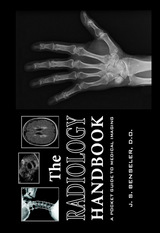 The Radiology Handbook: A Pocket Guide to Medical Imaging
J. S. Benseler
Ohio University Press, 2006 Designed for busy medical students, The Radiology Handbook is a quick and easy reference for any practitioner who needs information on ordering or interpreting images.
The book is divided into three parts:
- Part I presents a table, organized from head to toe, with recommended imaging tests for common clinical conditions.
- Part II is organized in a question and answer format that covers the following topics: how each major imaging modality works to create an image; what the basic precepts of image interpretation in each body system are; and where to find information and resources for continued learning.
- Part III is an imaging quiz beginning at the head and ending at the foot. Sixty images are provided to self-test knowledge about normal imaging anatomy and common imaging pathology.
Published in collaboration with the Ohio University College of Osteopathic Medicine, The Radiology Handbook is a convenient pocket-sized resource designed for medical students and non radiologists.
 Radiophonic Feminisms: Latina Voices in the Digital Age of Broadcasting
Esther Díaz Martín
University of Texas Press, 2025 How Latina voices in commercial radio and podcasting subvert cultural norms and bring feminism to the fore of their work. What does Latina feminism sound like in popular culture? Drawing on case studies of commercial radio programs and podcasts hosted by Latinas and oriented toward Latinx listenership, Esther Díaz Martín explores how Latina voices create female-specific aural spaces that interrupt the misogynist status quo in US mainstream media. Radiophonic Feminisms focuses on radio/podcasting as a medium in which women find methods for resisting oppressive gendered cultural imaginaries. Through their specific articulations—that is, the quality of their voices—their music choices, and the soundscapes they construct, Latina hosts since the early 1990s have offered feminist responses to a cultural moment marked by the demographic changes brought on by the political economy of migration and the social changes wrought by media in the digital age. Drawing attention to the invisible antisexist work of creating sound, and to its reception, Díaz Martín bridges the epistemic insights of Chicana feminist theory and sound studies, enriching and further decolonizing our thinking about auditory meaning making.
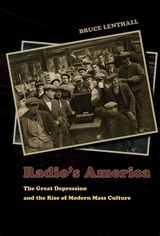 Radio's America: The Great Depression and the Rise of Modern Mass Culture
Bruce Lenthall
University of Chicago Press, 2007 Orson Welles’s greatest breakthrough into the popular consciousness occurred in 1938, three years before Citizen Kane, when his War of the Worlds radio broadcast succeeded so spectacularly that terrified listeners believed they were hearing a genuine report of an alien invasion—a landmark in the history of radio’s powerful relationship with its audience. In Radio’s America, Bruce Lenthall documents the enormous impact radio had on the lives of Depression-era Americans and charts the formative years of our modern mass culture.
Many Americans became alienated from their government and economy in the twentieth century, and Lenthall explains that radio’s appeal came from its capability to personalize an increasingly impersonal public arena. His depictions of such figures as proto-Fascist Charles Coughlin and medical quack John Brinkley offer penetrating insight into radio’s use as a persuasive tool, and Lenthall’s book is unique in its exploration of how ordinary Americans made radio a part of their lives. Television inherited radio’s cultural role, and as the voting tallies for American Idol attest, broadcasting continues to occupy a powerfully intimate place in American life. Radio’s America reveals how the connections between power and mass media began.
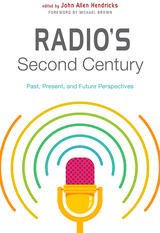 Radio's Second Century: Past, Present, and Future Perspectives
John Allen Hendricks
Rutgers University Press, 2020 Winner of the 2022 Broadcast Education Association Book Award
One of the first books to examine the status of broadcasting on its one hundredth anniversary, Radio’s Second Century investigates both vanguard and perennial topics relevant to radio’s past, present, and future. As the radio industry enters its second century of existence, it continues to be a dominant mass medium with almost total listenership saturation despite rapid technological advancements that provide alternatives for consumers. Lasting influences such as on-air personalities, audience behavior, fan relationships, and localism are analyzed as well as contemporary issues including social and digital media. Other essays examine the regulatory concerns that continue to exist for public radio, commercial radio, and community radio, and discuss the hindrances and challenges posed by government regulation with an emphasis on both American and international perspectives. Radio’s impact on cultural hegemony through creative programming content in the areas of religion, ethnic inclusivity, and gender parity is also explored. Taken together, this volume compromises a meaningful insight into the broadcast industry’s continuing power to inform and entertain listeners around the world via its oldest mass medium--radio.
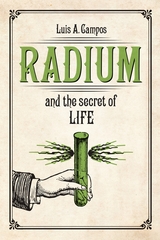 Radium and the Secret of Life
Luis A. Campos
University of Chicago Press, 2015 Before the hydrogen bomb indelibly associated radioactivity with death, many chemists, physicians, botanists, and geneticists believed that radium might hold the secret to life. Physicists and chemists early on described the wondrous new element in lifelike terms such as “decay” and “half-life,” and made frequent references to the “natural selection” and “evolution” of the elements. Meanwhile, biologists of the period used radium in experiments aimed at elucidating some of the most basic phenomena of life, including metabolism and mutation.
From the creation of half-living microbes in the test tube to charting the earliest histories of genetic engineering, Radium and the Secret of Life highlights previously unknown interconnections between the history of the early radioactive sciences and the sciences of heredity. Equating the transmutation of radium with the biological transmutation of living species, biologists saw in metabolism and mutation properties that reminded them of the new element. These initially provocative metaphoric links between radium and life proved remarkably productive and ultimately led to key biological insights into the origin of life, the nature of heredity, and the structure of the gene. Radium and the Secret of Life recovers a forgotten history of the connections between radioactivity and the life sciences that existed long before the dawn of molecular biology.
 Radium Girl
Celeste Lipkes
University of Wisconsin Press, 2023 The poems in Radium Girl hold dual citizenship in the land of the sick and the kingdom of the well. The point where illusion ends and reality begins is never clear, as Celeste Lipkes evokes saints, magicians, scientists, and caregivers in the process of surviving both medical illness and medical training. Slippery metaphors of rabbits in hats, doves in cages, and elaborate escapes explore the inhabitation of a female body as a kind of powerful and violent performance—where the magician’s trick of cutting a woman in half is never as far away as we’d like. With humor (“When the doctor says, ‘We found something,’ / I don’t say: ‘no shit’ or ‘oh thank God, / I’ve been looking for that sweater everywhere,’”) and heartbreak (“Every evening I count the dwindling brass coins / of my patient’s platelets while his wife ices / cups of ginger ale he will never drink”), Lipkes reminds us what it means to feel human, to feel afraid, to feel hopeful, to feel. I am the magician, even,
some nights alone,
finding inside the darkness
a small, trembling thing
I won’t acknowledge as my own.
This is someone else’s rabbit,
I say, and the silence nods back.
—Excerpt from “Rabbit”
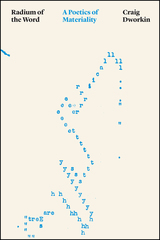 Radium of the Word: A Poetics of Materiality
Craig Dworkin
University of Chicago Press, 2020 With fresh insight and contemporary relevance, Radium of the Word argues that a study of the form of language yields meanings otherwise inaccessible through ordinary reading strategies. Attending to the forms of words rather than to their denotations, Craig Dworkin traces hidden networks across the surface of texts, examining how typography, and even individual letters and marks of punctuation, can reveal patterns that are significant without being symbolic—fully meaningful without communicating any preordained message.
Radium of the Word takes its title from Mina Loy’s poem for Gertrude Stein, which hails her as the Madame “Curie / of the laboratory / of vocabulary.” In this spirit, Dworkin considers prose as a dynamic literary form, characterized by experimentation. Dworkin draws on examples from writers as diverse as Lyn Hejinian, William Faulkner, and Joseph Roth. He takes up the status of the proper name in Modernism, with examples from Stein, Loy, and Guillaume Apollinaire, and he offers in-depth analyses of individual authors from the counter-canon of the avant-garde, including P. Inman, Russell Atkins, N. H. Pritchard, and Andy Warhol. The result is an inspiring intervention in contemporary poetics.
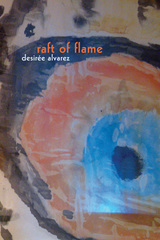 Raft of Flame
Desirée Alvarez
Omnidawn, 2019 A painter and poet, Desirée Alvarez engages with the powerful forces of lyric and rhythm to create a collection that moves across time and place. Inspired by Lorca’s passionate cante jondo, or “deep song,” and her own family history with Andalusian flamenco, Alvarez weaves together a time-travelling epic that searches through myth, culture, and nature for the roots of identity. Navigating both her Latina and European heritage through works by artists of the ancient Americas and Spain, Alvarez maps intersections between personal and political history. Searching narratives both fictitious and real, Raft of Flame includes imagined conversations between a conquistador and an Olmec sculpture, between Frida Kahlo and Velazquez, and between The Wizard of Oz’s Dorothy and Glinda the Good Witch.
In Raft of Flame, Alvarez constructs and fleshes out a fantastic narrative of personal and cultural history, offering glimpses into the art, history, and land that comprise her story. Her narrative explores how both nature and human populations continue to be trapped in the violence of colonialism. Vivid lyrics interrogate the complexities of mixed race, digging the dualities, upheavals, and casts of characters that underly Alvarez’s identity.
Raft of Flame won Omnidawn's 2018 Lake Merritt Prize.
A Raft of Grief
Chelsea Rathburn
Autumn House Press, 2013 Winner of the 2012 Autumn House Press Poetry Contest, selected by Stephen Dunn, Chelsea Rathburn's second collection continues to amaze with her ability to direct a clear poet's gaze on every aspect of life. Working in both free-verse and form, this book solidfies Rathburn as an essential voice for contemporary poetry.
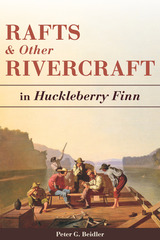 Rafts and Other Rivercraft: in Huckleberry Finn
Peter G. Beidler
University of Missouri Press, 2018 The raft that carries Huck and Jim down the Mississippi River is often seen as a symbol of adventure and freedom, but the physical specifics of the raft itself are rarely considered. Peter Beidler shows that understanding the material world of Huckleberry Finn, its limitations and possibilities, is vital to truly understanding Mark Twain’s novel. He illustrates how experts on Twain’s works have misinterpreted important aspects of the story due to their unfamiliarity with the various rivercraft that figure in the book.
Huck and Jim’s little raft is not made of logs, as it is often depicted in illustrations, but of sawn planks, and it was originally part of a much larger raft. Beidler explains why this matters and describes the other rivercraft that appear in the book. He gives what will almost certainly be the last word on the vexed question of whether the lengthy “raft episode,” removed at the publisher’s suggestion from the novel, should be restored to its original place.
Rafts, Raccons, & Revelations: Growing Up on a Great Lake
Pete Griffin
Parkhurst Brothers, Inc., 2021 Man recounts his boyhood in sparsely populated, near-wilderness area along the USA-Canada border, with an emphasis on encounters with wildlife and natural phenomena and conclusions/observations of human nature and the intersection of civilization as it meets the natural world.
RAG
Julie Carr
Omnidawn, 2014 The question of civic lyric—the possibility of a politics of mourning—runs through this book-length aria-errancy-eros. All vectors of “rag” are at work: polemic political journal, syncopated turn-of-century song, menstrual blood, burial shroud, complaint, insult, a wiping cloth, the barest semblance of clothes, the slang word for woman. The energy running beneath this rag is human violence and sexual force erupting through fragments of film, fairy tale, news, novels: a father on fire, stranger in tears, prisoner who believes he’s a dog, women dressed in food, women refusing to eat, a body with no face, or a face with no skin. RAG spirals forward, picking up recurrent language, its narratives troubled by stutter, broken by what can’t be told.
RAGBRAI: Everyone Pronounces It Wrong
John Karras
University of Iowa Press, 2009 RAGBRAI: Everyone Pronounces It Wrong is a celebration, a memoir, an entertainment. The book deals with the first 25 years of the famous bike ride. It describes the genesis of an event that has drawn hundreds of thousands of people to Iowa from all over the world and attempts to explain the ride's continued charm and appeal. RAGBRAI is different from all other bicycle tours. The others, and there are dozens of cross-state rides held in the United States, attract mostly serious, dedicated cyclists who clench their teeth and ride hard all day. RAGBRAI has its share of these cyclists, but it's more inclusive. It is a huge, week long celebration with dancing in the streets and evening entertainments. It is a love affair between bicycle riders and the people of Iowa. The book captures the essence of all that.
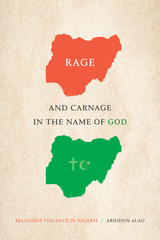 Rage and Carnage in the Name of God: Religious Violence in Nigeria
Abiodun Alao
Duke University Press, 2022 In Rage and Carnage in the Name of God, Abiodun Alao examines the emergence of a culture of religious violence in postindependence Nigeria, where Christianity, Islam, and traditional religions have all been associated with violence. He investigates the root causes and historical evolution of Nigeria’s religious violence, locating it in the forced coming together of disparate ethnic groups under colonial rule, which planted the seeds of discord that religion, elites, and domestic politics exploit. Alao discusses the histories of Christianity, Islam, and traditional religions in the territory that became Nigeria, the effects of colonization on the role of religion, the development of Islamic radicalization and its relation to Christian violence, the activities of Boko Haram, and how religious violence intermixes with politics and governance. In so doing, he uses religious violence as a way to more fully understand intergroup relations in contemporary Nigeria.
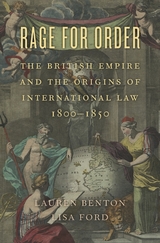 Rage for Order: The British Empire and the Origins of International Law, 1800–1850
Lauren Benton and Lisa Ford
Harvard University Press, 2016 International law burst on the scene as a new field in the late nineteenth century. Where did it come from? Rage for Order finds the origins of international law in empires—especially in the British Empire’s sprawling efforts to refashion the imperial constitution and use it to order the world in the early part of that century.
“Rage for Order is a book of exceptional range and insight. Its successes are numerous. At a time when questions of law and legalism are attracting more and more attention from historians of 19th-century Britain and its empire, but still tend to be considered within very specific contexts, its sweep and ambition are particularly welcome…Rage for Order is a book that deserves to have major implications both for international legal history, and for the history of modern imperialism.”
—Alex Middleton, Reviews in History
“Rage for Order offers a fresh account of nineteenth-century global order that takes us beyond worn liberal and post-colonial narratives into a new and more adventurous terrain.”
—Jens Bartelson, Australian Historical Studies
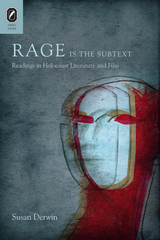 Rage Is the Subtext: Readings in Holocaust Literature and Film
Susan Derwin
Ohio State University Press, 2012 Rage Is the Subtext charts the internal shifts of Holocaust survivors who tell their stories of suffering, loss, and endurance. Susan Derwin locates the healing effect of literary testimony in its capacity to represent the reactions of survivors to traumatic experience, while concealing other more unsettling responses from view. Beneath the explicit concerns of works by Primo Levi, Saul Friedländer, Binjamin Wilkomirski, Imre Kertész and Liliana Cavani, Derwin uncovers unspoken reserves of rage, which then become legible as formal properties of the text. Drawing upon the analytic writings of D. W. Winnicott, Jean Améry, and others, Derwin identifies the volatile affect encrypted in testimonial narrative with experiences of social abandonment. She argues that, after liberation, many survivors were beset by an irresolvable ambivalence: on one side, they bitterly blamed their communities for abandoning them during the Holocaust; on the other, they desperately needed reconciliation with those communities in order to heal. For this reason, bearing witness became a crucial activity that contained and metabolized the survivor's rage so that an engaged life could become possible.
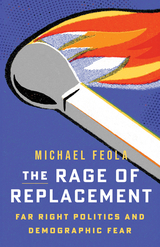 The Rage of Replacement: Far Right Politics and Demographic Fear
Michael Feola
University of Minnesota Press, 2024 Tracing how the “Great Replacement” narrative has shaped far-right extremism and propelled its dangerous political projects and acts of violence
The “Great Replacement” narrative, which imagines that historic white majorities are being intentionally replaced through immigration policies crafted by global elites, has effectively mobilized racist, nationalist, and nativist movements in the United States and Europe. The Rage of Replacement tracks how this narrative has shaped the politics and worldview of the far right, binding its various camps into a community of rage obsessed with nostalgia for a white-supremacist past. Showing how the replacement narrative has found significant purchase in recent mainstream discourse through the rise of Trumpism, right-wing media figures like Tucker Carlson, and events such as 2017’s “Unite the Right” rally in Charlottesville, Virginia, Michael Feola diagnoses the dangers this racist theory poses as it shapes the far-right imagination, expands through civil society, and deforms political culture. In particular, he tracks how the replacement narrative has given rise to malignant political strategies designed to “take back” the nation from its perceived enemies—by force if deemed necessary. Identifying the Great Replacement narrative as a central force behind the rise and expansion of far-right extremism, Feola shows how it has motivated a variety of dangerous political projects in pursuit of illiberal, antidemocratic futures. From calls for the creation of segregated white ethnostates to extremist violence such as the mass shootings in Christchurch, El Paso, and Buffalo, The Rage of Replacement makes clear that replacement theory poses a dire threat to democracy and safety.
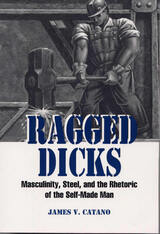 Ragged Dicks: Masculinity, Steel, and the Rhetoric of the Self-Made Man
James V. Catano
Southern Illinois University Press, 2001 Portraits of self-made men are rife in Western culture, as James V. Catano observes. Positive and negative, admittedly fictional and ostensibly factual, these portraits endure because the general rhetorical practice embodied in the myth of the self-made man enacts both the need and the very means for making oneself masculine: verbal power and prowess. The myth of the self-made man, in short, is part of ongoing rhetorical practices that constitute society, culture, and subjects. To explain those practices and their effectiveness, Catano argues that the basic narrative achieves much of its effectiveness by engaging and enacting the traditional psychological dynamics of the family romance: preoedipal separation, oedipal conflict, and “proper” postoedipal self-definition and socialization. To focus on the combined social, psychological, and rhetorical dynamics that constitute the ongoing activity he calls masculine self-making, Catano emphasizes a particular strand: masculinity and steelmaking. Pursuing that strand, he argues that these representations of masculine self-making are rhetorical enactments of cultural needs and desires, and that they are ongoing and formative arguments about what society and its individuals either are or should be.
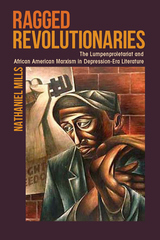 Ragged Revolutionaries: The Lumpenproletariat and African American Marxism in Depression-Era Literature
Nathaniel Mills
University of Massachusetts Press, 2017 In Marxism, the concept of the lumpenproletariat refers to the masses in rags, outsiders on the edge of society, drifters and criminals, of little or no use politically. But in Ragged Revolutionaries, Nathaniel Mills argues that the lumpenproletariat was central to an overlooked yet vibrant mode of African American Marxism formulated during the Great Depression by black writers on the Communist left.
By analyzing multiple published and unpublished works from the period, Mills shows how Richard Wright, Ralph Ellison, and Margaret Walker used the lumpenproletariat to imagine new forms of revolutionary knowledge and agency. In their writings, hobos riding the rails, criminals hustling to make ends meet, heroic black folk-outlaws, and individuals who fall out of the proletariat into the social margins all furnish material for thinking through resistance to the exploitations of capitalism, patriarchy, and Jim Crow. Ragged Revolutionaries introduces the lumpenproletariat into literary study, offers a new account of the place of Marxism in African American literature and politics, and clarifies the political and aesthetic commitments of three major modern black writers.
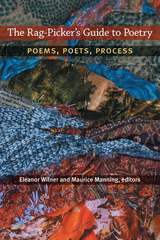 The Rag-Picker's Guide to Poetry: Poems, Poets, Process
Eleanor Wilner and Maurice Manning, editors
University of Michigan Press, 2013 The venture of this inviting collection is to look, from the many vantages that the 35 poets in this eclectic anthology chose to look, at what it was—knowing that a poem can’t be conceived in advance of its creation—that helped their poems to emerge or connected them over time. The Rag-Picker's Guide to Poetry permits an inside view of how poets outwit internal censors and habits of thought, showing how the meticulous and the spontaneous come together in the process of discovery. Within are contained the work and thoughts of: - Betty Adcock
- Joan Aleshire
- Debra Allbery
- Elizabeth Arnold
- David Baker
- Rick Barot
- Marianne Boruch
- Karen Brennan
- Gabrielle Calvocoressi
- Michael Collier
- Carl Dennis
- Stuart Dischell
- Roger Fanning
- Chris Forhan
- Reginald Gibbons
- Linda Gregerson
- Jennifer Grotz
- Brooks Haxton
- Tony Hoagland
- Mark Jarman
- A. Van Jordan
- Laura Kasischke
- Mary Leader
- Dana Levin
- James Longenbach
- Thomas Lux
- Maurice Manning
- Heather McHugh
- Martha Rhodes
- Alan Shapiro
- Daniel Tobin
- Ellen Bryant Voigt
- Alan Williamson
- Eleanor Wilner
- C. Dale Young
 Rai Mythology: Kiranti Oral Texts
Karen H. Ebert and Martin Gaenszle
Harvard University Press The more than two dozen Rai languages in eastern Nepal, which make up the larger part of the Kiranti language family, are linguistically highly varied. Due to this, intergroup solidarity has been relatively weak, and Rai ethnicity must be seen as constructed in recent history. However, it is striking how the mythological narratives of these different Rai “subtribes”—oral stories about the origins of culture and the deeds of the ancestors—form a strong and coherent tradition in which the different variants of episodes possess an obvious “family resemblance.” This mythological tradition is clearly distinct from those of the neighboring Limbu, the other major Kiranti group.
This volume, which includes introductory chapters to Rai mythology and Rai grammar, for the first time brings together different variants of myths from various Rai languages, presenting them with linguistic glossings in interlinear translations. This makes it possible not only to study the myths and their cultural meanings as oral texts but also to compare narrative structures across different grammars. The book is of special interest for linguists, anthropologists, and folklorists with a focus on the Himalayas.
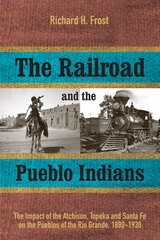 The Railroad and the Pueblo Indians: The Impact of the Atchison, Topeka and Santa Fe on the Pueblos of the Rio Grande, 1880-1930
Richard H. Frost
University of Utah Press, 2015 The history of the railroad conquest of the West is well known, but the impact of western railroads on Native Americans has largely been ignored. Richard Frost examines the profound effects that the coming of trains had on Pueblo Indians in New Mexico's Rio Grande Valley. The arrival of the railroad was a social and cultural tsunami. It destroyed or damaged crops, livestock, irrigation ditches, community autonomy, privacy, and well-being. The trains brought lawyers, speculators, politicians, missionaries, anthropologists, timber thieves, health seekers, and government servants. American colonialism abetted the railroads, so that the Pueblos faced land and water confiscation, court cases, compulsory American education, and other transgressions. To be sure, the trains also brought farm tools, clothing for children, and customers for Pueblo pottery; but these were comparatively marginal benefits.
The Pueblo communities responded variously, though mostly conservatively to sustain their traditional communities. This book spotlights two very different responses. Santo Domingo's reaction was hostile, but Laguna chose accommodation. These reactions reveal previously overlooked aspects of these pueblos’ histories that provide compelling reasons behind their varying responses. The book also analyzes the self-contradictory nature of Pueblo constitutional law from 1876 to 1913 and describes conflicted Bureau of Indian Affairs treatment of the Pueblos in the late nineteenth and early twentieth centuries. Each in turn had fateful consequences.
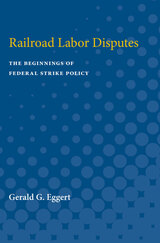 Railroad Labor Disputes: The Beginnings of Federal Strike Policy
Gerald G. Eggert
University of Michigan Press, 1967 At Martinsburg, West Virginia, on July 16, 1877, angry laborers struck the B & O Railroad because of a 10 percent wage cut. Spontaneous strikes soon choked railroad service from Baltimore to St. Louis and from Buffalo to Louisville. The violent wave of discontent developed into the country's first national labor crisis. The use of federal troops to restore order was only one of many decisions—sometimes blundering or biased, sometimes enlightened—the government would make during the next twenty years in coping with railway strikes. Not until the defeat of the Pullman Strike in 1894 did railway labor disorders subside. Railroad Labor Disputes describes the federal government's methods of dealing with railroad labor problems in the last quarter of the nineteenth century and shows how the beginnings of federal strike policy evolved. To explain the bias of government officials against the working man and for railroad management, Gerald Eggert examines the backgrounds, interests, and ambitions of the shapers of federal policy. Eggert also underscores the lack of congressional leadership and the erratic planning of the executive branch, which compelled the federal courts to play a large part in making policy. Particularly in times of crisis, accident and chance determined the policy as much as reason and forethought. Occasionally decisions supported strikers, but policy became increasingly anti-labor in its bias. "Riots" and "insurrections" were quelled by troops; "conspiring to obstruct the mails" justified federal strikebreaking; hampering interstate commerce produced federal reprisal. Court injunctions were first used to protect railroads in receivership, later any railroad at any time. Strikes were even judged violations of the Sherman Antitrust Act. After the Pullman strike of 1894, government policy grew more reasonable. Eggert emphasizes that the Erdman Act reflected this trend. Thereafter, railroad officials increasingly accepted the principle of collective bargaining.
 Railroad Postcards In Age Steam
H. Roger Grant
University of Iowa Press, 1994
Out of the tradition of those long-gone days of great, heaving steam locomotives and endless rail lines comes this remarkable selection of vintage cards, a treasure trove selected from John Vander Maas' consummate collection at the University of Iowa Libraries.
This lavish volume is the first general book-length work devoted to the once-ubiquitous railroad picture postcard. It comprises an introductory essay and an album of cards. The former fully examines the nature of the postcard craze, which reached its zenith about 1910, and discusses why images of American railroads played such an important part in the card phenomenon. The album divides an engaging assortment of more than 150 representative views into five sections: “Trains and Rolling Stock,” “Depots and Railway Structures,” “The Railroad Corridor,” “People and Railroads,” and “The Lighter Side of Railroading.”
Railroad historians, train enthusiasts, postcard collectors, and all other readers will find much to interest them in this selection of images. Not only are the cards themselves visually striking, but they convey a sense of how important railroads once were to the nation's citizenry. The sight of steaming locomotives and the hustle and bustle associated with “train time” caused hearts to quicken. These feelings made views of railroad scenes popular with buyers of postcards and now with latter-day railroad fans and card collectors.
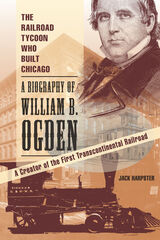 The Railroad Tycoon Who Built Chicago: A Biography of William B. Ogden
Jack Harpster
Southern Illinois University Press, 2009 William Butler Ogden was a pioneer railroad magnate, one of the earliest founders and developers of the city of Chicago, and an important influence on U.S. westward expansion. His career as a businessman stretched from the streets of Chicago to the wilds of the Wisconsin lumber forests, from the iron mines of Pennsylvania to the financial capitals in New York and beyond. Jack Harpster’s The Railroad Tycoon Who Built Chicago: A Biography of William B. Ogden is the first chronicle of one of the most notable figures in nineteenth-century America. Harpster traces the life of Ogden from his early experiences as a boy and young businessman in upstate New York to his migration to Chicago, where he invested in land, canal construction, and steamboat companies. He became Chicago’s first mayor, built the city’s first railway system, and suffered through the Great Chicago Fire. His diverse business interests included real estate, land development, city planning, urban transportation, manufacturing, beer brewing, mining, and banking, to name a few. Harpster, however, does not simply focus on Ogden’s role as business mogul; he delves into the heart and soul of the man himself. The Railroad Tycoon Who Built Chicago is a meticulously researched and nuanced biography set against the backdrop of the historical and societal themes of the nineteenth century. It is a sweeping story about one man’s impact on the birth of commerce in America. Ogden’s private life proves to be as varied and interesting as his public persona, and Harpster weaves the two into a colorful tapestry of a life well and usefully lived.
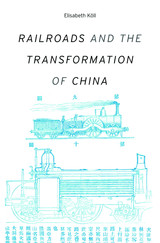 Railroads and the Transformation of China
Elisabeth Köll
Harvard University Press, 2019 As a vehicle to convey both the history of modern China and the complex forces still driving the nation’s economic success, rail has no equal. Railroads and the Transformation of China is the first comprehensive history, in any language, of railroad operation from the last decades of the Qing Empire to the present.
China’s first fractured lines were built under semicolonial conditions by competing foreign investors. The national system that began taking shape in the 1910s suffered all the ills of the country at large: warlordism and Japanese invasion, Chinese partisan sabotage, the Great Leap Forward when lines suffered in the “battle for steel,” and the Cultural Revolution, during which Red Guards were granted free passage to “make revolution” across the country, nearly collapsing the system. Elisabeth Köll’s expansive study shows how railroads survived the rupture of the 1949 Communist revolution and became an enduring model of Chinese infrastructure expansion.
The railroads persisted because they were exemplary bureaucratic institutions. Through detailed archival research and interviews, Köll builds case studies illuminating the strength of rail administration. Pragmatic management, combining central authority and local autonomy, sustained rail organizations amid shifting political and economic priorities. As Köll shows, rail provided a blueprint for the past forty years of ambitious, semipublic business development and remains an essential component of the PRC’s politically charged, technocratic economic model for China’s future.
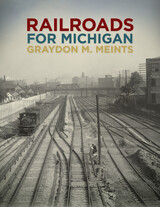 Railroads for Michigan
Graydon M. Meints
Michigan State University Press, 2013 In this thoroughly researched history, Graydon Meints tells the fascinating story of the railroad’s arrival and development in Michigan. An engaging and accessible text, the book describes the long-awaited and often-troubled advent of the railroad in the state, the building of which shifted from private to public efforts and back again, amid tumultuous social, business, and political developments. The railroad would come to play a role in almost every critical event in Michigan’s history, including the Civil War, the Granger Movement, and the Gilded Age, before beginning to wane following the arrival of the automobile, the Interstate Commerce Commission, World War I, and the Great Depression. A brief growth spurt during World War II was short-lived, and it was followed by the collapse of several major railroads and the formation of Amtrak and Conrail. Looking ahead to the future of the railroad in the Great Lakes region, Meints assesses the strengths and shortcomings of this revolutionary invention. With careful attention to the personal impact of the railroad, Meints recognizes in brief biographies the many men and women responsible for the development and operation of Michigan railroads, as well as the triumphs, tragedies, and spaces that shaped their lives and work.
 Railroads in the Heartland: Steam and Traction in the Golden Age of Postcards
H. Roger Grant
University of Iowa Press, 1997 Historians of midwestern railroading during the early part of the twentieth century have generally focused on the production of railroad company histories while ignoring the regional view. Fortunately for railway historians and buffs, coincidentally with the zenith of the Railway Age, the national fad for producing and mailing postcards was at its height. Millions of cards, including "real-photo" images, were produced between 1905 and 1915. Roger Grant has selected more than a hundred representative picture postcards to visualize the principal themes and characteristics that gave this dynamic industry its distinctive regional features. By the turn of the century, the railroad map of the Midwest was unequaled. Anyone who examined it carefully sensed that this was the vital center of America's massive network of steel rails. Depots erected in the western prairie environment were spartan, with only minor decoration, but those in the Midwest usually mirrored more ornate New England styles. These features are often reflected in the images in this heavily illustrated book, which depicts the spare but strong pioneering spirit of the enterprise.
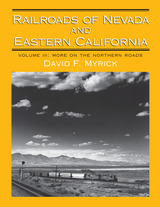 Railroads of Nevada and Eastern California: Volume 3: More on the Northern Roads
David F. Myrick
University of Nevada Press, 2007 Valuable as these volumes are in relation to railroad operations in Nevada and California, their usefulness as authoritative reference sources embraces a much broader scope. Railroads of Nevada and Eastern California is as much a history of the region as it is a study of the railroads. The principal mines and mills and their production are scrupulously detailed, together with the personalities who created them. The final volume in the complete history of Nevada and Eastern California railroads David Myrick's monumental railroad histories have become essential reference works for railroaders, historians, and hobbyists. Volume III contains additional information about the northern roads, including some not covered in previous volumes, and about developments since the publication of the first two volumes in the railroads of the region. It provides new facts gleaned from the correspondence of Collis P. Huntington, one of the builders of the Central Pacific and Southern Pacific railroads. It also covers roads connected with the lumber industry and the construction of electric power plants, and Southern Pacific branch lines, including some that never advanced beyond surveys.
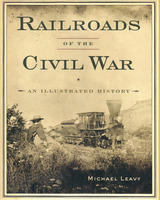 Railroads of the Civil War: An Illustrated History
Michael Leavy
Westholme Publishing, 2010 The Photographic Record of the First Wide-Scale Mechanization of War
Over the course of the first half of the nineteenth century, America would find itself following two increasingly divergent tracks: an industrialized North and an agricultural South. By 1860 railroads were firmly entrenched in our culture, reshaping our cities and steering us through the industrial age towards worldwide prominence. From sleepy post towns to the largest east coast cities, the distant hooting of the locomotive whistle drew ever closer and louder, filling listeners with fascination while brightening the eyes of profit-driven industrialists. But this admirable invention, lavishly adorned in brass and iron trimmings, was about to take on a new and deadly role. America’s regional differences would result in a spectacular collision over slavery, and between 1861–1865, the nation fought a savage war. The “iron horse” became a major weapon in the first war fully dependent on railroads. Moreover railroads would escalate and prolong the war, leading to its terrible carnage. Trains were used to move troops rapidly and over great distances, completely changing military strategy. Trains were also used as mobile artillery, armed with large-caliber cannons that could pound cities and fortifications. Trains were a crucial means for supplying the armies on both sides, and it was the severing of the railway lines providing food and munitions to the Army of Northern Virginia that led to Robert E. Lee’s surrender at Appomattox Court House. In Railroads of the Civil War: An Illustrated History, Michael Leavy uses compelling period photographs and drawings and a rich narrative to reevaluate and illuminate the role of railroads in the Civil War. In addition to identifying details about the various trains and ancillary equipment and buildings in the illustrations, the author explains how trains influenced the outcome of battles and the war in general.
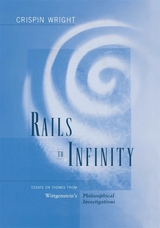 Rails to Infinity: Essays on Themes from Wittgenstein’s Philosophical Investigations
Crispin Wright
Harvard University Press, 2001 This volume, published on the fiftieth anniversary of Wittgenstein's death, brings together thirteen of Crispin Wright's most influential essays on Wittgenstein's later philosophies of language and mind, many hard to obtain, including the first publication of his Whitehead Lectures given at Harvard in 1996.
Organized into four groups, the essays focus on issues about following a rule and the objectivity of meaning; on Saul Kripke's contribution to the interpretation of Wittgenstein; on privacy and self-knowledge; and on aspects of Wittgenstein's philosophy of mathematics. Wright uses the cutting edge of Wittgenstein's thought to expose and undermine the common assumptions in platonistic views of mathematical and logical objectivity and Cartesian ideas about self-knowledge. The great question remains: How to react to the demise of these assumptions? In response, the essays develop a concerted, evolving approach to the possibilities--and limitations--of constructive philosophies of mathematics and mind. Their collection constitutes a major statement by one of Britain's most important philosophers--and will provide an indispensable tool both for students of Wittgenstein and for scholars working more generally in the metaphysics of mind and language.
Rain Forest in Your Kitchen: The Hidden Connection Between Extinction And Your Supermarket
Martin Teitel; Foreword by Jeremy Rifkin
Island Press, 1992 The biodiversity crisis -- the extinction of thousands of species of plants and animals -- is not just a faraway problem for scientists to solve. Instead, the crisis is as close as our backyards, our gardens, and our refrigerator shelves. This engaging, practical guide inspires average Americans to wield their consumer power in favor of protecting the world's plant and animal species. Environmentalist activist Martin Teitel offers compelling evidence that by slightly modifying how we shop, eat, and garden, we can collectively influence the operating decisions of today's corporate agribusiness and help preserve our precious genetic resources. Teitel offers strategies so simple that they require no significant lifestyle change or expense.
 Rain Forest Literatures: Amazonian Texts And Latin American Culture
Lucia Sa
University of Minnesota Press, 2004 Recaptures native literatures of the Amazonian rain forest Native texts of the Amazonian rain forest have been viewed as myth or ethnographic matter—the raw material of literature—rather than as significant works in their own right. But in this unprecedented study, Lúcia Sá approaches indigenous texts as creative works rather than source material. Disclosing the existence and nature of long-standing, rich, and complex Native American literary and intellectual traditions that have typically been neglected or demeaned by literary criticism, Rain Forest Literatures analyzes four indigenous cultural traditions: the Carib, Tupi-Guarani, Upper Rio Negro, and Western Arawak. In each case, Sá considers principal native texts and, where relevant, their publication history. She offers a historical overview of the impact of these texts on mainstream Spanish-American and Brazilian literatures, detailing comparisons with native sources and making close analyses of major instances, such as Mário de Andrade’s classic Macunaima (1928) and Mario Vargas Llosa’s The Storyteller (1986). A redrawing of the lineage of Brazilian and Spanish-American literatures, this book advocates an understanding of the relationships between cultures as a process of “transculturation” rather than “acculturation,” emphasizing the often-ignored impact of the peripheral culture on the one that assumes dominance.
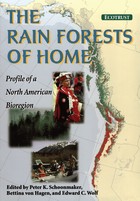 The Rain Forests of Home: Profile Of A North American Bioregion
Edited by Peter K. Schoonmaker, Bettina von Hagen, and Edward C. Wolf; Foreword by Jerry F. Franklin Patricia Marchak
Island Press, 1997 Stretching from the redwoods of California to the vast stands of spruce and hemlock in southeast Alaska, coastal temperate rain forests have been for thousands of years home to one of the highest densities of human settlements on the continent. Given its mild climate, magnificent scenery, and abundant natural resources, the region should continue to support robust economies and vibrant communities for many years to come. However, the well-being of this region is increasingly threatened by diminishing natural capital, declining employment in traditional resource-based industries, and outward migration of young people to cities. The Rain Forests of Home brings together a diverse array of thinkers -- conservationists, community organizers, botanists, anthropologists, zoologists, Native Americans, ecologists, and others -- to present a multilayered, multidimensional portrait of the coastal temperate rain forest and its people. Joining natural and social science perspectives, the book provides readers with a valuable understanding of the region's natural and human history, along with a vision of its future and strategies for realizing that vision. Authors describe the physical setting and examine the geographic and evolutionary forces that have shaped the region since the last glacial period, with individual chapters covering oceanography, climate, geologic processes, vegetation, fauna, streams and rivers, and terrestrial/marine interactions. Three chapters cover the history of human habitation, including an examination of what is known about pre-European settlement, a consideration of the traditions of local and indigenous knowledge, and a description of the environmental and cultural upheaval brought by European explorers and settlers. The book concludes with an exploration of recent economic and cultural trends, regional and local public policy, information gathering, and the need for integrating local knowledge into decision making. Interspersed among the chapters are compelling profiles of community-level initiatives and programs aimed at restoring damaged ecosystems, promoting sustainable use of resources, and fostering community-based economic development. The case studies describe what coastal residents are doing to combine environmental conservation with socioeconomic development, and document some of the most innovative experiments in sustainable development now underway in North America. The Rain Forests of Home offers for the first time a unified description of the characteristics, history, culture, economy, and ecology of the coastal temperate rain forest. It is essential reading for anyone who lives in or cares about the region.
|
|
